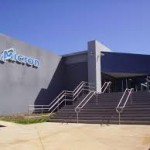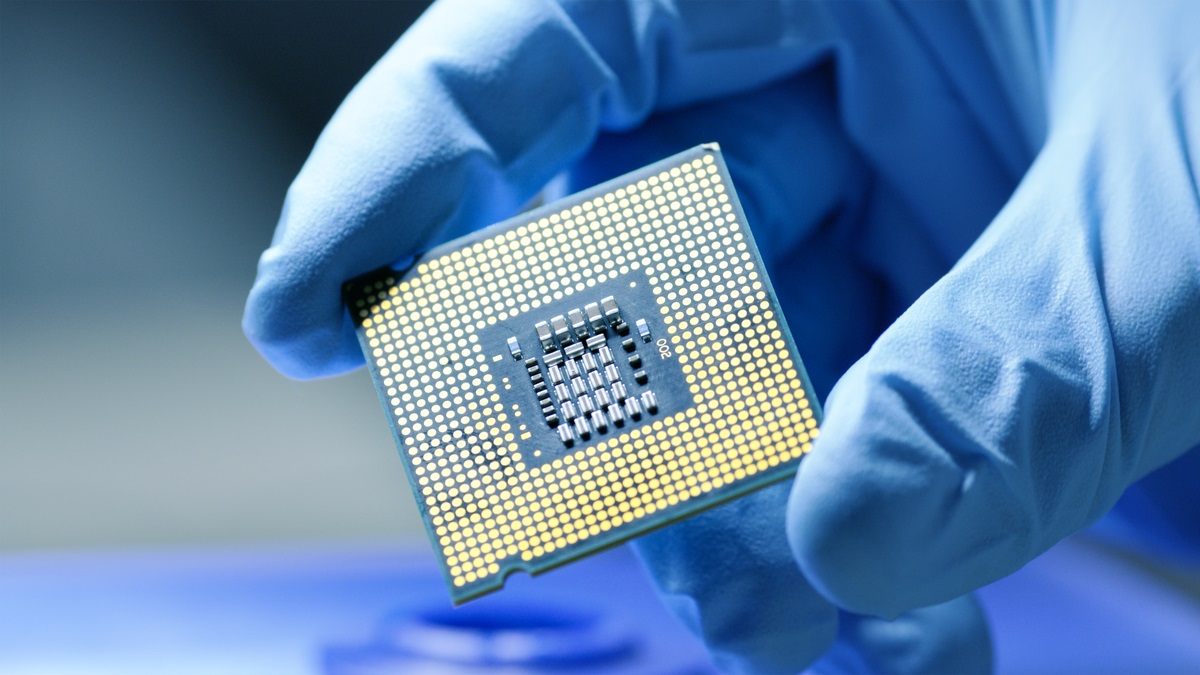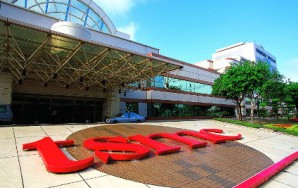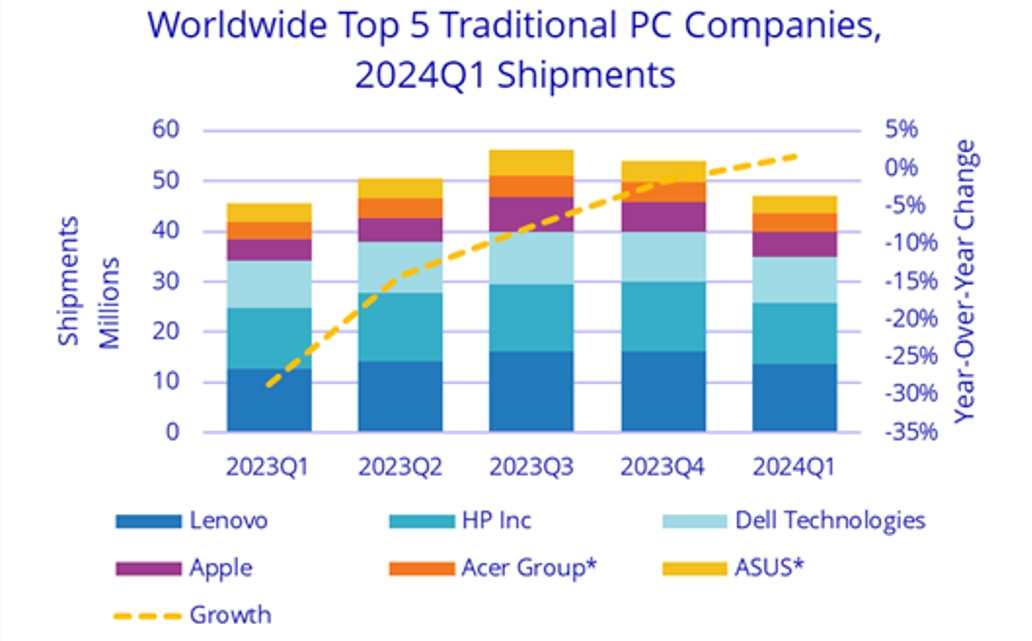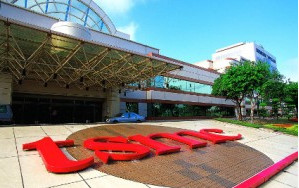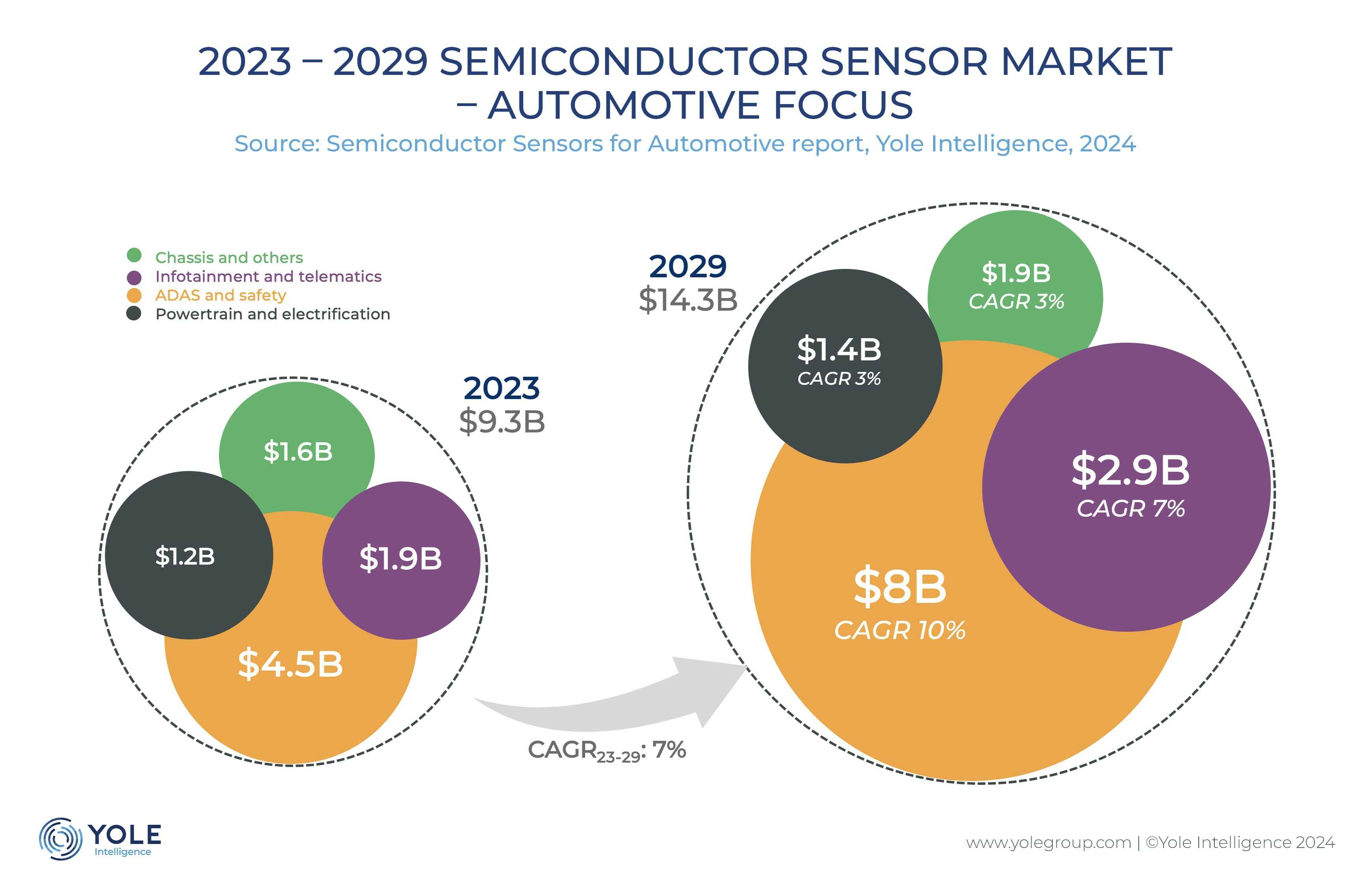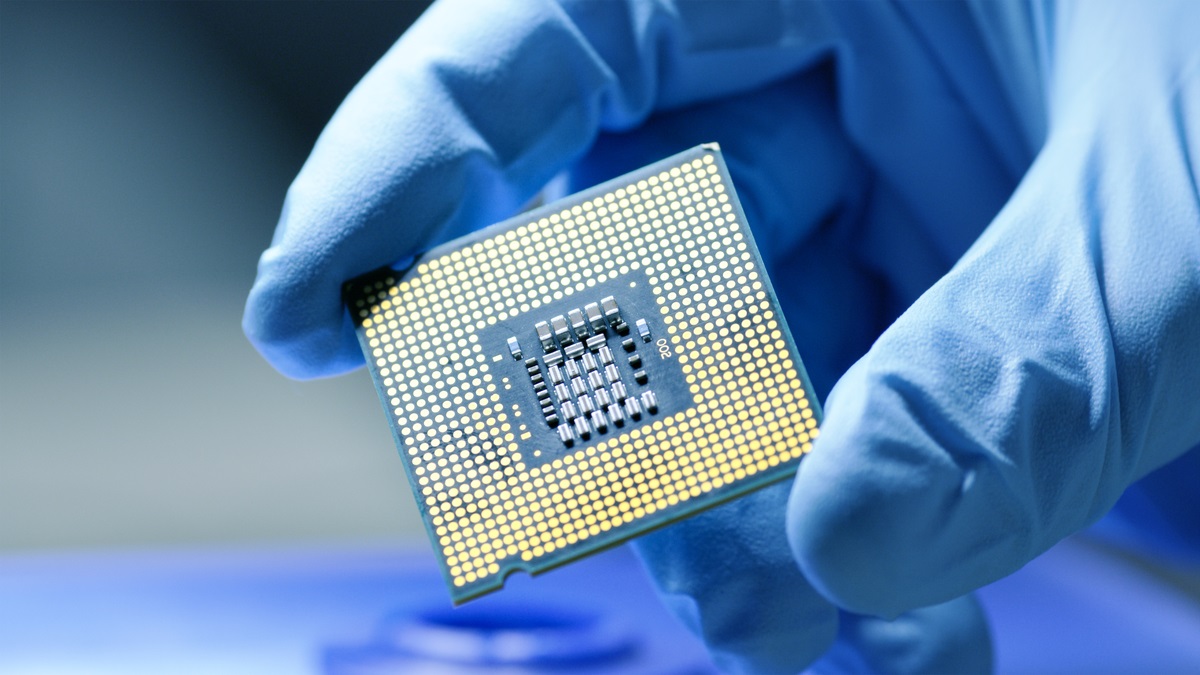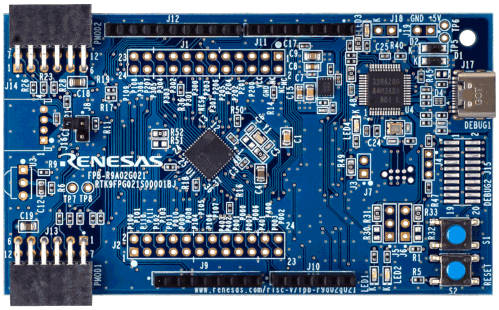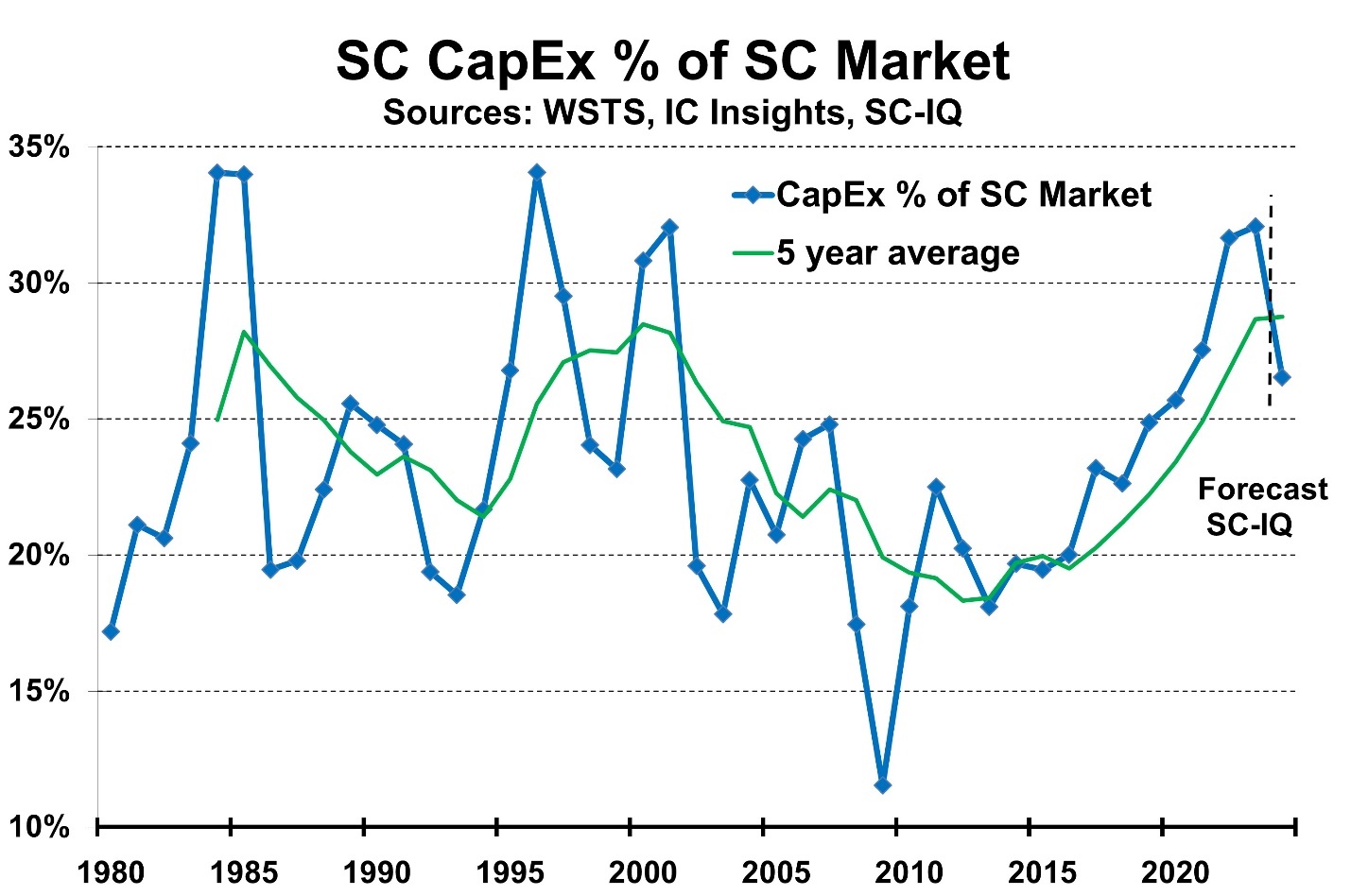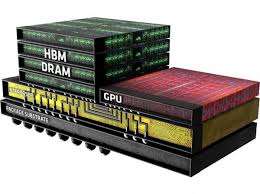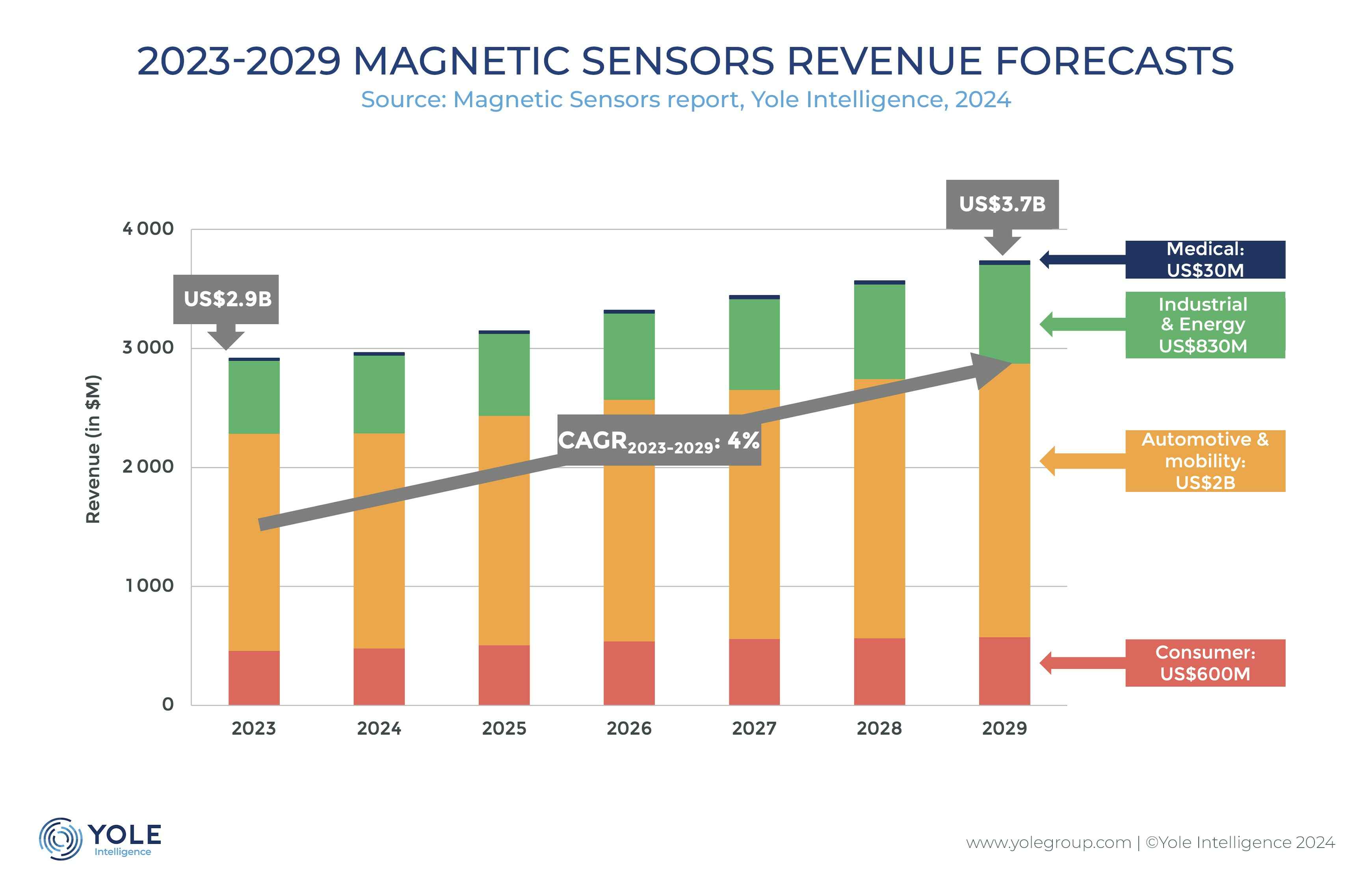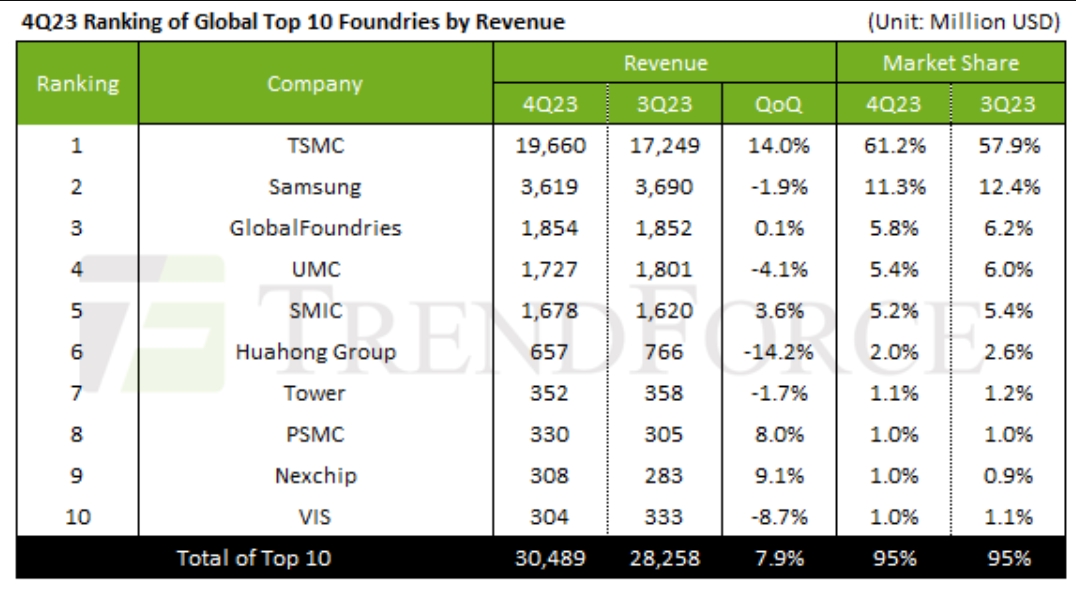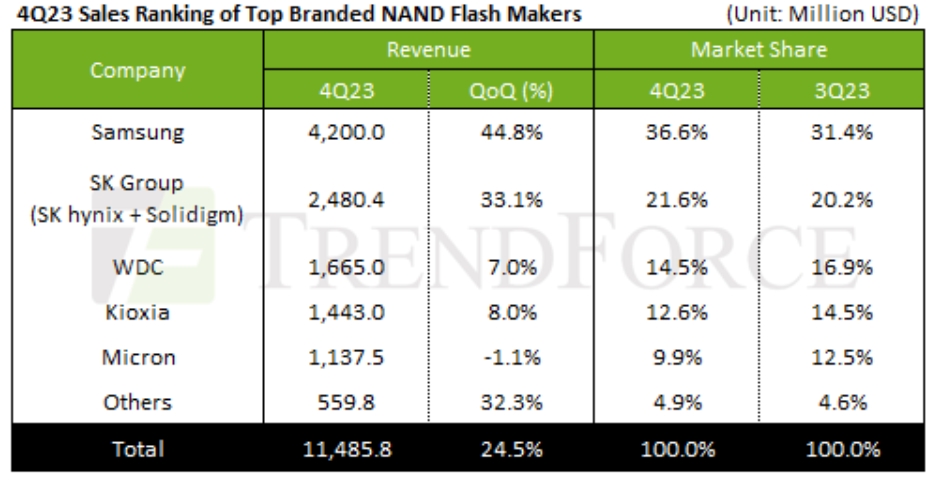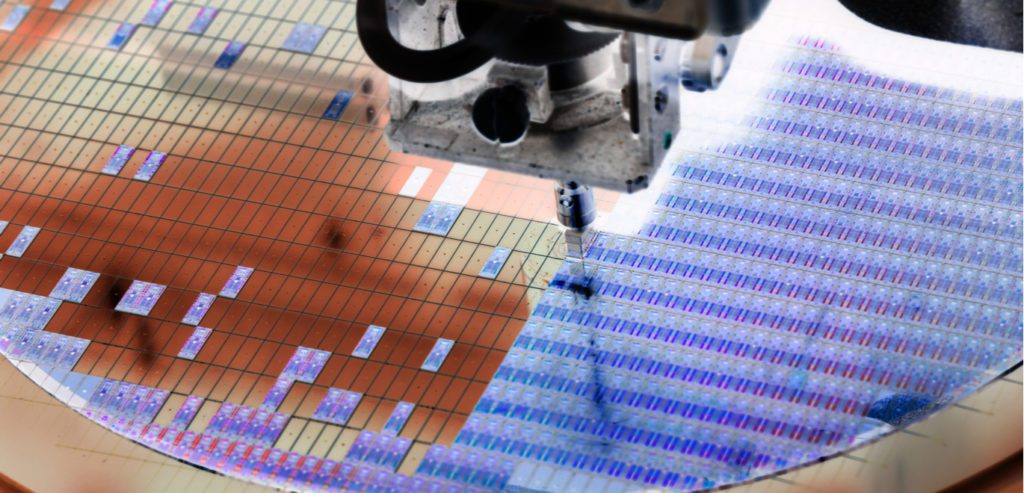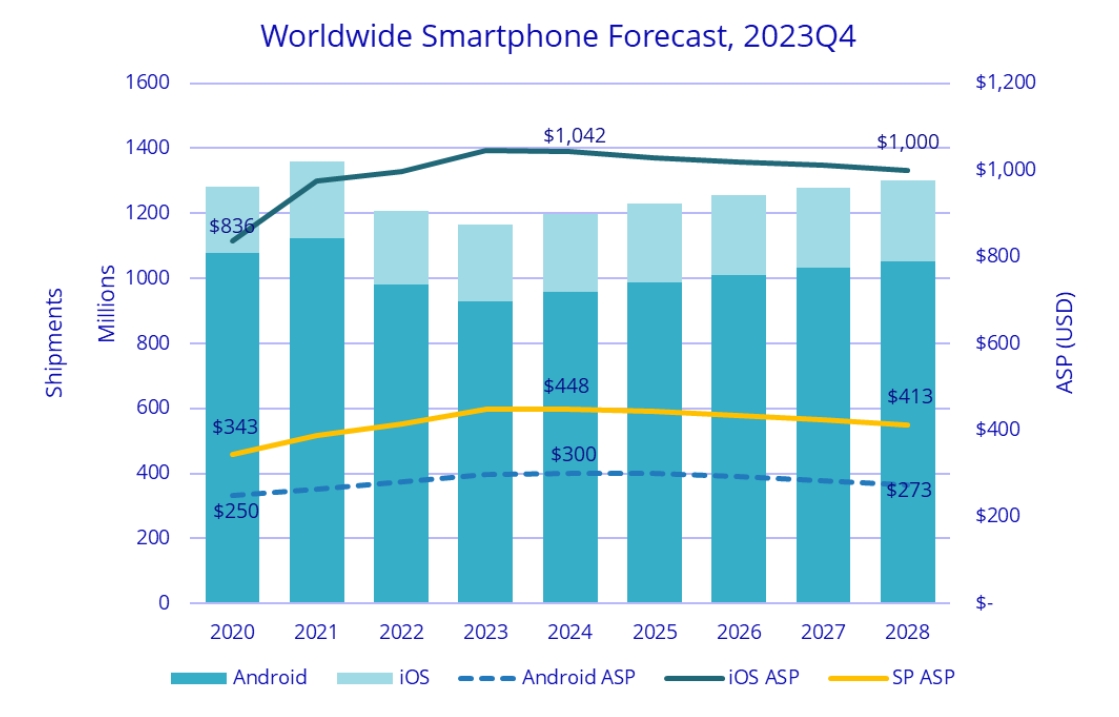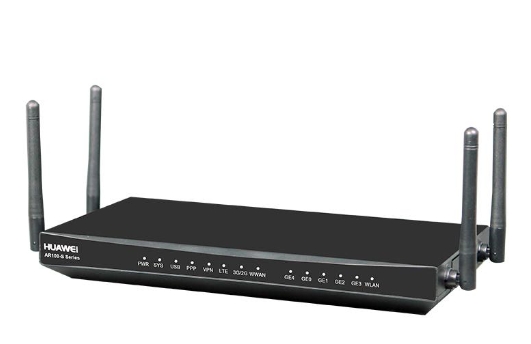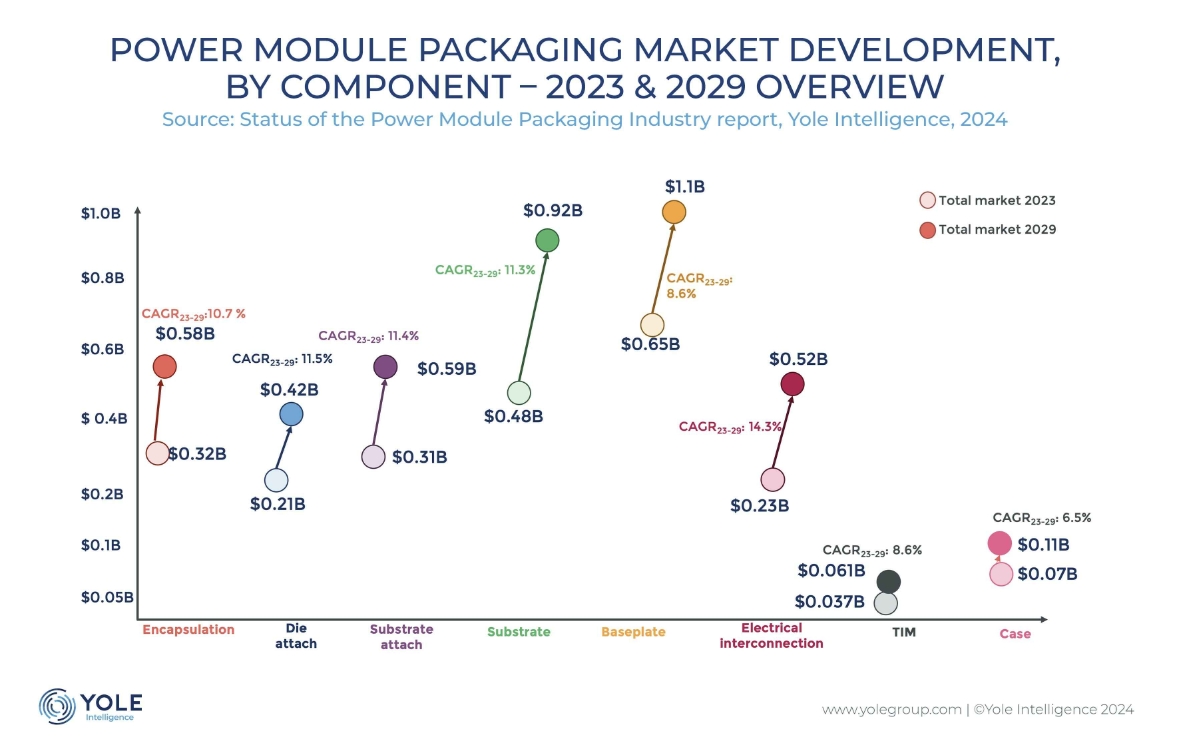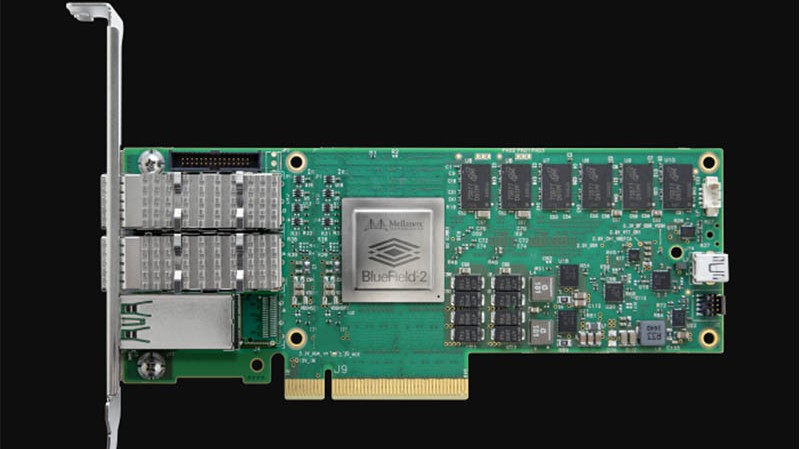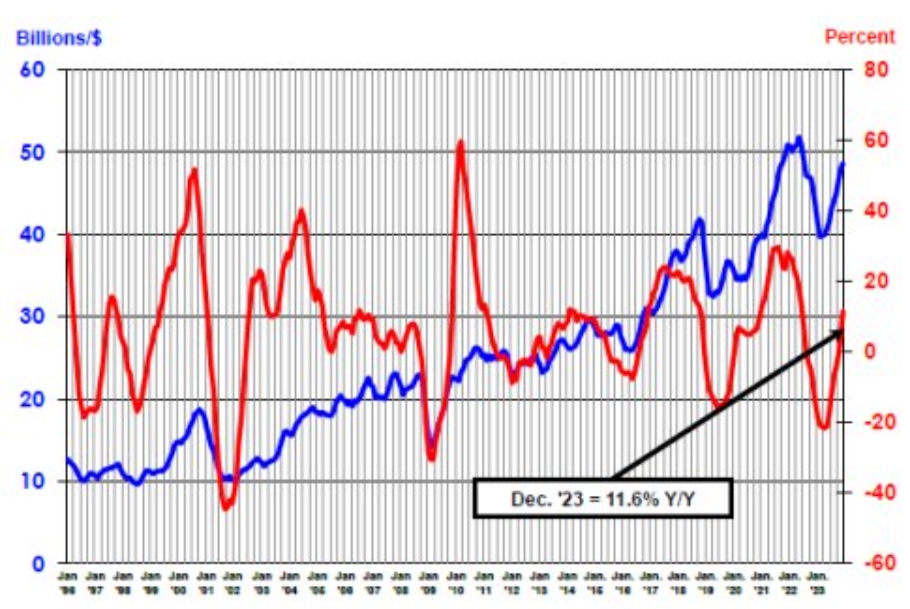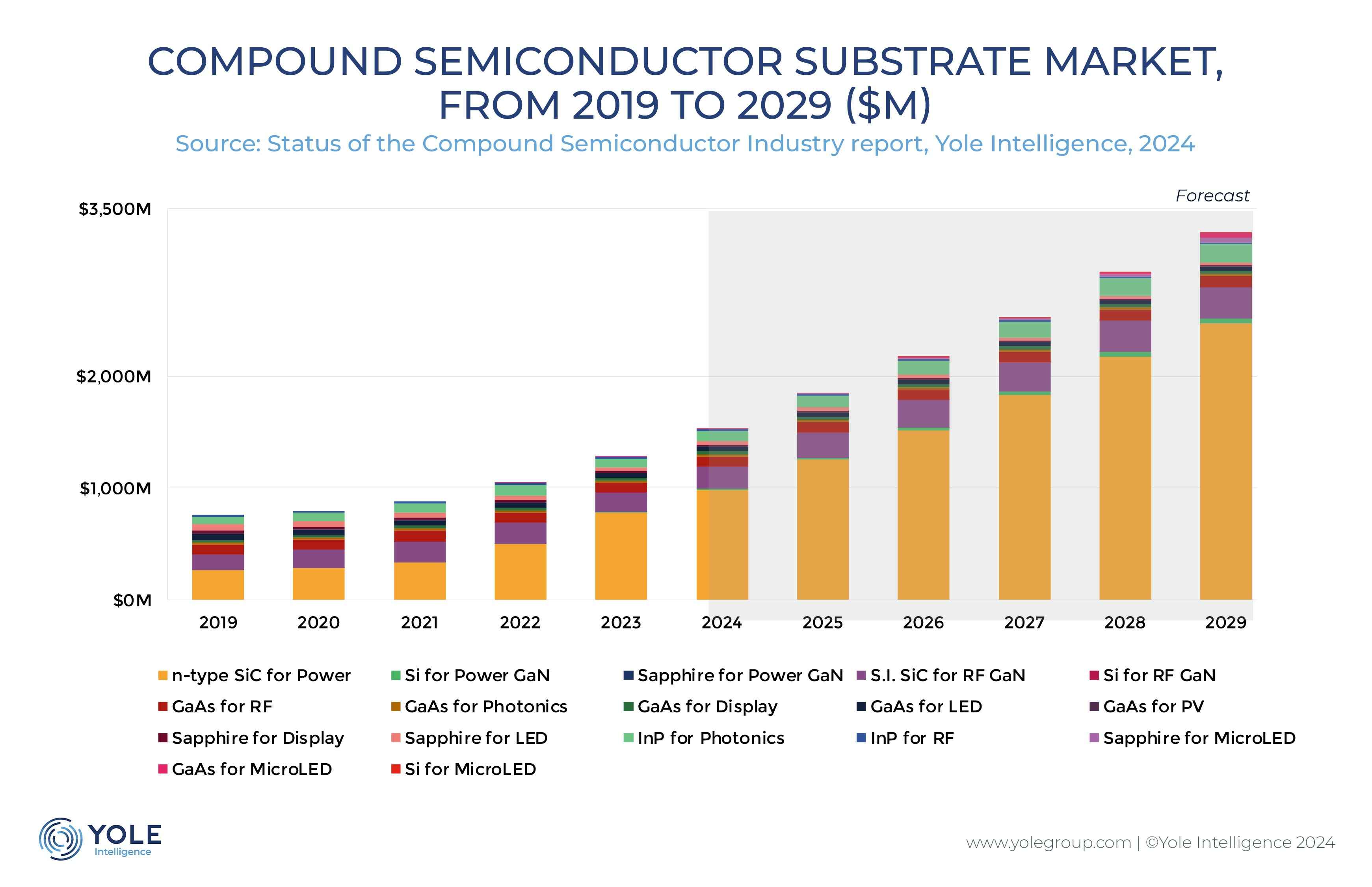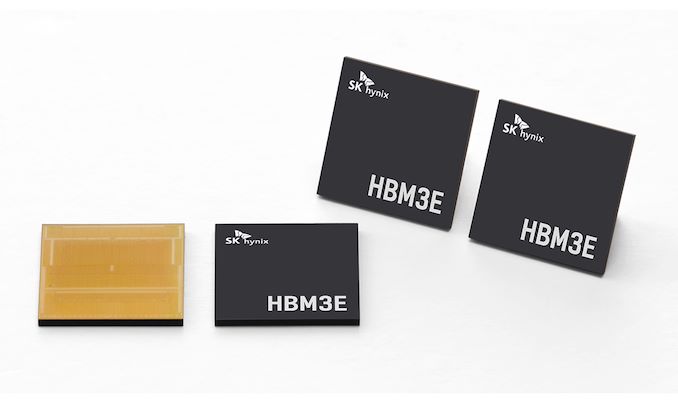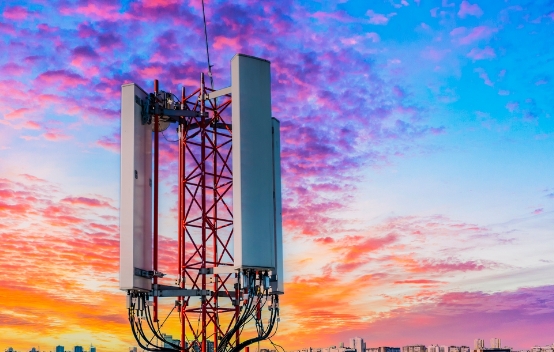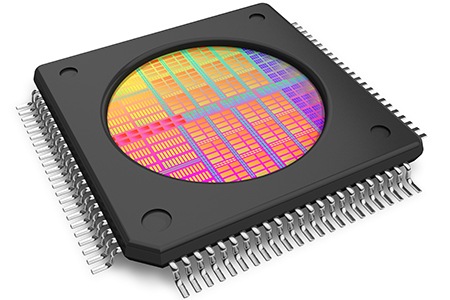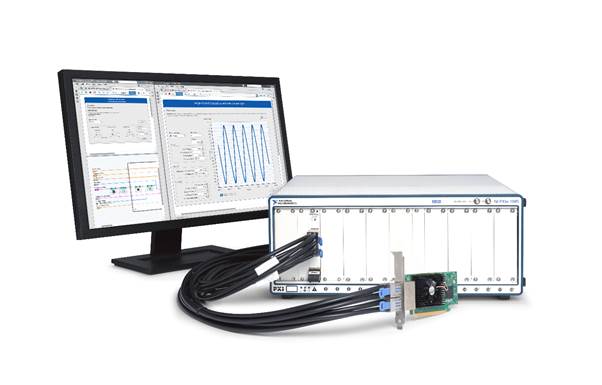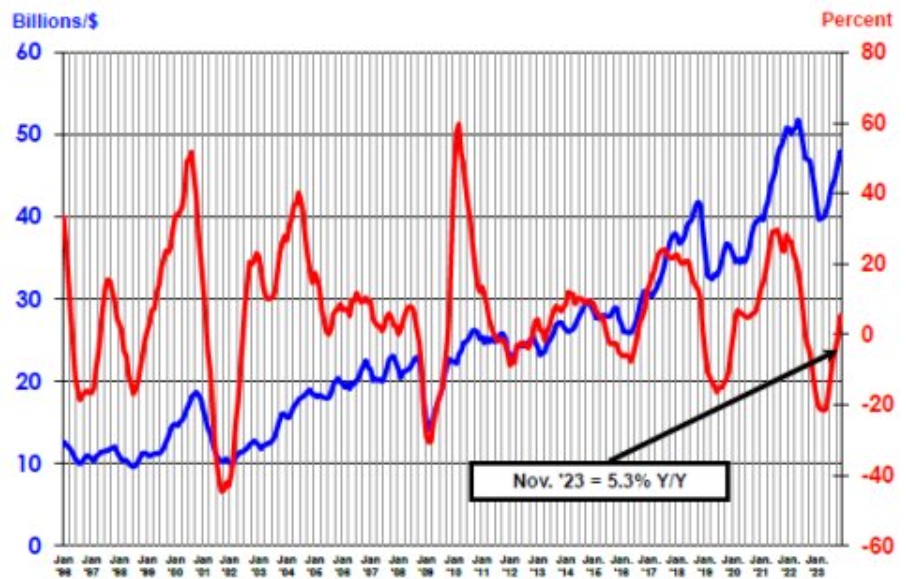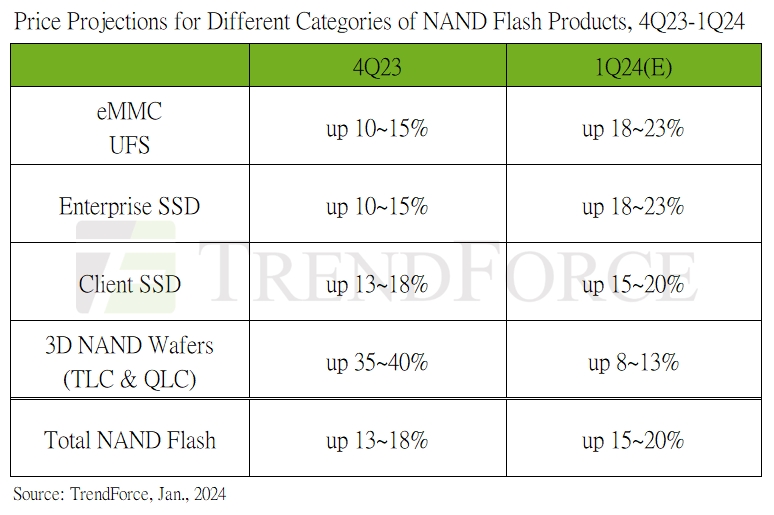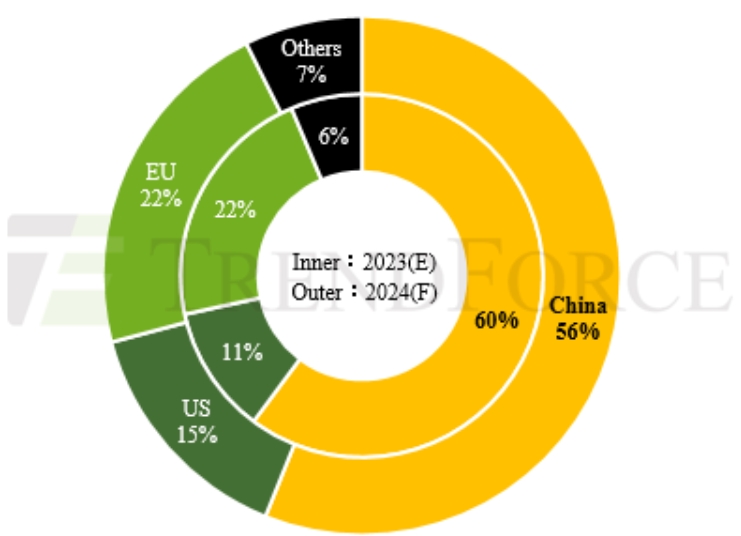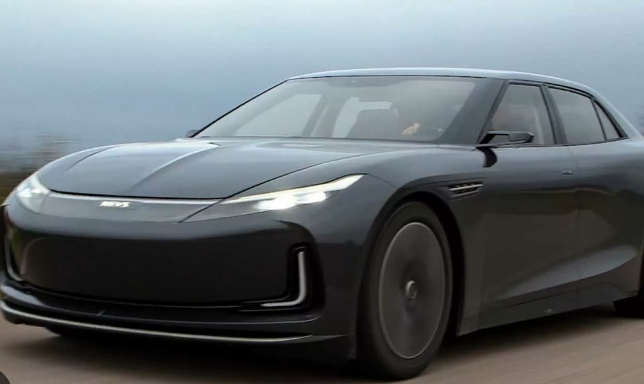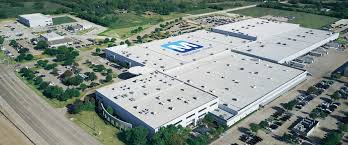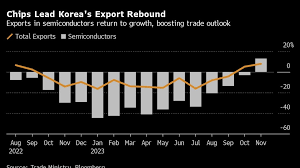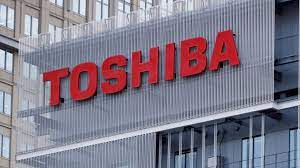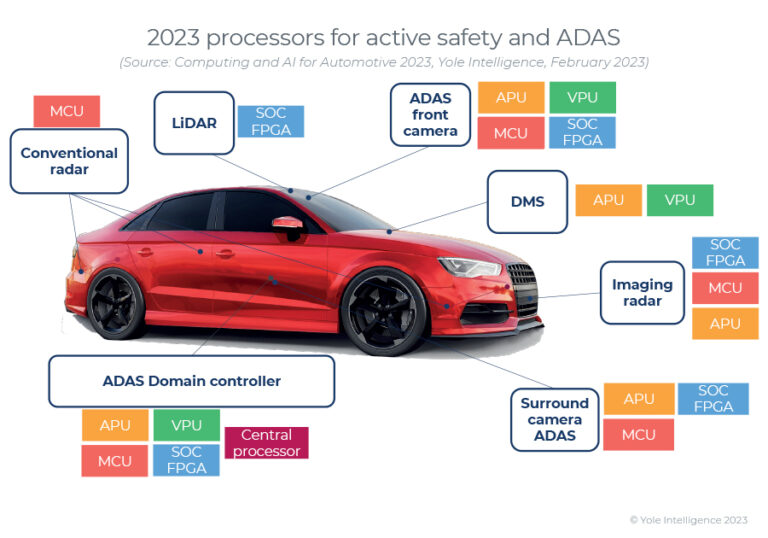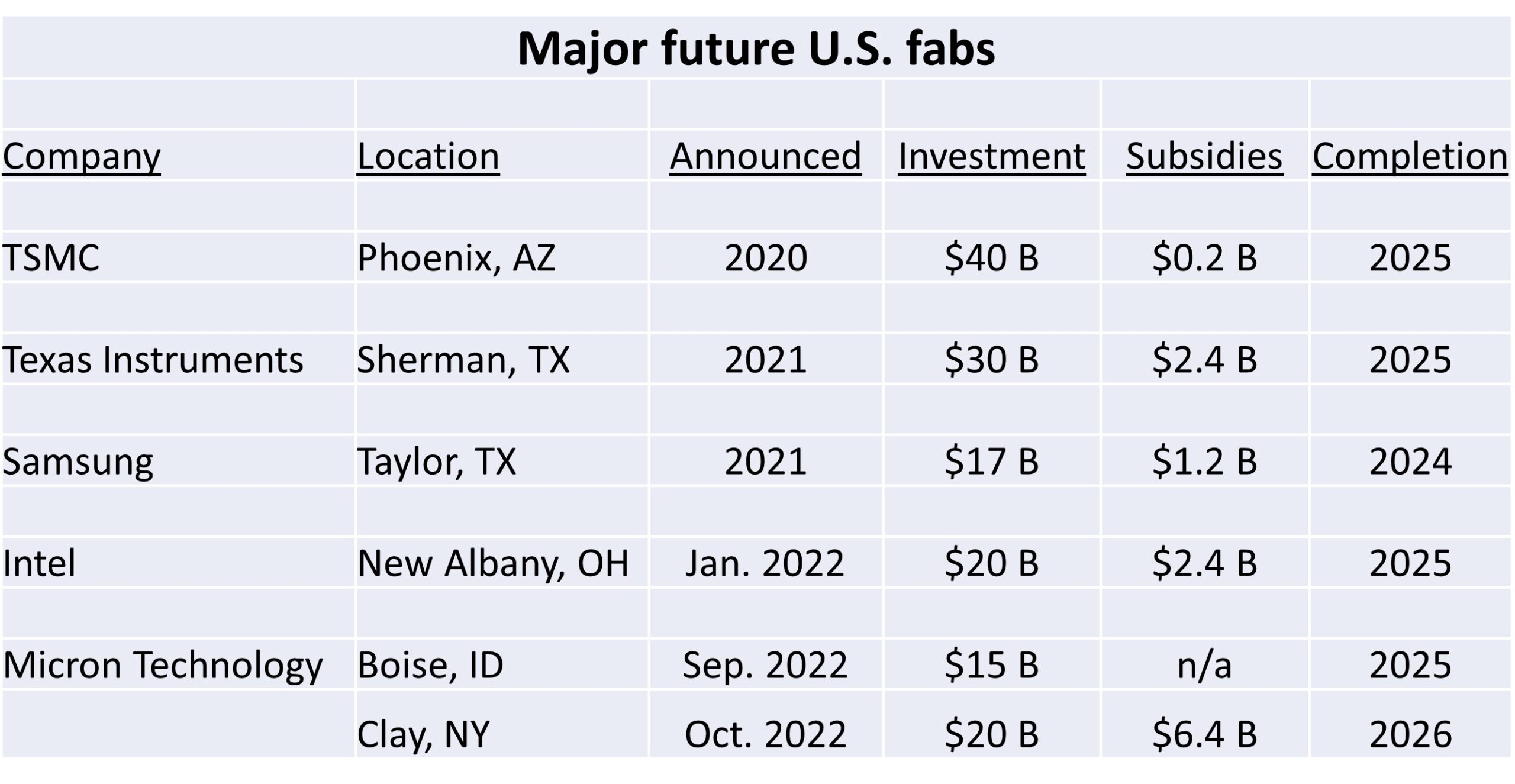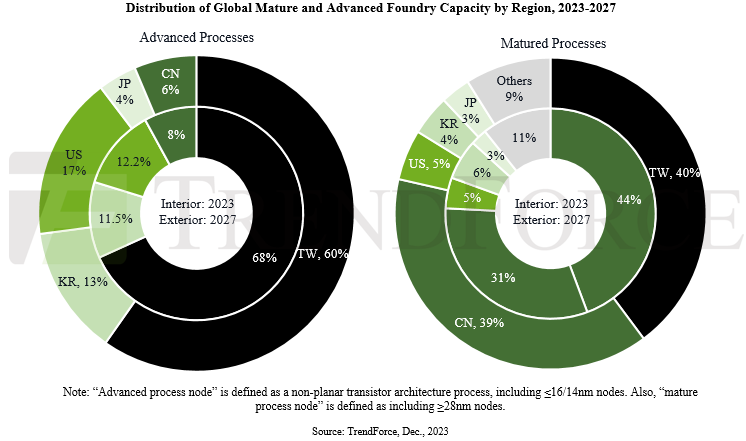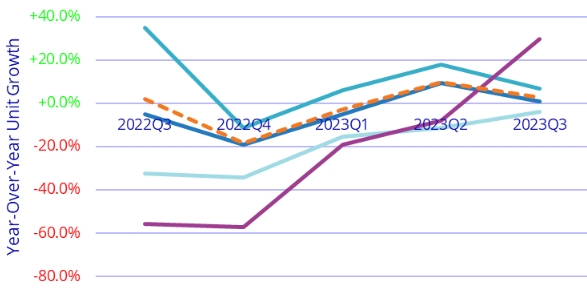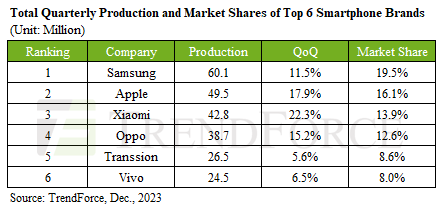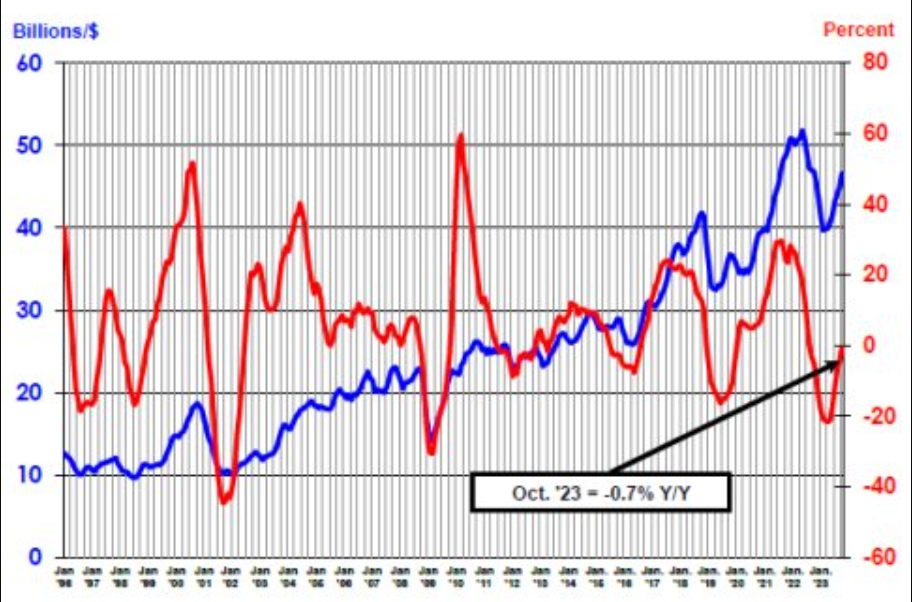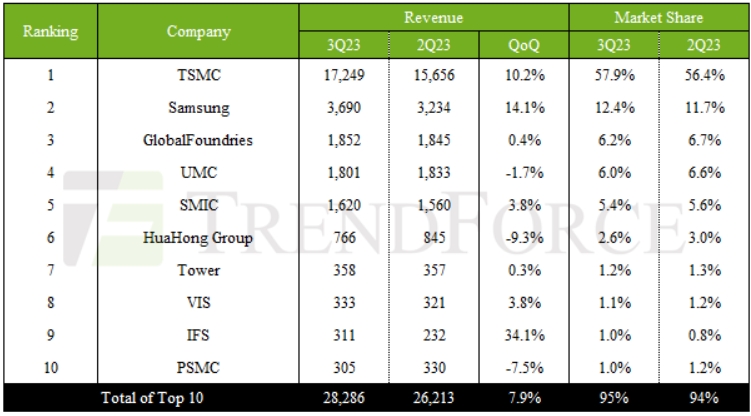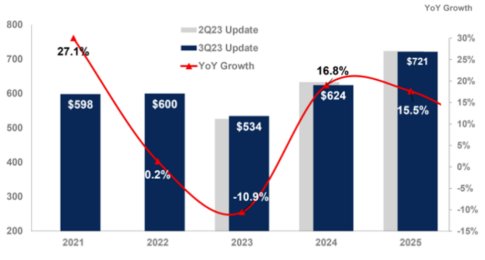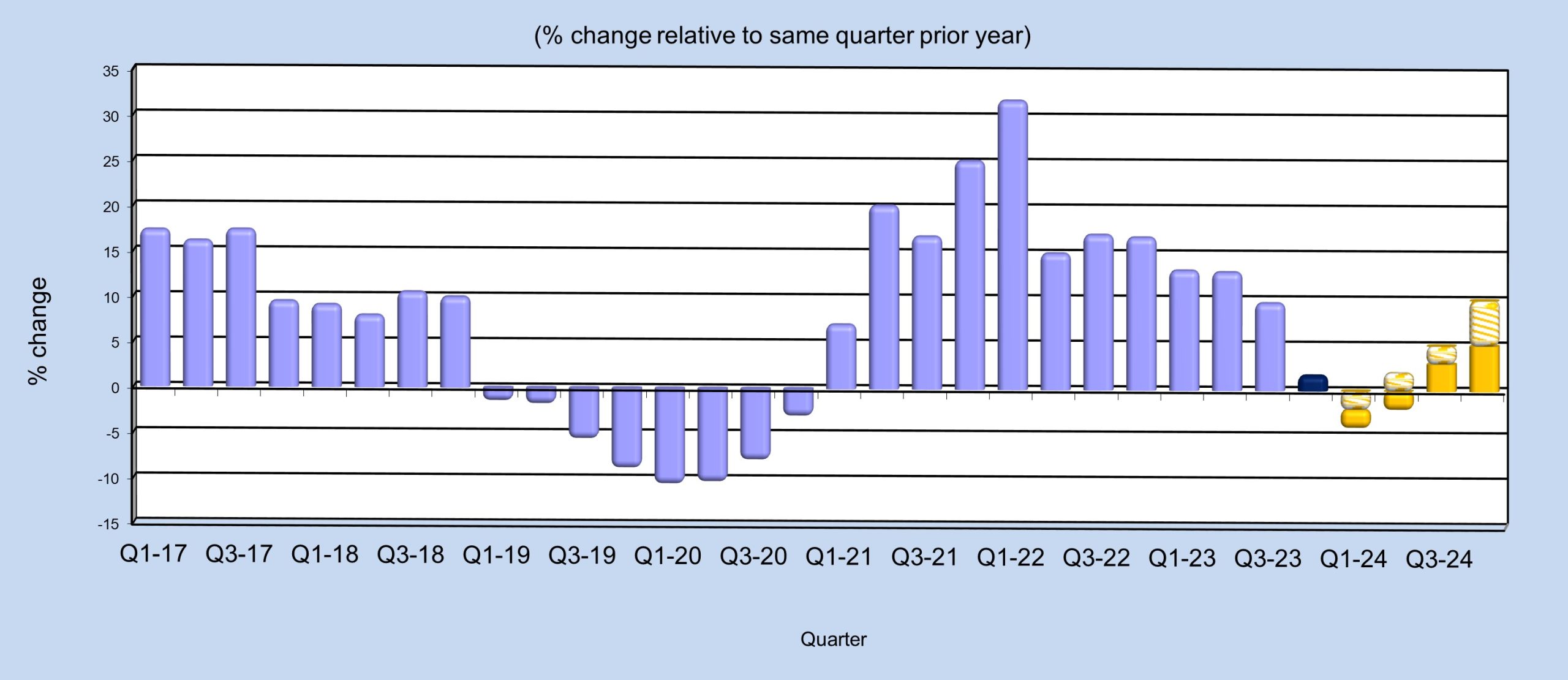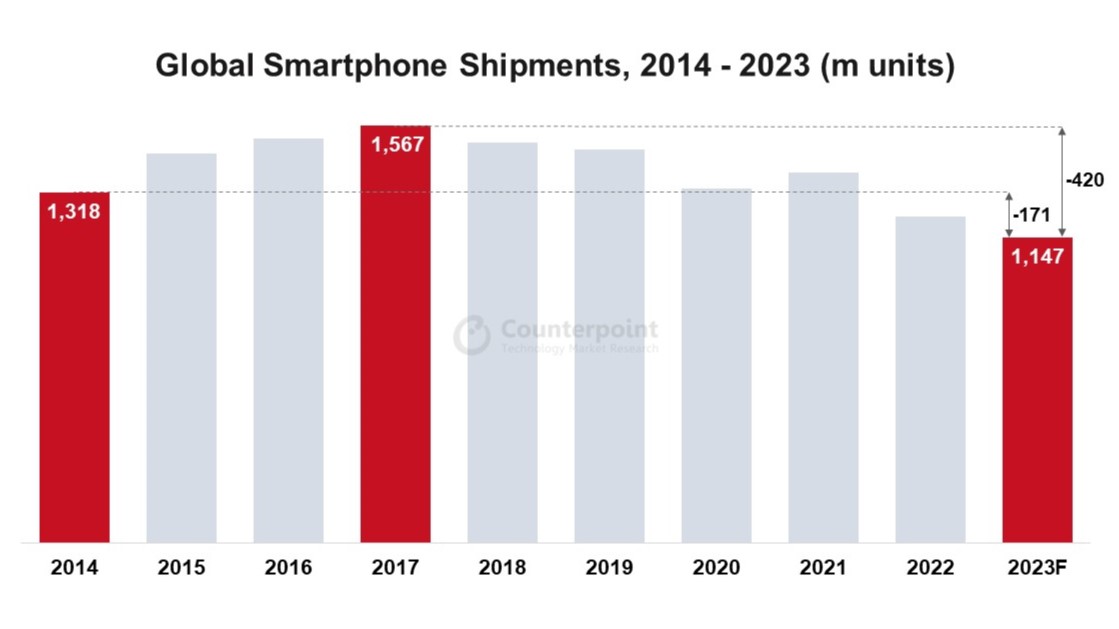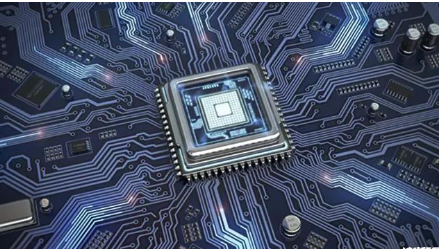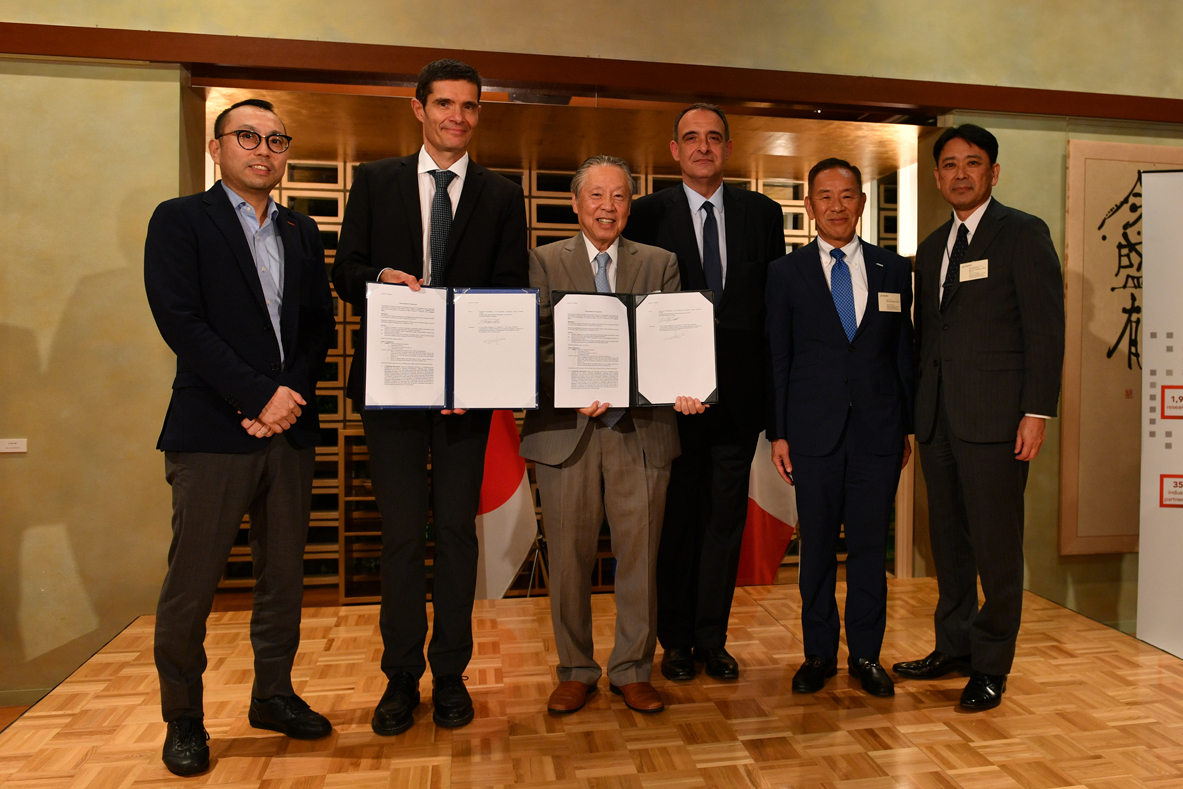572
6
Down quarter for ST
ST had Q1 net revenues down 18.4% y-o-y at $3.47 billion for a gross profit down 31.6% y-o-y at $1.44 billion, a gross margin of 41.7%, an operating margin of 15.9% and net income of $513 million.
Q1 free cash was $134 million after Net Capex of $967 million
For Q2, net revenues of $3.2 billion and gross margin of 40% are expected.
For the full year, revenues of $14-15 billion are expected, down from a previous expectation of $15.9 billion to $16.9 billion.
“Q1 net revenues and gross margin both came in below the midpoint of our business outlook range, driven by lower revenues in Automotive and Industrial, partially offset by higher revenues in Personal Electronics,” said CEO Jean-Marc Chery (pictured) , “on a year-over-year basis, Q1 net revenues decreased 18.4%, operating margin decreased to 15.9% from 28.3% and net income decreased 50.9% to $513 million.”
“During the quarter, Automotive semiconductor demand slowed down compared to our expectations, entering a deceleration phase, while the ongoing Industrial correction accelerated,” added Chery, “our second quarter business outlook, at the mid-point, is for net revenues of $3.2 billion, decreasing year-over-year by 26.0% and decreasing sequentially by 7.6%; gross margin is expected to be about 40%.”
“We will now drive the Company based on a revised plan for FY24 revenues in the range of $14 billion to $15 billion. Within this plan, we expect a gross margin in the low 40’s,” said Chery, “we plan to maintain our Net Capex plan for FY24 at about $2.5 billion focusing on our strategic manufacturing initiatives.”
Quarterly Financial Summary (U.S. GAAP)


Net revenues totalled $3.47 billion, representing a year-over-year decrease of 18.4%. Year-over-year net sales to OEMs and Distribution decreased 11.5% and 30.8%, respectively. On a sequential basis, net revenues decreased 19.1%, 320 basis points lower than the mid-point of ST’s guidance.
Gross profit totaled $1.44 billion, representing a year-over-year decrease of 31.6%. Gross margin of 41.7%, 60 basis points below the mid-point of ST’s guidance, decreased 800 basis points year-over-year, mainly due to the combination of sales price and product mix, unused capacity charges and reduced manufacturing efficiencies.
Operating income decreased 54.1% to $551 million, compared to $1.20 billion in the year-ago quarter. ST’s operating margin decreased 1,240 basis points on a year-over-year basis to 15.9% of net revenues, compared to 28.3% in the first quarter of 2023.
Jayce
/include/upload/kind/image/20240425/20240425181801_7750.png
ST had Q1 net revenues down 18.4% y-o-y at $3.47 billion for a gross profit down 31.6% y-o-y at $1.44 billion, a gross margin of 41.7%, an operating margin of 15.9% and net income of $513 million.
Q1 free cash was $134 million
2024/4/25 18:18:04
2024/4/25 18:18:04
0
0
571
6
Samsung in mass production of 286-layer NAND; next comes 400 layer
Samsung is in mass production of its 9th gen, 286-layer, 1Tbit, TLC NAND flash memory and says the 10th gen will have 400 layers.
Compared with the 236-layer 8th gen memory, the 286-layer device increases bit density by 50%, data input and output speeds by 33% and reduces power consumption by 10%.
Innovations include cell interference avoidance and cell life extension and eliminating dummy channel holes has significantly reduced the planar area of the memory cells.
Samsung’s “channel hole etching” technology creates electron pathways by stacking mold layers and maximises fabrication productivity as it enables simultaneous drilling of the industry’s highest cell layer count in a double-stack structure.
As the number of cell layers increase, the ability to pierce through higher cell numbers becomes essential, demanding more sophisticated etching techniques.
The 9th-generation V-NAND is equipped with the Toggle 5.1 interface which supports increased data input/output speeds by 33% to up to 3.2 Gbps.
Jayce
/include/upload/kind/image/20240424/20240424175508_3647.jpeg
Samsung is in mass production of its 9th gen, 286-layer, 1Tbit, TLC NAND flash memory and says the 10th gen will have 400 layers.
Compared with the 236-layer 8th gen memory, the 286-layer device increases bit density by 50%, data inp
2024/4/24 17:55:37
2024/4/24 17:55:37
1
0
570
6
Micron to get $6.1bn in Chips Act money
Micron will get $6.1 billion in US Chips Act grants to help build fabs in New York and Idaho.
Senator Chuck Schumer of New York announced the award and said the money would go towards building two fabs in New York by 2030 and one in Idaho.
US President Joe Biden is expected to make an announcement about the award on Thursday when he visits Syracuse, New York.
Syracuse is where Micron has said it intends to build up to four fabs over the next two decades at a cost of $100 billion.
Last week New York Governor Kathy Hochul said funding from the Chips Act would secure a $100 billion investment in the state.
Major Chips Act awards have now gone to Intel, TSMC, Samsung and Micron. In addition to the grants, the firms qualify for a 25% tax credit on the cost of building fabs.
Jayce
/include/upload/kind/image/20240423/20240423175118_8256.jpg
Micron will get $6.1 billion in US Chips Act grants to help build fabs in New York and Idaho.
Senator Chuck Schumer of New York announced the award and said the money would go towards building two fabs in New York by 2030 and o
2024/4/23 17:51:35
2024/4/23 17:51:35
2
0
569
5
Flyking Weekly Industry Express
Jayce
/include/upload/kind/image/20240422/20240422173954_4743.jpg
2024/4/22 17:40:15
2024/4/22 17:40:15
8
0
568
6
TSMC Q1 Profit Up 8.9%
Earlier today TSMC announced Q1 revenue up 12.9% y-o-y at $18.87 billion and profit up 8.9% y-o-y at $6.96 billion.
Compared to Q4, the Q1 revenue was down 5.3% and net income was down 5.5%.
Gross margin for the quarter was 53.1%, operating margin was 42.0%, and net profit margin was 38.0%.
In Q1, shipments of 3-nanometer accounted for 9% of total wafer revenue; 5-nanometer accounted for 37%; 7-nanometer accounted for 19%.
Advanced technologies, defined as 7-nanometer and more advanced technologies, accounted for 65% of total wafer revenue
Jayce
/include/upload/kind/image/20240418/20240418220445_3569.jpg
Earlier today TSMC announced Q1 revenue up 12.9% y-o-y at $18.87 billion and profit up 8.9% y-o-y at $6.96 billion.
Compared to Q4, the Q1 revenue was down 5.3% and net income was down 5.5%.
Gross margin for the
2024/4/18 22:05:14
2024/4/18 22:05:14
5
0
567
6
Apple Loses Phone Crown as Q1 Market Grows 7.8%
The Q1 smartphone market grew 7.8% q-o-q to 289.4 million units, says IDC. It was the third consecutive quarter of market growth,
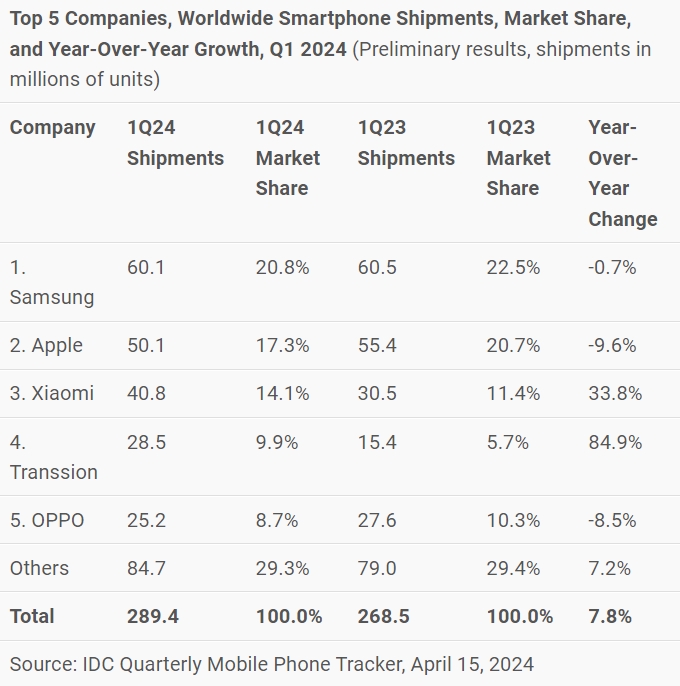
Notes:
? Data are preliminary and subject to change.
-
Company shipments are branded device shipments and exclude OEM sales for all vendors.
-
The “Company” represents the current parent company (or holding company) for all brands owned and operated as a subsidiary.
-
Figures represent new shipments only and exclude refurbished units.
Jayce
/include/upload/kind/image/20240416/20240416174142_5644.jpg
The Q1 smartphone market grew 7.8% q-o-q to 289.4 million units, says IDC. It was the third consecutive quarter of market growth,
Notes:
• Data are preliminary and subject to change.
2024/4/16 17:42:41
2024/4/16 17:42:41
9
0
566
5
Flyking Weekly Industry Express
Jayce
/include/upload/kind/image/20240415/20240415173854_3551.jpg
2024/4/15 17:39:52
2024/4/15 17:39:52
20
0
565
6
Semi Manufacturing Equipment Sales Fell 1.3% Last Year, Says SEMI.
2023 sales of semiconductor manufacturing equipment fell 1.3% to $106.3 billion from 2022’s record $107.6 billion, says SEMI.
China was the biggest market, growing 29% y-o-y to $36.6 billion, followed by Korea which fell 7% to $19.9 billion and Taiwan which fell 27% to $19.6 billion.
The US market rose 15%, the EU fell 3%, Japan fell 5% and RoW fell 39%.
“Despite a slight dip in global equipment sales, the semiconductor industry continues to show strength, with strategic investments fueling growths in key regions,” says SEMI CEO Ajit Manocha, “the overall results for the year were better than anticipated by most industry followers.”
Wafer processing equipment sales rose 1%, other front-end segment billings increased by 10%, assembly and packaging equipment fell 30% and test equipment fell 17%.
Jayce
/include/upload/kind/image/20240412/20240412175142_3554.jpg
2023 sales of semiconductor manufacturing equipment fell 1.3% to $106.3 billion from 2022’s record $107.6 billion, says SEMI.
China was the biggest market, growing 29% y-o-y to $36.6 billion, followed by Korea whi
2024/4/12 17:52:08
2024/4/12 17:52:08
12
0
564
6
TSMC Q1 Up 16.5% Y-o-Y
TSMC had Q1 revenue up 16.5% y-o-y at $18.54 billion up from $16.72 billion Q1 2023.
For March, TSMC had revenues that were 34.3% up y-o-y and 7.5% up m-o-m at $6.2 billion.
It was the biggest m-o-m rise since November 2022.

Jayce
/include/upload/kind/image/20240411/20240411171106_4468.jpg
TSMC had Q1 revenue up 16.5% y-o-y at $18.54 billion up from $16.72 billion Q1 2023.
For March, TSMC had revenues that were 34.3% up y-o-y and 7.5% up m-o-m at $6.2 billion.
It was the biggest m-o-m rise since Nove
2024/4/11 17:12:24
2024/4/11 17:12:24
14
0
563
6
PC Shipments Back to Pre-Covid Levels
After two years of decline, the worldwide traditional PC market returned to growth during the first quarter of 2024 (1Q24) with 59.8 million shipments, growing 1.5% year over year, according to IDC
RECOMMENDED ARTICLESHMI claims smallest SIM card level translatorNordic into tracking with GoogleCurren steps down as CEO of SondrelTSMC gets $11.6bn funding and ups US spend to $65bnIn Q1 2023, the market declined 28.7% – the biggest drop in PC history.
In Q1 2024, global PC shipments finally returned to pre-pandemic levels as volumes rivaled those seen in 1Q19 when 60.5 million units were shipped.
With inflation numbers trending down, PC shipments have begun to recover in most regions, leading to growth in the Americas as well as Europe, the Middle East, and Africa (EMEA). However, the deflationary pressures in China directly impacted the global PC market.
As the largest consumer of desktop PCs, weak demand in China led to yet another quarter of declines for global desktop shipments, which already faced pressure from notebooks as the preferred form factor.
“Despite China’s struggles, the recovery is expected to continue in 2024 as newer AI PCs hit shelves later this year and as commercial buyers begin refreshing the PCs that were purchased during the pandemic,” says IDC’s Jitesh Ubrani.
Among the top 5 companies, Lenovo once again held the top spot and outgrew the market largely due to the steep decline in shipments experienced in 1Q23.
Apple’s strong growth was also due to an outsized decline in the prior year.

Notes:
* IDC declares a statistical tie in the Personal Computing Device market when there is a difference of one tenth of one percent (0.1%) or less in the shipment shares among two or more vendors.
-
Traditional PCs include Desktops, Notebooks, and Workstations and do not include Tablets or x86 Servers. Detachable Tablets and Slate Tablets are part of the Personal Computing Device Tracker but are not addressed in this press release.
-
Shipments include shipments to distribution channels or end users. OEM sales are counted under the company/brand under which they are sold.
Jayce
/include/upload/kind/image/20240409/20240409180932_6610.png
After two years of decline, the worldwide traditional PC market returned to growth during the first quarter of 2024 (1Q24) with 59.8 million shipments, growing 1.5% year over year, according to IDC
RECOMMENDED ARTICLESHMI claim
2024/4/9 18:11:11
2024/4/9 18:11:11
16
0
562
5
Flyking Weekly Industry Express
Jayce
/include/upload/kind/image/20240408/20240408170139_9600.jpg
2024/4/8 17:02:26
2024/4/8 17:02:26
19
0
561
6
TSMC Hit by Quake
Earlier today, TSMC evacuated some of its fabs in Taiwan after an earthquake and is evaluating the loss of production.
“TSMC’s safety systems are operating normally,” says the company, “to ensure the safety of personnel, some fabs were evacuated according to company procedure. We are currently confirming the details of the impact.”
TSMC said construction sites were normal upon initial inspection, but the company decided to suspend work at the sites for the day.
Staff evacuated from some plants have started to return to work.
The earthquake measured 7.4 on the Richter Scale – the worst quake Taiwan has suffered for 25 years.
Jayce
/include/upload/kind/image/20240403/20240403181726_4570.jpg
Earlier today, TSMC evacuated some of its fabs in Taiwan after an earthquake and is evaluating the loss of production.
“TSMC’s safety systems are operating normally,” says the company, “to ensure the safety of personnel, some fab
2024/4/3 18:17:27
2024/4/3 18:17:27
19
0
560
6
Sensor Market Soaring
Sensors for electrification and ADAS are showing remarkably strong growth between 2019 and 2029, with 24% and 17% CAGR, respectively, reports Yole Developpement.
6.5 billion semiconductor sensors for automotive applications were shipped last year generating revenue of $9.3 billion and demand is pointing to a 9 billion unit market with revenue of $14.3 billion by 2029 at a 7% CAGR between 2023 and 2029.
“The upcoming years are poised to witness a dynamic transformation in automotive sensor technology driven by advancements in ADAS, autonomous driving, electrification, and the widespread adoption of sensors across global car fleets,” says Yole’s Pierrick Boulay, “consequently, substantial reorganization within the industry and its supply chain is anticipated.”
The biggest segments are radars and CIS, with more than $4 billion and more than $3 billion, respectively, in 2029. LiDARs will have the biggest growth at 48% to $649 million during the 2019-29 period.
Bosch, leads the market due to strong revenue in MEMS (pressure, accelerometer, IMU) and radar.
During these coming years, the automotive industry is expected to go through massive transformations in all four car domains:
In powertrain and electrification, the automotive industry is transitioning from cars based on internal combustion engines (ICE) to electrified cars, which are expected to represent 43% of production in 2029.
In terms of sensors, this segment will grow with a 3% CAGR between 2023 and 2029. In the long term, the electrification of cars will induce critical changes in the sensor landscape by giving birth to new applications while removing others.

In the ADAS and safety segment, cars are becoming more intelligent, enhancing safety while driving autonomously. Revenue is by far the largest of all segments and Yole forecasts about $8 billion in revenue by 2029.
Infotainment and telematics: with customers demanding greater entertainment options for both drivers and passengers, this sector is projected to achieve a favorable 7% CAGR from 2023 to 2029. This segment should exceed $2.9 billion by 2029.
In the chassis domain, OEMs strive to improve passenger safety, send valuable data to the ADAS computing unit, and even remove hydraulic systems in the car. In this context, the global sensorization of cars is driving sensor volumes to a 3% CAGR between 2023 and 2029. In terms of revenue, Yole Group expects almost $1.9 billion to be generated in 2029.
Jayce
/include/upload/kind/image/20240402/20240402174139_3502.jpg
Sensors for electrification and ADAS are showing remarkably strong growth between 2019 and 2029, with 24% and 17% CAGR, respectively, reports Yole Developpement.
6.5 billion semiconductor sensors for automotive applications were ship
2024/4/2 17:42:39
2024/4/2 17:42:39
18
0
559
5
Flyking Weekly Industry Express
Jayce
/include/upload/kind/image/20240401/20240401171832_9783.jpg
2024/4/1 17:19:57
2024/4/1 17:19:57
34
0
558
6
As the Market Fell Last Year, A Winner Emerged
As the industry fell 9% from $597.7 billion in 2022 to $544.8 billion last year, a new growth driver emerged – AI, says Omdia, with NVIDIA dominating the AI chip space so comprehensively that it took the No.2 slot in the overall semiconductor market.

NVIDIA more than doubled its semiconductor revenue from 2022 to $49 billion in 2023. Before the pandemic, in 2029, NVIDIA’s semiconductor revenue was under $10 billion.
High bandwidth memory (HBM) integrated with GPUs to facilitate AI is also seeing strong demand, with SK Hynix leading this segment and other major memory manufacturers venturing into this space.
The memory market had a down year in 2023 overall, while the HBM market had growth of 127% year-over-year in terms of 1Gb equivalent units, throughout 2023. Omdia forecasts that HBM is likely to record 2024 growth rates of 150-200%.
In 2023, the automotive segment exerted greater influence in the semiconductor market as it increased its revenue growth to over 15% in 2023 to over $75 billion. The demand for semiconductors in automotive accounts for approximately 14% of the entire semiconductor market.
The downturn has notably affected major memory makers, traditionally among the top semiconductor companies by revenue. Previously, from 2017 to 2021, Samsung Electronics, SK Hynix, and Micron Technology were all ranked in the top five companies by revenue.
However, amidst the challenging memory market conditions, Samsung Electronics is now ranked third, SK Hynix is ranked sixth, and Micron Technology is ranked twelfth in 2023.
Jayce
/include/upload/kind/image/20240329/20240329180512_2811.jpg
As the industry fell 9% from $597.7 billion in 2022 to $544.8 billion last year, a new growth driver emerged – AI, says Omdia, with NVIDIA dominating the AI chip space so comprehensively that it took the No.2 slot in the overall
2024/3/29 18:05:58
2024/3/29 18:05:58
22
0
557
6
Renesas Dips Toes Into Few-Pin RISC-V MCUs
Resasas has put its in-house developed 32bit RISC-V core into a few-pin general-purpose MCU series, following earlier RISC-V projects with Anders and SiFive.
Announced last November, the core implementation can accommodate various standard RISC-V options, to which Renesas has added its own options including: a stack monitor register to protect against rogue software, a dynamic branch prediction unit improve the average execution throughput, and a context-saving register bank to speed interrupt response.
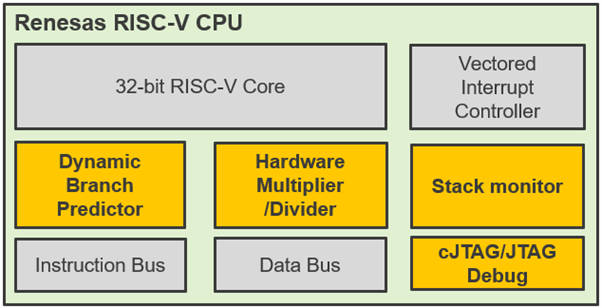
Two-wire compact JTAG debug can be implemented for low pin-count packages, and performance monitor registers can be added for benchmarking, as well as an instruction tracing unit.
The new microcontrollers, called the R9A02G021 group, come in packages with between 16 and 48pads: 2 x 2mm 16pad WLCSP and QFNs from 4 x 4 to 7 x 7mm with 24, 32 or 48pads – there is one part number for each of the four packages.
They implement the RV32I instruction set and include two-wire JTAG and the company’s core-local interrupt controller (CLIC)
Clocking is at up to 48MHz, delivering 3.27Coremark/MHz, and consumption is 162μA/MHz, or 300nA in stand-by with 4μs wake. Operation is over 1.6 to 5.5V and -40 to 125°C.
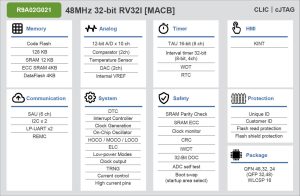
There is 128kbyte of instruction flash, 4kbyte of data flash and 16kbyte of ram, plus a 12bit ADC, an 8bit DAC and serial communication including UART, SPI and I2C.
The company’s ‘SAU’ peripheral is also included to implement up to six simplified SPI interfaces, up to three more UARTs or up to six simplified I2C interfaces, depending on package size.
To tempt potential adopters from more familiar architectures, Renesas has lined up plenty of support from the start, with the its e2 studio Eclipse-based IDE (integrated development environment) providing a code configurator and the LLVM compiler.
“Complete development environments are also available from IAR with its Embedded Workbench IDE and I-jet debug probe, and Segger with the Embedded Studio IDE, J-Link debug probes and Flasher production programmers,” it said.
FPB-R9A02G021 is the hardware development board (right).
No less than 18 application notes have been prepared to go along with the product launch, covering state-switching, boot firmware and many of the peripherals.
Jayce
/include/upload/kind/image/20240327/20240327174207_5562.jpg
Resasas has put its in-house developed 32bit RISC-V core into a few-pin general-purpose MCU series, following earlier RISC-V projects with Anders and SiFive.
Announced last November, the core implementation can accommodate various
2024/3/27 17:43:57
2024/3/27 17:43:57
22
0
556
5
Flyking Weekly Industry Express
Jayce
/include/upload/kind/image/20240325/20240325181238_0633.jpg
2024/3/25 18:12:59
2024/3/25 18:12:59
36
0
555
6
Financing the Chip Business
U.S. President Biden announced on Wednesday an agreement to provide Intel with $8.5 billion in direct funding and $11 billion in loans under the CHIPS and Science Act, reports Semiconductor Intelligence (SI). Intel will use the funding for wafer fabs in Arizona, Ohio, New Mexico, and Oregon.
As SI reported in its December 2023 newsletter, the CHIPS Act provides a total of $52.7 billion for the U.S. semiconductor industry, including $39 billion in manufacturing incentives.
Prior to the Intel grant, the CHIPS Act had announced grants totaling $1.7 billion to GlobalFoundries, Microchip Technology, and BAE Systems, according to the Semiconductor Industry Association (SIA).
Grants under the CHIPS Act have been slow in coming, with the first grants announced over a year after passage. Some major fab projects in the U.S. have been delayed due the slow disbursement. TSMC also cited difficulties in finding qualified construction personnel. Intel said the delay was also due to slowing sales.

Other nations have also allocated funds to promote semiconductor production. The European Union in September 2023 passed the European Chips Act which provides for 43 billion euro (US$47 billion) of public and private investment in the semiconductor industry.
In November 2023, Japan allocated 2 trillion yen (US$13 billion) for semiconductor manufacturing.
Taiwan in January 2024 enacted a law to provide tax breaks for semiconductor companies.
South Korea in March 2023 passed a bill to provide tax breaks to strategic technologies including semiconductors.
China is expected to create a $40 billion fund backed by the government to subsidize its semiconductor industry.
What is the outlook for capital expenditures (CapEx) in the semiconductor industry this year?
The CHIPS Act was designed to spur CapEx, but much of the effect will not occur until after 2024.
After a disappointing 8.2% decline in the semiconductor market last year, many companies are cautious about CapEx in 2024.
SI estimates total semiconductor CapEx in 2023 was $169 billion, down 7% from 2022. Our forecast is a 2% decline in CapEx in 2024.
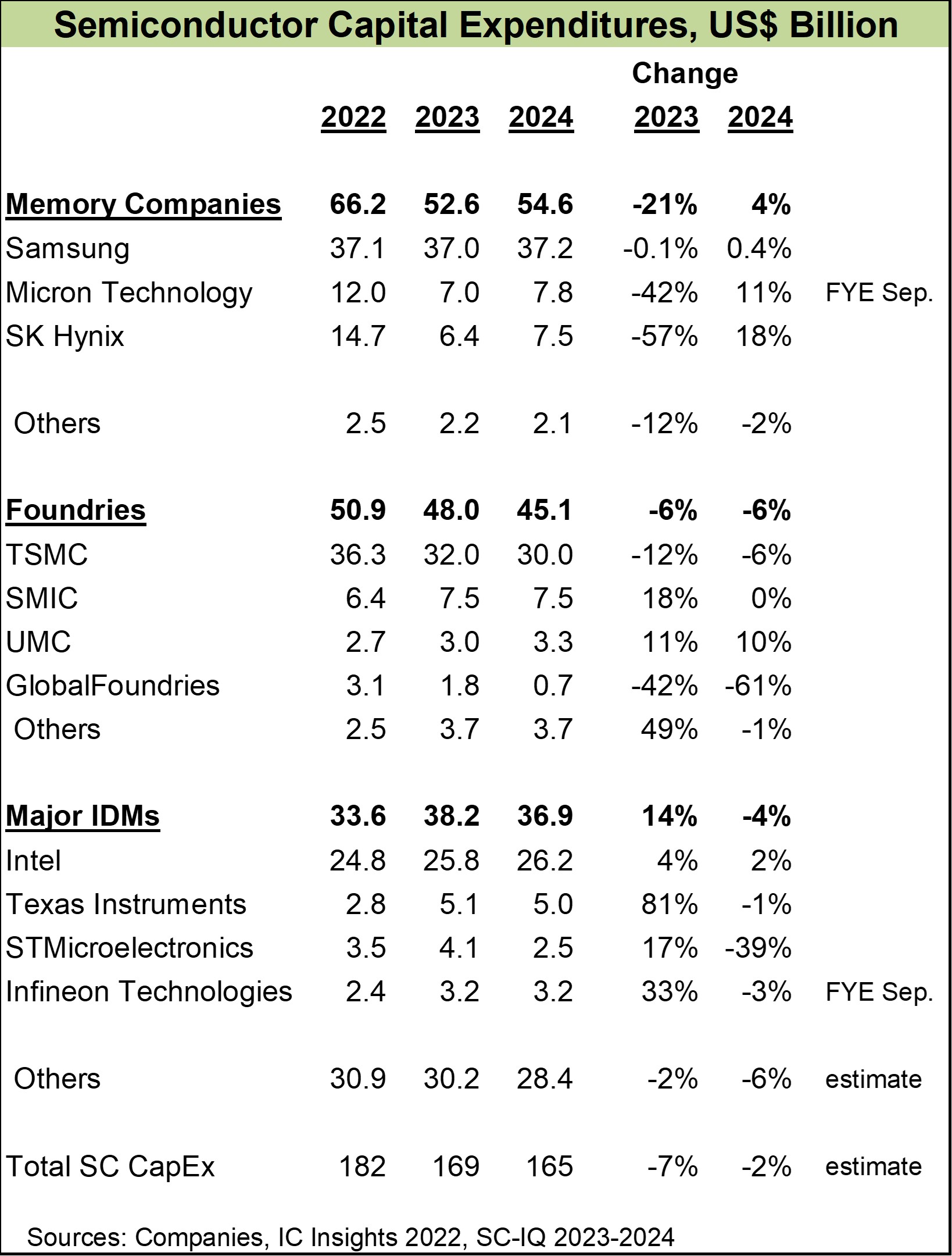
The major memory companies are generally increasing CapEx in 2024 as the memory market recovers and new applications such as AI are expected to increase demand.
Samsung plans relatively flat spending in 2024 at $37 billion but did not cut CapEx in 2023.
Micron Technology and SK Hynix cut back CapEx significantly in 2023 and are planning double-digit increases in 2024.
The largest foundry, TSMC, plans to spend about $28 billion to $32 billion in 2024, with the midrange of $30 billion down 6% from 2023.
SMIC is planning flat CapEx while UMC plans a 10% increase.
GlobalFoundries expects a 61% cut in 2024 CapEx but will ramp up spending in the next few years as it builds a new fab in Malta, New York.
Among IDMs, Intel plans to increase CapEx in 2024 by 2% to $26.2 billion. Intel will increase capacity for foundry customers as well as for internal products.
Texas Instruments’ CapEx is roughly flat. TI plans to spend about $5 billion a year through 2026, primarily for its new fabs in Sherman, Texas.
STMicroelectronics will cut CapEx 39% while Infineon Technologies will cut by 3%.
The three largest spenders – Samsung, TSMC and Intel – will account for 57% of semiconductor industry CapEx in 2024.
What is the appropriate level of CapEx relative to the semiconductor market?
The semiconductor market is notoriously volatile. Over the last 40 years, annual change has ranged from 46% growth in 1984 to a 32% decline in 2001. Although the industry has become somewhat less volatile as it has matured, in the last five years it has shown a 26% increase in 2021 and a 12% decrease in 2019.
Semiconductor companies need to plan their capacity several years out. It takes about two years to build a new wafer fab and additional time for planning and financing. As a result,the ratio of semiconductor CapEx to the semiconductor market varies greatly, as shown below.

The semiconductor CapEx to market size ratio has varied from a high of 34% to a low of 12%. The five-year average ratio ranges between 28% and 18%. Over the total period of 1980 to 2023, the total CapEx was 23% of the semiconductor market. Despite the volatility, the long-term trend of the ratio has been fairly consistent.
Based on expected strong market growth and a drop in CapEx, SI expects the ratio to drop from 32% in 2023 to 27% in 2024.
Most forecasts for semiconductor market growth in 2024 are in the range of 13% to 20%. SI’s forecast is 18%.
Jayce
/include/upload/kind/image/20240323/20240323144522_7523.jpeg
U.S. President Biden announced on Wednesday an agreement to provide Intel with $8.5 billion in direct funding and $11 billion in loans under the CHIPS and Science Act, reports Semiconductor Intelligence (SI). Intel will use the funding for wafer fa
2024/3/23 14:47:37
2024/3/23 14:47:37
22
0
554
6
HBM to be 14% of DRAM Industry This Year
By the end of 2024, the DRAM industry is expected to have allocated approximately 250K/m (14%) of total capacity to producing HBM TSV, with an estimated annual supply bit growth of around 260%, says TrendForce svp Avril Wu.
HBM’s revenue share within the DRAM industry—around 8.4% in 2023—is projected to increase to 20.1% by the end of 2024.

The die size of HBM is generally 35–45% larger than DDR5 of the same process and capacity (for example, 24Gb compared to 24Gb).
The yield rate (including TSV packaging) for HBM is approximately 20–30% lower than that of DDR5, and the production cycle (including TSV) is 1.5 to 2 months longer than DDR5.
HBM has a longer production cycle than DDR5 – over two quarters from wafer start to final packaging.
Samsung’s total HBM capacity is expected to reach around 130K (including TSV) by year-end; Hynix’s capacity is around 120K.

Jayce
/include/upload/kind/image/20240320/20240320175145_2512.jpeg
By the end of 2024, the DRAM industry is expected to have allocated approximately 250K/m (14%) of total capacity to producing HBM TSV, with an estimated annual supply bit growth of around 260%, says TrendForce svp Avril Wu.
HBM’s re
2024/3/20 17:53:24
2024/3/20 17:53:24
24
0
553
6
Magnetic sensors market has 4% CAGR 2023-29 to reach $3.7bn
The magnetic sensor market is expected to reach $3.7 billion in 2029, with an estimated 4% CAGR from 2023 to 2029, says Yole Developpement.
RECOMMENDED ARTICLESHBM to be 14% of DRAM industry this yearUS strategy for microelectronics research publishedTelecom equipment sales fell 5% in 2023, set to fall again in 2024Smartphones bounce backAllegro Microsystems leads in revenue, TDK leads in volume.
A $1 billion investment surge from players like Allegro, TDK, Bosch, LEM etc. is leveraging the technology’s sensitivity, bandwidth, and low power consumption to sense position and current.
Magnetic sensors find widespread application across automotive, mobility, industrial, energy, medical, and consumer sectors. Their versatility has led to their adoption in various fields, propelling the market to a value of $2.9 billion in 2023.
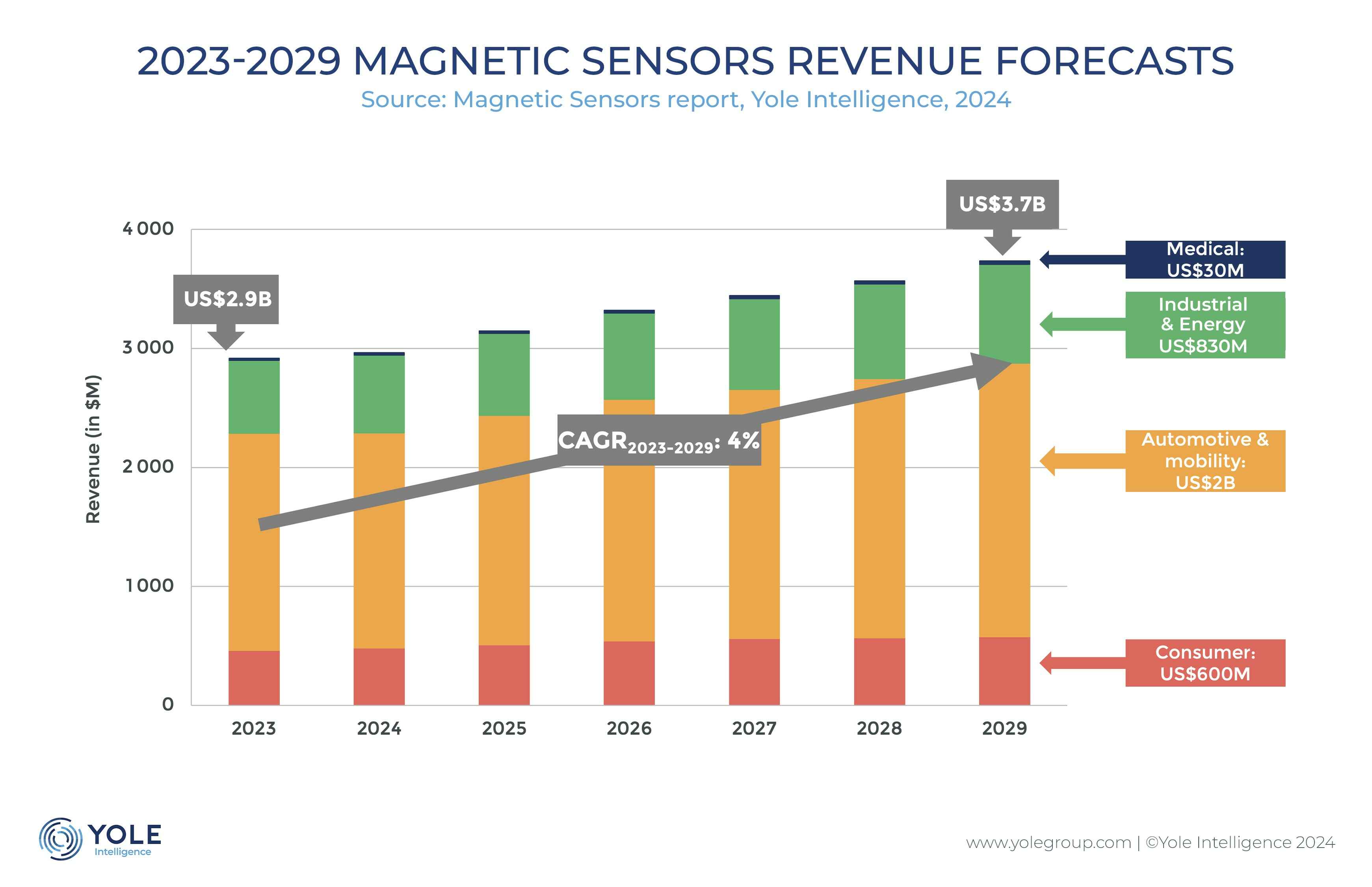

“The automotive & mobility segment significantly dominates the market with sales of more than $2 billion by 2029,” says Yole’s Pierre Delbos, “this segment is driven by important shifts such as vehicle electrification and sensor integration. Conversely, consumer applications lead in terms of volume. At Yole Group, we anticipate a nearly $600 million market by 2029, also growing at a 4% CAGR between 2023 and 2029”.
The evolving landscape of magnetic sensor applications extends to the industrial & energy and medical sectors. By 2029, these sectors are expected to reach $830 million and $30 million, respectively.
Factors such as the proliferation of DC-charging stations with integrated current sensors due to vehicle electrification, the demand for position sensors, switches, and latches driven by Industry 4.0, and the potential implementation of predictive maintenance using current sensors contribute to the promising outlook in these sectors.
Jayce
/include/upload/kind/image/20240319/20240319175909_2918.jpg
The magnetic sensor market is expected to reach $3.7 billion in 2029, with an estimated 4% CAGR from 2023 to 2029, says Yole Developpement.
RECOMMENDED ARTICLESHBM to be 14% of DRAM industry this yearUS strategy for microelectronics
2024/3/19 18:00:31
2024/3/19 18:00:31
24
0
552
5
Flyking Weekly Industry Express
Jayce
/include/upload/kind/image/20240318/20240318173637_6121.jpg
2024/3/18 17:36:55
2024/3/18 17:36:55
42
0
551
6
Q4 Foundry Revenues up 7.9%
Q4 foundry revenues rose 7.9% to $30.49 billion, says TrendForce, primarily driven by demand for smartphone components, such as mid and low-end smartphone APs and peripheral PMICs.
The launch season for Apple’s latest devices also significantly contributed, fueling shipments for the A17 chipset and associated peripheral ICs, including OLED DDIs, CIS, and PMICs. TSMC’s premium 3nm process notably enhanced its revenue contribution, pushing its global market share past the 60% threshold this quarter.

Last year the foundry market suffered a 13.6% fall witnrevenue reaching $111.54 billion.
2024 promises better, says TendForce, with AI-driven demand expected to boost annual revenue by 12% to $125.24 billion.
In Q4, top 5 foundries expanded market share to 88.8% with TSMC taking 60%.
TSMC’s wafer shipments rose in 4Q23 thanks to demand from smartphones, notebooks, and AI-related HPC and its revenue jumped 14% over the quarter to $19.66 billion.
Revenue shares from processes 7nm and below climbed from 59% in Q3 to 67% in Q4, underscoring TSMC’s dependency on cutting-edge technologies. With the progressive ramp-up of 3nm production, the share of revenue from advanced processes is expected to surpass 70%.
Samsung also received orders for various new smartphone components, predominantly in mature processes above 28nm. Meanwhile, demand for advanced process main chips and modems saw steadier demand due to early procurement by clients, leading to a slight 1.9% QoQ drop in Samsung’s foundry revenue to $3.62 billion.
GlobalFoundries saw a modest 5% revenue growth in the automotive segment, primarily attributed to a surge in LTAs signed by numerous automotive clients and slight optimizations in ASP. However, shipments in key application areas such as smart mobile devices, communication, and home/industrial IoT witnessed declines, resulting in overall revenue reaching approximately $1.85 billion in Q4.
UMC experienced occasional spikes in orders from the smartphone and PC sectors, but a weak global economy, conservative wafer start decisions by clients, and inventory adjustments in the automotive sector led to a downturn in wafer shipments, resulting in a 4.1% decrease in Q4 revenue to about $1.73 billion.
SMIC enjoyed a 3.6% quarterly increase in revenue to roughly $1.68 billion, mainly due to urgent orders related to smartphones and notebooks/PCs, while shipments for network communications, general consumer electronics, and automotive/industrial control sectors saw declines.
Three significant changes occurred in rankings were, PSMC moved up to eighth place, benefiting from the recovery in specialty DRAM wafer outputs and urgent orders for smartphone components, Nexchip reentered the top ten and secured the ninth spot, thanks to urgent TDDI orders and high-volume shipments of new CIS products, and VIS dropped to tenth place due to a slowdown in TV-related orders and inventory adjustments by automotive and industrial control customers.
IFS, which entered the top ten for the first time in 3Q23, was pushed out of the rankings by PSMC and Nexchip due to factors such as the transition between new and old generations of CPUs and lackluster inventory momentum at Intel.
Other companies, such as HuaHong Group and Tower, saw their revenue decrease by 14.2% and 1.7%, respectively. The minor decline in revenue for Tower is attributed to its long-term focus on niche markets like RFFEM, automotive, and industrial control, which shielded it from the impacts felt by companies primarily in the consumer electronics sector. However, as automotive and industrial control clients also began adjusting their inventories, the utilization rate of Tower further decreased in the fourth quarter
Jayce
/include/upload/kind/image/20240314/20240314183135_2542.png
Q4 foundry revenues rose 7.9% to $30.49 billion, says TrendForce, primarily driven by demand for smartphone components, such as mid and low-end smartphone APs and peripheral PMICs.
The launch season for Apple’s latest devices also
2024/3/14 18:33:21
2024/3/14 18:33:21
28
0
550
6
Resurgence in Enterprise SSD Market
In Q3 2023 enterprise SSD suppliers cut production leading to a 15% Q4 surge in contract SSD prices, says TrendForce
This produced a 47.6% QoQ increase for Q4 enterprise SSD industry revenues which hit $23.1 billion.
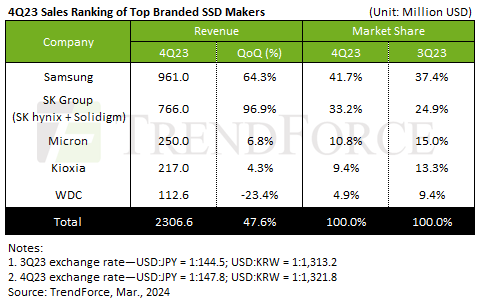
Contract prices are now expected to increase by over 25% delivering 20% revenue growth in Q1.
SK Group recorded the highest growth rate in the enterprise SSD segment for 4Q23, with revenues hitting $766 million —a 96.9% jump.
Samsung secured the second-highest growth at 64.3%, reaching $961 million.
Micron saw a 6.8% rise to $250 million.
Kioxia had a 4.3% revenue increase in 4Q23 to $217 million.
Western Digital’s revenues fell to $113 million — a 23.4% decline.
Jayce
/include/upload/kind/image/20240312/20240312174202_6293.png
In Q3 2023 enterprise SSD suppliers cut production leading to a 15% Q4 surge in contract SSD prices, says TrendForce
This produced a 47.6% QoQ increase for Q4 enterprise SSD industry revenues which hit $23.1 billion.
2024/3/12 17:42:43
2024/3/12 17:42:43
29
0
549
5
Flyking Weekly Industry Express
Jayce
/include/upload/kind/image/20240311/20240311180611_3901.jpg
2024/3/11 18:06:30
2024/3/11 18:06:30
38
0
548
6
Samsung sampling solid state batteries
Samsung says it has begun sampling solid state batteries to car manufacturers and will begin mass production of the batteries for EVs and other applications in 2027.
Last year, the company set up a pilot line in Suwon and is using it to,refine the product and improve yields
The company says that its solid-state batteries will have an energy density of 900 watt-hours per litre which is 40% better than from its lithium-ion batteries.
As well as high energy density solid-state batteries have short charging times of around ten minutes and are lighter and safer than lithium-ion batteries.
Hyundai is also targeting 2027 for mass-production of solid state batteries and Toyota says it will start selling cars with solid state batteries in 2027-8.
Jayce
/include/upload/kind/image/20240308/20240308181129_5144.jpeg
Samsung says it has begun sampling solid state batteries to car manufacturers and will begin mass production of the batteries for EVs and other applications in 2027.
Last year, the company set up a pilot line in Suwon and is us
2024/3/8 18:11:52
2024/3/8 18:11:52
43
0
547
5
Celebrating International Women's Day at Flyking Technology
As we approach International Women's Day on March 8th, we at Flyking Technology prepared a special celebration dedicated to all the incredible women who contribute to our company's success every day.
International Women's Day is a global day celebrating the social, economic, cultural, and political achievements of women. It's also a day to raise awareness about gender equality and women's rights. At Flyking Technology, where a significant portion of our workforce comprises talented women, we're taking this opportunity to stand in solidarity with them.
Watch Flyking's Women's Day Special
Best Wishes from Gentlemen

We believe it's essential to hear from our male colleagues on this special occasion. We've invited them to share their thoughts and well-wishes for ladies in Flyking. Through a series of interviews, our male colleagues expressed their appreciation and support for ladies from the deep of their hearts.

In addition to verbal expressions of gratitude, we're providing a more tangible way for our male colleagues to convey their best wishes. We've prepared special greeting cards where they can write personalized messages of encouragement and appreciation for their female colleagues.

Sincere Gifts for Ladies
On the morning of March 8th, we invited our ladies of Flyking Technology to randomly select greeting cards prepared by the gentlemen, and they also received the Women's Day gifts prepared by our HR team.

We believe that even if a little concern can make a significant impact. Seeing the joy and excitement on the faces of our ladies as they receive these tokens of appreciation would be a testament to the supportive and inclusive culture we strive to cultivate at Flyking Technology.
Let's come together to celebrate the achievements, resilience, and boundless potential of the women who make Flyking Technology the incredible place it is. Happy International Women's Day!
Jayce
/include/upload/kind/image/20240308/20240308180553_0086.png
As we approach International Women's Day on March 8th, we at Flyking Technology prepared a special celebration dedicated to all the incredible women who contribute to our company's success every day.
International Women's Day is a glo
2024/3/8 18:09:36
2024/3/8 18:09:36
61
0
546
6
Q4 24.5% q-o-q leap for NAND
Q4 saw a 24.5% QoQ increase in NAND revenue reaching $11.49 billion, reports TrendForce.
Q1 is forecast to see a further 20% increase in revenues and a 25% increase in contract prices.
Samsung’s bit shipment volume increased by 35% QoQ, coupled with a 12% increase in ASP, boosting its revenue to $4.2 billion—a 44.8% QoQ growth.

Hynix had a 33.1% revenue jump to $2.48 billion.
Western Digital had 2% dip in shipment volume but a 10% increase in ASP, leading to a 7% revenue increase to $1.67 billion.
Kioxia had an 8% revenue increase to $1.44 billion in Q4.
Micron reduced its supply significantly to improve profitability, leading to a more than 10% QoQ decrease in bit shipments and a 1.1% decrease in revenue to $1.14 billion.
Jayce
/include/upload/kind/image/20240307/20240307171719_4992.png
Q4 saw a 24.5% QoQ increase in NAND revenue reaching $11.49 billion, reports TrendForce.
Q1 is forecast to see a further 20% increase in revenues and a 25% increase in contract prices.
Samsung’s bit shipment vol
2024/3/7 17:18:00
2024/3/7 17:18:00
36
0
545
6
Government approves Vishay takeover of Newport Wafer Fab
Government consent for the acquisition of Newport Wafer Fab by Vishay has finally been given by Deputy Prime Minister and Secretary of State in the Cabinet Office Oliver Dowden.
The site has now been renamed Newport Vishay.
Vishay’s $177 million offer for the fab was accepted last November but the government has been dragging its feet for four months over giving a final consent order.
The old Inmos fab, which opened in 1980, had been acquired by Nexperia, which is controlled by a China government-controlled fund called Wingtech. This was seen as a security risk.
Vishay says it will expand operations at the site, including R&D for compound semiconductor development.
Jayce
/include/upload/kind/image/20240305/20240305173333_0885.jpg
Government consent for the acquisition of Newport Wafer Fab by Vishay has finally been given by Deputy Prime Minister and Secretary of State in the Cabinet Office Oliver Dowden.
The site has now been renamed Newport Vishay.
2024/3/5 17:33:40
2024/3/5 17:33:40
32
0
544
5
Flyking Weekly Industry Express
Jayce
/include/upload/kind/image/20240304/20240304180759_0910.jpg
2024/3/4 18:08:12
2024/3/4 18:08:12
46
0
543
6
Q1 lead times mostly stable, says Sourcengine
Sourcengine has published its Q1 lead time report.
Volatile memory is at 11-17 weeks and going up and NV memory is at 13-19 weeks and is mostly going up or, if not, is stable.
Storage is at 10-15 weeks and mostly going up.
Discretes are at 20-47 weeks and stable
Standard logic and linear are at 7-20 weeks and mostly stable
Advanced analogue is at 23-41 weeks and mostly stable
Embedded processors are 15-48 weeks and mostly stable
Programmable logic is at 20-25 weeks and stable
Here is the full report
Jayce
/include/upload/kind/image/20240301/20240301212338_0118.jpg
Sourcengine has published its Q1 lead time report.
Volatile memory is at 11-17 weeks and going up and NV memory is at 13-19 weeks and is mostly going up or, if not, is stable.
Storage is at 10-15 weeks and mostly going
2024/3/1 21:25:11
2024/3/1 21:25:11
35
0
542
6
This Is the Year of Smartphone Recovery
Over the past seven years, the smartphone market has contracted six times on an annual basis, however, 2024 is set to be the year when the market returns to growth, says IDC.
2024 smartphone shipments are expected to reach 1.2 billion units – up 2.8% y-o-y followed by low single-digit growth till 2028.

While overall volumes are still below pre-pandemic levels, IDC believes the market has corrected itself and is moving on from the bottom.
Foldable smartphone shipments are expected to grow 37% and shipments will reach 25 million in 2024.
AI has become part of the smartphone discussion, sparking interest in AI experiences on a handheld device.
Jayce
/include/upload/kind/image/20240228/20240228183229_7550.png
Over the past seven years, the smartphone market has contracted six times on an annual basis, however, 2024 is set to be the year when the market returns to growth, says IDC.
2024 smartphone shipments are expected to reach 1.2 billio
2024/2/28 18:33:31
2024/2/28 18:33:31
55
0
541
5
Moving Day Celebration | Flyking Technology Establishes New Office
On February 28, 2024, Flyking Technology’s Asian Franchise Lines Division — Kaimeirui, and Electrical Solution Division — Grand Vision, relocated to a new office together. The new address is below:
Room 606-1, Building T3, Phase I, Hongqiao Wanchuang Center, Lane 500, Xinlong Road, Qibao Town, Minhang District, Shanghai.

This signifies the company's transition to a more robust development path, with a brighter future ahead. Accompanied by cheerful and festive music, the leaders of Flyking Technology cut the red ribbon together, symbolizing the joint office of the two major divisions will unleash even greater power.

The relocation ceremony commenced with speeches from various senior leaders of Flyking Technology, celebrating the establishment of the new office and inspiring confidence in its development.
Kaimeirui——Asian Franchise Alternative Solutions
Looking across the global semiconductor industry market, there is a severe shortage of popular products, and the supply chains of major manufacturers fail to form a closed loop. This has led to unstable lead times and significant price fluctuations for some products of leading semiconductor manufacturers.
Nowadays, Asian semiconductor manufacturing brands have emerged strongly, with many products capable of replacing those of international leading semiconductor manufacturers constantly appearing. This is why we established Kaimeirui Asian Franchise Lines Division, to help customers solve these challenges. So far, Kaimeirui represents over 30 renowned Asian semiconductor brands, offering a wide range of products including sensors, MOS transistors, diodes, SIC diodes, LDOs, DC-DC converters, power modules, resistors, capacitors, oscillators, covering solutions for consumer electronics, industrial electronics, automotive electronics, security surveillance, IoT, high-end power supplies, and more. We are here to meet customers' diverse procurement needs.
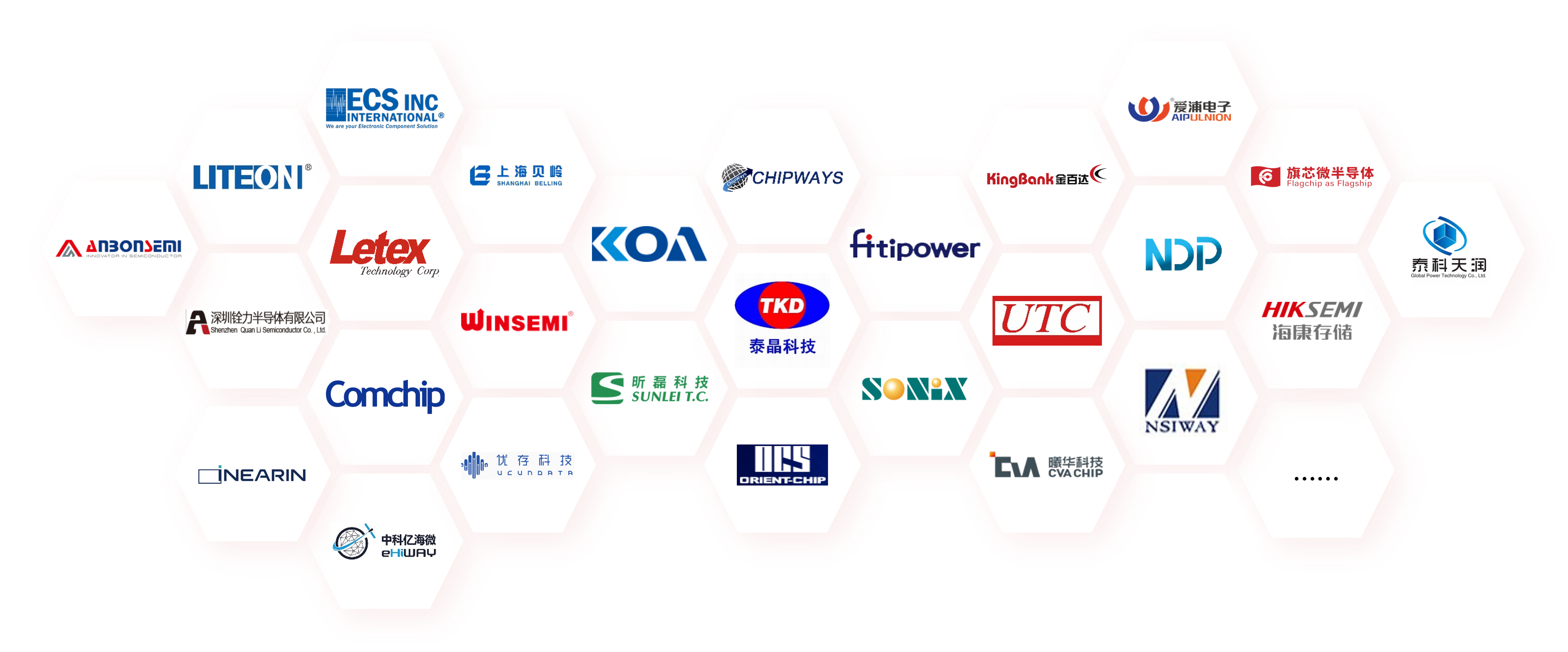
We prioritize quality while also caring deeply about our customers' needs. Leveraging manufacturers' technical support, we provide cost-effective product solutions to our customers, assisting them in shortening product development cycles and expediting product delivery processes through efficient logistics and comprehensive after-sales support.
Grand Vision——Power and Electrical Solution Provider
Flyking Technology's Power and Electrical Solution Division, Grand Vision, is a cold-press terminal service provider that integrates solution development, production, and sales. After years of relentless pursuit, we have established a sound customized service process and have obtained industry certificates such as ISO9001 quality system certification, American UL certification, and EU RoHS/REACH environmental certification.
Grand Vision's products include connectors, terminal blocks, relays, contactors, circuit breakers, power capacitors, magnetic cores, ferrite rings, transformers, inductors, reactors, and switches, which can be widely applied in new energy, electric vehicles, rail transportation, and industrial control. Additionally, Grand Vision has been authorized by many well-known manufacturers internationally, providing customers with professional and efficient electrical service solutions.

Starting from understanding and analyzing customer needs, providing technical specifications for different product categories, and proceeding with design confirmation and sample testing. Each step that Grand Vision do is supported by an experienced technical team, all aimed at providing customers with superior solutions.
From an independent distributor to an agent, and now to a power and electrical solution provider, Flyking's visionary strategic layout has built the company's competitive barriers and solidified each step toward internationalization. The step of the joint office is both a testament to customers' trust and support for Flyking and a commitment and assurance from Flyking to its customers.
Jayce
/include/upload/kind/image/20240228/20240228180942_3459.png
On February 28, 2024, Flyking Technology’s Asian Franchise Lines Division — Kaimeirui, and Electrical Solution Division — Grand Vision, relocated to a new office together. The new address is below:
Room 606-1, Building T3, Phase I,
2024/2/28 18:27:11
2024/2/28 18:27:11
54
0
540
6
H2 2023 high end router market down 8%
The High End Router market declined 8% y-o-y in H2 2023, following an abrupt surge in equipment deliveries in the first half of the year, says Dell’Oro Group.
“The disruptions caused by component shortages and supply chain bottlenecks that started over two years ago are still occurring,” says Dell’Oro vp P Jimmy Yu, “once supply freed up, router manufacturers were able to fulfill backlogged orders at a faster pace, driving High End Router revenue up 12 percent year-over-year in the first half of 2023. However, this turned into extra inventory at customer sites, causing them to rationalize future new orders. We believe it may be another two quarters before inventory levels return to normal levels at these service providers,” added Yu.
The High End Router market reached nearly $13 billion in 2023. The top three vendors by revenue share were Cisco, Huawei, and Nokia. The only vendors to gain more than one percentage point of market share were Cisco and Huawei.
Core Router revenue grew 14 percent in 2023. The top three vendors by revenue share were Cisco, Huawei, and Juniper. Cisco gained nearly 6 percentage points of market share and was the only vendor to gain market share in the year.
Edge Router and Aggregation Switch revenue was unchanged from the year ago period.
Jayce
/include/upload/kind/image/20240227/20240227180039_0877.png
The High End Router market declined 8% y-o-y in H2 2023, following an abrupt surge in equipment deliveries in the first half of the year, says Dell’Oro Group.
“The disruptions caused by component shortages and supply chain bottlene
2024/2/27 18:01:17
2024/2/27 18:01:17
35
0
539
6
Power module revenue on a 12.1% CAGR 2023-29
Power module revenue will grow from $8 billion in 2023 to $16 billion by 2029 representing a 12.1% CAGR between 2023 and 2029, according to Yole Group.
The power module packaging costs fully depend on the packaging materials, such as die-attach and ceramic substrate materials, and the package size.
In 2023, it represented a $2.3 billion market in 2023, with the cost of materials for power module packaging representing about 30 % of the total power module cost.
Materials cost will have an 11% CAGR between 2023 and 2029, and the market should reach $4.3 billion by 2029.
The largest power module packaging material segment is the baseplate, which will be worth $1,070 million by 2029, against $651 million in 2023. Its CAGR will be 9% between 2023 and 2029, closely followed by the ceramic substrate market segment.
“Today, continuous improvements in module materials and packaging design are needed to take advantage of the benefits of SiC technology,” says Yole’s Shalu Agarwal, “however , the development is simultaneously focused on reducing the costs of power modules through “good enough” performance and reliability.”
“The power module packaging supply chain is continually being reshaped, with new companies entering power module manufacturing,” adds Agarwalm “these companies are expanding their product portfolios and forming new partnerships and M&As. In this dynamic context, the growth of Asian packaging material players puts intense cost pressure on European players.”
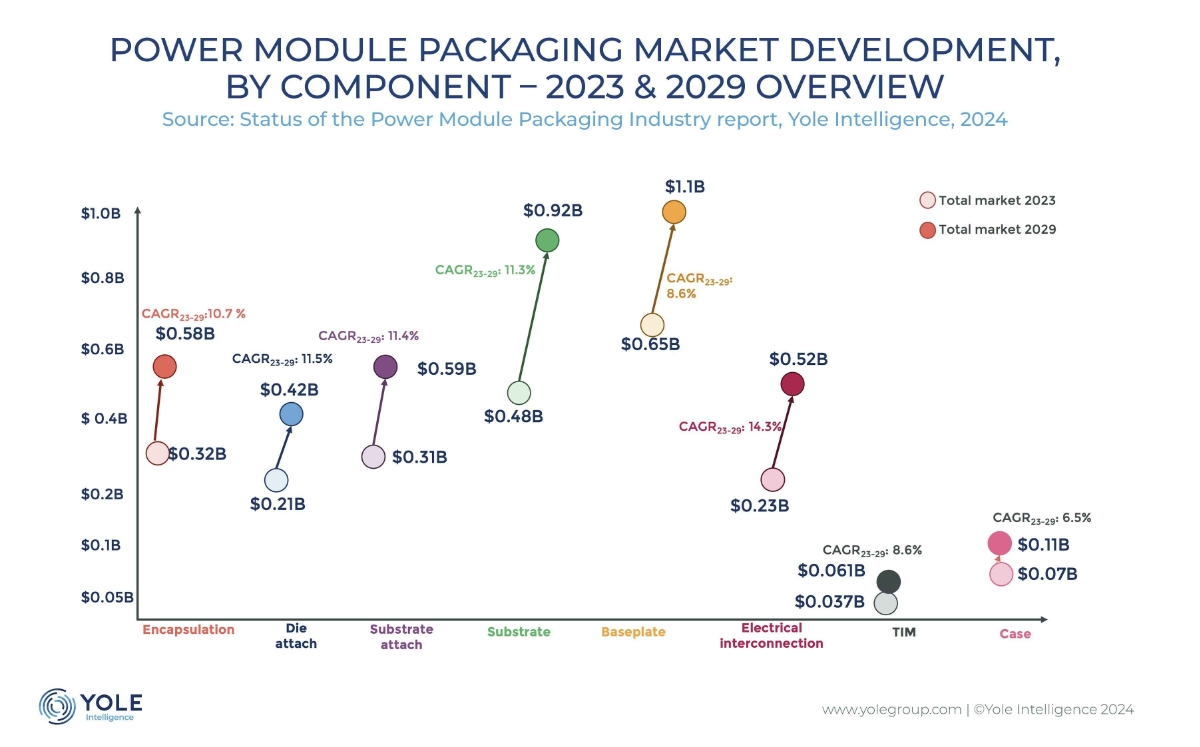
The leading power module suppliers are in Europe and Japan, with Infineon Technologies, Semikron Danfoss, Fuji Electric, and Mitsubishi Electric.
Meanwhile, the leading module packaging material suppliers are primarily located in the US, where Yole Group has identified Rogers Corporation, MacDermid Alpha, 3M, Dow, and Indium Corporation, in Europe with Heraeus, Henkel, for example, and in Japan, with FTH (formally known as Ferrotec), Proterial, Kyocera, Dowa, Denka, Tanaka, Resonac, and NGK Insulators.
The geographic expansion of packaging material providers is increasing. Japanese players have a powerful presence in materials but sometimes need help accessing other regions. Therefore, they are trying to grow their presence in China, Europe, and the United States and are investing in developing their businesses within these regions.
For example, Japan’s NGK Insulators is planning to manufacture ceramic substrates in Poland. Similarly, European and U.S. players, such as Heraeus, Henkel, MacDermid Alpha, and Rogers Corporation, are focusing on Asia, mainly China.
At the same time, several companies along the supply chain have either moved or are planning to transfer their production to countries with a lower cost of production to reduce costs, such as Vietnam, Hungary, Malaysia, and Romania.
This leads to more robust competition, increased price pressure, and increasing motivation for partnerships and M&As.
Jayce
/include/upload/kind/image/20240226/20240226181038_2640.png
Power module revenue will grow from $8 billion in 2023 to $16 billion by 2029 representing a 12.1% CAGR between 2023 and 2029, according to Yole Group.
The power module packaging costs fully depend on the packaging materials, s
2024/2/26 18:11:53
2024/2/26 18:11:53
36
0
538
5
Flyking Weekly Industry Express
Jayce
/include/upload/kind/image/20240226/20240226180800_0837.jpg
2024/2/26 18:08:18
2024/2/26 18:08:18
39
0
537
6
Nvidia Astonishes
Nvidia's Q4 proft was $12.3 billion.
It's full year revenue was up 126% y-o-y at $60.9 billion.
Q4 datacentre revenue was up 409% y-o-y at $18.4 billion.
Full year datacentre revenue was up 27% y-o-y at $47.5 billion.
Q1 revenues are forecast to be up 233% y-o-y at $24 billion plus or minus 2%.
At last night’s close, Nvidia’s market cap was $1.7 trillion.
Although its customers are scrabbling to find proprietary or merchant market alternatives, so far Nvidia looks as if it can out-run them on the tech with better chips, while offering them ASIC solutions tailored to their particular needs.
Jayce
/include/upload/kind/image/20240222/20240222175423_7212.jpg
Nvidia’s Q4 revenue was up 265% y-o-y at $22.1 billion.
2024/2/22 17:55:06
2024/2/22 17:55:06
35
0
536
5
January Market Report: Summary of Automotive Industry
Overview of the Automotive Semiconductor Industry
January 2024 has concluded with a 69% year-over-year increase in global electric vehicle (EV) sales, reaching 1.1 million units, albeit experiencing a 26% decline compared to December. Reductions in subsidies in Germany and France, coupled with seasonal softness in Chinese sales, were primary factors. Sales in Germany and France decreased by approximately 50% compared to December, yet the anticipated 2025 EU emission standards are expected to stimulate supply for pure EVs and hybrid models.
Sales revenues in the U.S. and Canada surged by 41%, nearly doubling in China, and increased by 29% in the EU, European Free Trade Association, and the UK. However, sales declined by 26% before the Chinese Lunar New Year, 32% in Europe, and 14% in the U.S. and Canada compared to December. General Motors' introduction of plug-in hybrid electric vehicles in the North American market marks a strategic reversal in bypassing hybrid systems. Despite consumer hesitancy due to high EV prices and challenges in charging infrastructure, hybrid vehicle sales continue to rise in the United States.
Updates from Automotive Semiconductor Manufacturers
Renesas is set to acquire Transphorm, a designer and manufacturer of gallium nitride (GaN) power devices, for approximately $339 million. GaN, a wide-bandgap technology, finds application in high-voltage applications across various markets, including EVs and fast EV chargers, as well as data centers and industrial applications.
Intel announced its acquisition of Silicon Mobility SAS to integrate artificial intelligence (AI) efficiency into electric vehicle (EV) energy management. The company also stated that the new AI-enhanced software-defined vehicle SoC would enable onboard AI and camera-based driver/passenger monitoring. Additionally, the company plans to offer an open automotive chip platform for customers to integrate their own chips into Intel's automotive products.
Infineon and Aurora Labs introduced an AI-based solution to enhance the reliability and safety of critical automotive components, including steering, braking, and airbags.
NXP expanded its automotive radar single-chip series, integrating high-performance radar transceivers, multicore radar processors, and MACsec hardware engines for secure data communication via automotive Ethernet.
Texas Instruments launched the industry's first single-chip radar sensor designed for satellite architecture, enabling more precise Advanced Driver Assistance Systems (ADAS) decisions and supporting new driver chip systems for battery management or power flow control in other power systems.
Qualcomm and Bosch unveiled a central in-vehicle computer capable of running both infotainment and ADAS functions on a single SoC.
Developments in Automotive Manufacturers
Tesla: Since 2024, Tesla's stock price has seen a significant decline, dropping by 24.6% in January and continuing to fall, currently down by 55.5% from its 2021 peak. Despite a 20% year-over-year increase in fourth-quarter sales, revenue growth was only 3%. To sustain sales momentum, Tesla significantly reduced prices throughout the year and offered discounts. Automotive gross margins plummeted from 30% in Q4 2021 to below 20%. In early 2024, Tesla continued price reductions in China and Europe, with analysts identifying automotive gross margins as a critical revenue concern.
BYD: Influenced by seasonal factors, BYD witnessed a month-over-month sales decline in January but grew by 33.14% year-over-year. Despite a 40.92% decrease in Chinese market sales, BYD achieved a historic high in overseas sales, reaching 36,174 units, a 247.53% year-over-year increase. Since March 2022, BYD has been focusing on producing plug-in hybrid and pure EVs.
BMW: In January, BMW announced its integration of Amazon's Alexa technology into the language assistant of some of its vehicles, starting this year. At CES 2024, BMW and Amazon showcased a voice assistant product based on the Alexa AI model, capable of advanced language processing and generating complex responses. Additionally, BMW stated that starting in 2027, its Munich plant would exclusively produce electric vehicles.
Hyundai: At CES 2024, Hyundai presented the theme "Ease every way," emphasizing human-centric life innovations through advancements in hydrogen energy, software, and AI. Hyundai's HTWO brand will transition into a hydrogen value chain business brand, integrating various industry segments such as hydrogen production, storage, transportation, and utilization. Furthermore, Hyundai introduced the "Software-Defined Everything (SDx)" strategy to accelerate software-centric intelligent mobility development.
Kia: At CES 2024, Kia unveiled its platform "Beyond Mobility," surpassing traditional automotive business, based on the all-new modular vehicle Concept PV5. The strategy aims to revolutionize the mobility industry through its PBV business and support the Hyundai Motor Group's goals in robotics, Advanced Air Mobility (AAM), and autonomous driving technology.
Honda: Honda globally premiered the "Honda 0 Series" electric concept car at CES 2024, previewing a new EV series set to launch in 2026, including Saloon and Space-Hub concept models and a new H logo. Honda aims for carbon neutrality by 2050, planning for electric and fuel cell vehicle sales to reach 100% by 2040.
Forecast for the Automotive Semiconductor Market
The automotive semiconductor industry is projected to grow from $436.629 billion in 2022 to $857.278 billion by 2030, with a Compound Annual Growth Rate (CAGR) of 8.6% (2022-2030).
The trends towards automotive intelligence and electrification will drive semiconductor market growth, with ADAS and infotainment being major drivers. By 2027, ADAS is expected to account for 30% of the automotive semiconductor market, with a growth rate of 19.8%; infotainment will represent 20%, with a growth rate of 14.6%. This indicates a long-term stable growth in chip demand for automotive electronics.
Jayce
/include/upload/kind/image/20240222/20240222172953_7147.png
Overview of the Automotive Semiconductor Industry
January 2024 has concluded with a 69% year-over-year increase in global electric vehicle (EV) sales, reaching 1.1 million units, albeit experiencing a 26% decline compared to December.
2024/2/22 17:31:43
2024/2/22 17:31:43
62
0
535
5
Kick Off the Loong Year: Flyking's New Year Gathering
As the Lucky Dragon Dances into Spring, our brand-new journey has begun. On the ninth day of the first lunar month, Flyking Technology kicks off with vigor!

New Year New Start
On the first day back to work after the Chinese New Year holiday, the joy and excitement of the Spring Festival spread still. Every corner of our offices is filled with a festive atmosphere, with our Chinese knots conveying hopes and aspirations for the new year.
“Happy New Year & Gong Xi Fa Cai”, we bless each other with happiness and peace, we get our lucky money from various red envelopes.
Today's most anticipated event is undoubtedly receiving the red envelopes, symbolizing a prosperous start to the new year for Flyking Technology and conveying our company's best wishes to all employees.
Flyking’s Chairman, Fred, and CEO, Norman send their New Year blessings and best wishes for the start of work.
New Year Kick-off Gathering
In addition to the red envelopes for the New Year, we also organized a lively and thoughtful Kick-off Gathering activity, which is full of fun and surprises. We get together to welcome the first day of work in the new year with a fresh outlook!

During the party, the gaming session was filled with excitement, featuring a thrilling game of "Rolling Fortune" and a music-themed challenge called "Lyric Library." There was also the joyful game of "Fortune Shovel," where we blindfolded ourselves and dug with all of our luck.
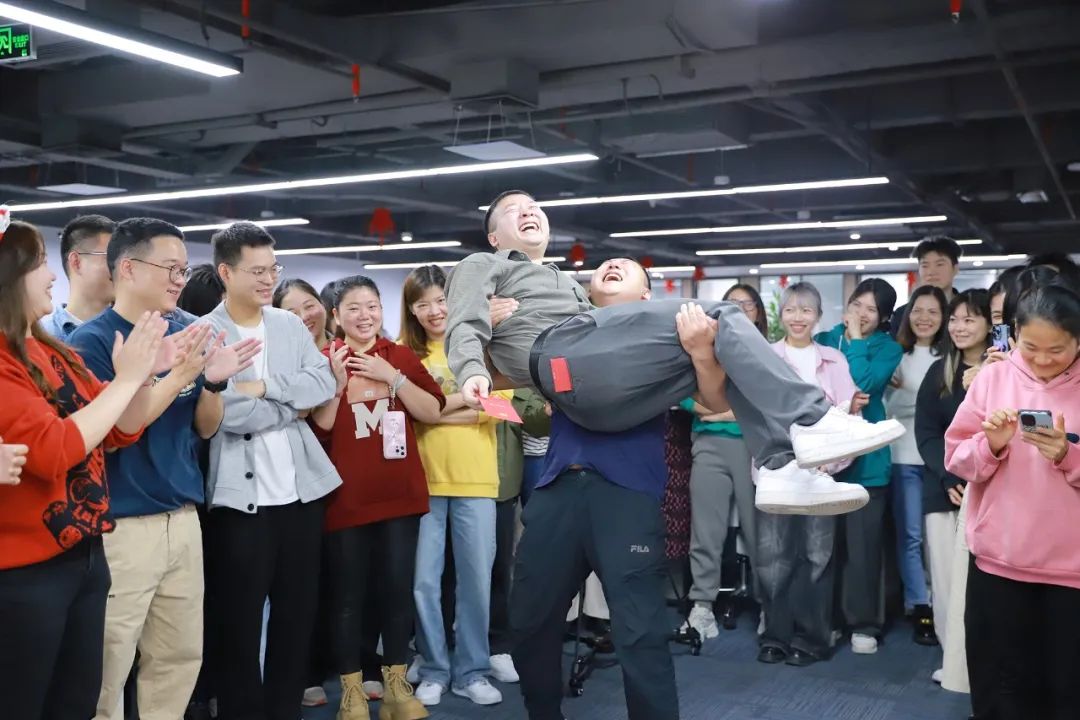
The entire gathering was lively and extraordinary, with colleagues enjoying themselves and embracing the new year with full vitality, kicking off a new journey with enthusiasm!

Let’s focus on the journey of the Loong Year. Flyking Technology will continue to uphold every ounce of trust, respond to expectations with quality, fulfill our mission with service, and forge ahead with full vigor amidst the tide of electronic components.
Jayce
/include/upload/kind/image/20240219/20240219180610_8600.png
As the Lucky Dragon Dances into Spring, our brand-new journey has begun. On the ninth day of the first lunar month, Flyking Technology kicks off with vigor!
New Year New Start
On the first day back to
2024/2/19 18:11:51
2024/2/19 18:11:51
36
0
534
6
Smart NICs to Be $5bn Market by 2028
The Smart NIC market will top $5 billion by 2028, says Dell’Oro.
Accelerated computing will continue to push the boundaries in server connectivity, demanding port speeds of 400 Gbps and higher speeds.
“The Ethernet Adapter market is poised for a compound annual growth rate of 13 percent, fueled by the increasing adoption of higher-speed ports and Smart NICs within data center infrastructures,” says Dell’Oro’s Baron Fung, “the hyperscale cloud service providers will drive rapid development in server connectivity, including increasing the adoption of customized Smart NICs and DPUs, and server port speeds reaching 800 Gbps in the next several years for accelerated computing. The rest of the market, which lags the hyperscale market in the deployment of these technologies, will still be an attractive market for the open vendors offering off the shelf solutions.”
Total Ethernet Controller and Adapter market, not counting the AI back-end network market, is forecast to exceed $8 billion by 2028.
The majority of the accelerated servers will have server access speeds of 400 Gbps and higher by 2028.
Smart NICs are expected to cannibalise Standard NICs during the forecast period.
Jayce
/include/upload/kind/image/20240208/20240208144929_7137.jpg
The Smart NIC market will top $5 billion by 2028, says Dell’Oro.
Accelerated computing will continue to push the boundaries in server connectivity, demanding port speeds of 400 Gbps and higher speeds.
“The Ethe
2024/2/8 14:49:36
2024/2/8 14:49:36
71
0
533
6
Skills Report on Chip Industry
The METIS (MicroElectronics Training, Industry and Skills) study has concluded and finds that the Top Five Critical Job Profiles in the microelectronics sector in 2023 are:
-
Data specialist
-
Software engineer
-
Design engineer
-
Process engineer
-
Maintenance technician
The Top Emerging Skills in 2023 are:
-
Machine Learning and Artificial Intelligence
-
Data Analysis
-
Systems Design and System Architecture (SoC, SiP, SoP, complex ASIC)
-
Analog and Mixed-Signal Design
-
Verification
The report considers the current skills gap in the microelectronics industry and provides a list of policy recommendations including:
Increase the involvement of the microelectronics industry in the education process.
Develop communications campaigns to improve the sector’s image.
Develop clusters and networks to encourage greater dialog between industry and education providers.
Read the full report here.
Jayce
/include/upload/kind/image/20240207/20240207215559_3608.jpg
The METIS (MicroElectronics Training, Industry and Skills) study has concluded and finds that the Top Five Critical Job Profiles in the microelectronics sector in 2023 are:
Data specialist
Software engineer
2024/2/7 21:56:15
2024/2/7 21:56:15
45
0
532
6
SIA Forecasts 13% Growth This Year
Semiconductor sales of $526.8 billion last year were 8.2% down on 2022’s record-breaking total of $574.1 billion, says the SIA, which forecast a sales rise of 13% this year to almost $600 billion.
Q4 sales of $146 billion were up 11.6% y-o-y and 8.4% m-o-m..
“Global semiconductor sales were sluggish early in 2023 but rebounded strongly during the second half of the year, and double-digit market growth is projected for 2024,” says SIA CEO John Neuffer, “with chips playing a larger and more important role in countless products the world depends on, the long-term outlook for the semiconductor market is extremely strong. Advancing government policies that invest in R&D, strengthen the semiconductor workforce, and reduce barriers to trade will help the industry continue to grow and innovate for many years to come.”
Europe was the only regional market that experienced annual growth in 2023, with sales there increasing 4.0%. Annual sales into all other regional markets decreased in 2023: Japan (-3.1%), the Americas (-5.2%), Asia-Pacific/All Other (-10.1%), and China (-14.0%). Sales for the month of December 2023 increased compared to November 2023 in China (4.7%), the Americas (1.8%), and Asia Pacific/All Other (0.3%), but decreased in Japan (-2.4%) and Europe (-3.9%).
Several semiconductor product segments stood out in 2023. Sales of logic products totaled $178.5 billion in 2023, making it the largest product category by sales. Memory products were second in terms of sales, totaling $92.3 billion. Microcontroller units (MCUs) grew by 11.4% to a total of $27.9 billion. And sales of automotive ICs grew by 23.7% year-over-year to a record total of $42.2 billion.


Jayce
/include/upload/kind/image/20240206/20240206173608_7923.png
Semiconductor sales of $526.8 billion last year were 8.2% down on 2022’s record-breaking total of $574.1 billion, says the SIA, which forecast a sales rise of 13% this year to almost $600 billion.
Q4 sales of $146
2024/2/6 17:36:53
2024/2/6 17:36:53
61
0
531
5
Flyking Weekly Industry Express
Jayce
/include/upload/kind/image/20240205/20240205145429_7460.jpg
2024/2/5 14:54:55
2024/2/5 14:54:55
77
0
530
6
Robot Vehicle Investment Reaches $42.5 Billion
Over the past nine years, the global investment in robotaxis, robot shuttles, and robot trucks has reached nearly $42.5 billion, says Yole Developpement, with the robotic vehicle processor market expected to reach $1 billion in 2034, with an estimated 48% CAGR from 2023 to 2034.
The expanding robotaxi market will see a division between processors tailored for automotive use and those specifically designed for the purpose.
Robotaxis and robot trucks are dominated by the US and China, with Europe trailing behind in robot shuttles.
Essential for achieving autonomy, robotic vehicle processors demand significant computing power for instantaneous decision-making.
Initially, server/PC-grade processors were employed due to their robust computing capabilities.
However, with advancements in the automotive processor market, those tailored for ADAS /AD functions have emerged as more cost-effective and energy-efficient alternatives for robotic vehicles.


“Nvidia, an early player, introduced high-performance processors with the Parker architecture in 2016, now widely utilised in numerous robotic vehicles,” says Yole’s Adrien Sanchez, “however, competition has intensified with the development of ADAS/AD processors, gaining momentum from companies like Mobileye, Qualcomm, and Huawei. Notably, startups such as Horizon Robotic and Black Sesame provide potential solutions, particularly for Chinese companies aiming for secure domestic supply chains.”
On the architectural front, diverse solutions are emerging. Mobileye, for instance, has pioneered a scalable processor family, departing from a fully centralized architecture based on a single processor.
This approach not only reduces development costs but also provides a flexible solution tailored to the specific needs of its customers.
Simultaneously, a prevailing trend among leaders in the robotic industry involves the in-house development of custom processors to precisely address specific requirements.
“The global landscape for robotic vehicles is characterized by three key regions: the United States, China, and Europe,” says Yole’s Hugo Antoine, “in the U.S, active testing of autonomous vehicles is underway, with robotaxi services already available in a few cities, and rapid progress in the deployment of robot trucks connecting the East Coast to the West Coast,”
China has asserted itself as a frontrunner in autonomous technology, with Baidu-Apollo leading in robotaxi and shuttle services, closely followed by dynamic companies like WeRide and Pony.ai.
Europe, too, is actively involved, particularly in robot shuttle companies and testing initiatives.
The Middle East, notably the UAE and KSA, is actively participating in robotic mobility projects through strategic partnerships with European, Chinese, and American companies.
In the autonomous vehicle industry, companies focusing on robotic vehicles initially prioritise their core segments to manage costs and enhance scalability.
Jayce
/include/upload/kind/image/20240202/20240202171041_2638.jpg
Over the past nine years, the global investment in robotaxis, robot shuttles, and robot trucks has reached nearly $42.5 billion, says Yole Developpement, with the robotic vehicle processor market expected to reach $1 billion in 2034, with an estima
2024/2/2 17:12:46
2024/2/2 17:12:46
43
0
529
6
December Jump for Korean Semi Shipments
In December, Korea’s semiconductor factory shipments rose 113.7% y-o-y – the biggest jump in a month since 1997, according to Statistics Korea, the national statistics office.
Inventories rose by 11.6% – the smallest rise since the collapse in demand in late 2022.
Production rose 53.3% y-o-y which was the biggest monthly rise since mid-2016.
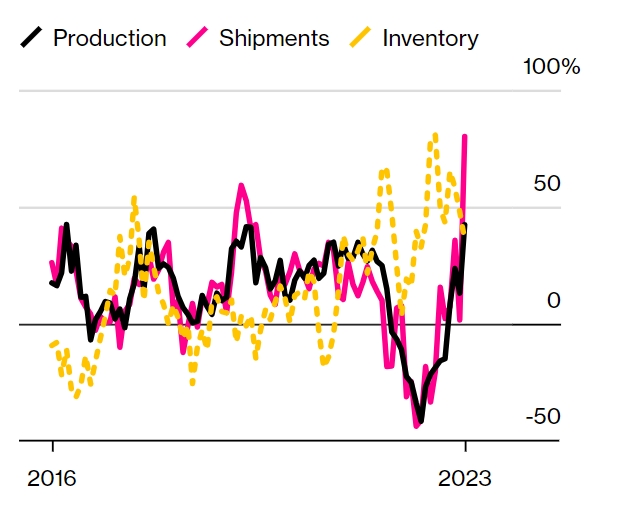
Korea supplies two-thirds of global memory production.
Jayce
/include/upload/kind/image/20240201/20240201171745_7339.png
In December, Korea’s semiconductor factory shipments rose 113.7% y-o-y – the biggest jump in a month since 1997, according to Statistics Korea, the national statistics office.
Inventories rose by 11.6% – the smallest rise since
2024/2/1 17:18:39
2024/2/1 17:18:39
45
0
528
6
Compound Semi Substrate Market Growing at 17% CAGR 2023-29
The compound semiconductor substrate market is expected to reach $3.3 billion in 2029, with a 17% CAGR between 2023 and 2029, says Yole Developpement.
Substrate players consistently craft new strategies to diversify their product portfolios and enhance their market presence.
Compound semiconductor technologies showcase diverse advancements across sectors:leg. SiC , GaN , InP and. have emerged as a transformative influence across various industries.
SiC’s dominance in the automotive sector, especially in the domain of 800V EVs , drives a billion-dollar market, while GaN power electronics is expanding its presence in both the consumer and automotive fields.
Yole expects a billion-unit opportunity in smartphone OVP (Over Voltage Protection) . In anticipation of a resurgence, RF GaAs aligns itself with 5G and automotive connectivity, while RF GaN establishes its presence in defense, telecommunications, and space industries, targeting high-power applications.
Within the realm of photonics, InP and GaAs take the lead, with InP experiencing a resurgence fueled by AI applications, while GaAs photonics sees more modest growth influenced by various market dynamics. Although MicroLEDs show potential, their widespread adoption is gradual,
“The CS industry is at the corner to transition to larger diameter substrates. In the Photonics sector,” saysYole’s Ali Jaffal, “AI is driving the demand of high-data-rate lasers, which could accelerate the transition to 6” InP substrates.
On the other side of the coin, GaAs explores 8” manufacturing for microLED, which is competing with OLED, facing yield and efficiency challenges, questioning its success but gaining momentum with substantial investments.”
Suppliers of GaAs and InP substrates, including Freiberger, Sumitomo Electric, and AXT, play a central role in the transition to larger diameter substrates. Photonics is part of this story, and the Power and RF markets further complement this narrative.

Wolfspeed is leading the change to supply SiC substrates for power electronics applications. It has recently transitioned to the larger 8” wafer fabs and is expanding its material capacity in line with its strategic vision.
Coherent, another leading player, focuses on photonic devices and dominates the SiC substrate market for both power and RF applications. It has made a number of strategic alliances, for example, with SEDI in RF GaN, to reinforce its position and has started supplying power SiC devices. Following these actions, it covers the whole value chain from substrates to advanced devices.
The landscape is continuously evolving, with multiple innovations on many fronts and strategic partnerships.
“Compound semiconductor technologies are advancing across sectors, notably in the booming SiC industry “ says Yole’s Taha Ayari “while 6” wafers are still standard, Wolfspeed’s $1.2 billion investment in MHV fab is pioneering the transition to 8″ wafer size. Other efforts focus on improving SiC wafer yield and supply, with innovations like engineered substrates from Soitec and Sumitomo Mining. Power GaN sees a shift to 8-inch GaN-on-Si, driven by expansion at Innoscience, STMicroelectronics, and Infineon Technologies”.
“RF GaN-on-Si is benefiting from synergies with the relatively more mature Power GaN to enter the telecom market and compete with established RF GaN-on-SiC technology,” says Yole’s Aymen Ghorbel, additionally, major changes in the RF GaN ecosystem, such as Wolfspeed RF business being acquired by Macom, could impact the RF GaN industry”.
Jayce
/include/upload/kind/image/20240131/20240131173146_0446.jpg
The compound semiconductor substrate market is expected to reach $3.3 billion in 2029, with a 17% CAGR between 2023 and 2029, says Yole Developpement.
Substrate players consistently craft new strategies to diversify their produ
2024/1/31 17:32:38
2024/1/31 17:32:38
49
0
527
5
Flyking Weekly Industry Express
Jayce
/include/upload/kind/image/20240129/20240129215239_4364.jpg
2024/1/29 21:53:21
2024/1/29 21:53:21
86
0
526
6
Hynix Surprises With Q4 Profit
Hynix had a Q4 profit of $260 million on revenues up 47.4% at $8.5 billion compared with a loss of $1.4 billion in Q4 2022.
For the full year of 2023, Hynix had a loss of $5.8 billion on revenues which fell 27% y-o-y to $24.6 billion.
“We achieved a remarkable turnaround in the fourth quarter following a protracted downturn, thanks to our technological leadership in the AI memory space,” said CFO Kim Woohyun.
Hynix is working with Nvidia on HBM memories and is about to start producing the latest iteration – HBM3E.
“We are smoothly preparing for mass production of HBM3E as demand for the chips will occur in earnest this year. We plan to supply them during the first half,” said a Hynix exec on the results call.
Jayce
/include/upload/kind/image/20240126/20240126205448_0759.jpeg
Hynix had a Q4 profit of $260 million on revenues up 47.4% at $8.5 billion compared with a loss of $1.4 billion in Q4 2022.
For the full year of 2023, Hynix had a loss of $5.8 billion on revenues which fell 27% y-o-y to $24.6 b
2024/1/26 20:54:50
2024/1/26 20:54:50
69
0
525
6
RAN Market Heads South
The RAN market is headed down, says Dell’Oro.
Following the >40% rise between 2017 and 2021, RAN revenues stabilised in 2022, and are on target to decline sharply in 2023.
Market conditions are expected to remain challenging in 2024 as the Indian RAN market pulls back, though the pace of the global decline this year and for the remainder of the forecast period should be more moderate.
“MBB (Mobile Broadband)-based investments are now slowing and the upside with new growth areas including FWA and private wireless is still too small to change the trajectory,” says Dell’Oro vp Stefan Pongratz, “also weighing on the MBB market is the fact that the upper mid-band capacity boost is rather significant relative to current data traffic growth rates in some markets, which could impact the timing for capacity upgrades.”.
Worldwide RAN revenues are projected to decline at a 1% CAGR over the next five years.
AsiaPac is expected to lead the decline, while easier comparisons following steep contractions in 2023 will improve the growth prospects in the North America region.
5G-Advanced is expected to play an important role in the broader 5G journey, however, it is not expected to fuel another major capex growth cycle.
TRAN segments that are expected to grow over the next five years include: 5G NR, FWA, mmWave, Massive MIMO, Open RAN, private wireless, small cells, and Virtualized RAN.
Ericsson CEO B?rje Ekholm says the telcos’ mobile infrastructure investments are “unsustainably low”.
Jayce
/include/upload/kind/image/20240124/20240124174356_2824.png
The RAN market is headed down, says Dell’Oro.
Following the >40% rise between 2017 and 2021, RAN revenues stabilised in 2022, and are on target to decline sharply in 2023.
Market conditions are expect
2024/1/24 17:44:32
2024/1/24 17:44:32
43
0
524
6
November Semi Sales Up 5.3% Y-o-Y
November semiconductor sales of $48 billion were up 5.3% on the November 2022 total of $45.6 billion and up 2.9% on the October 2023 total of $46.6 billion, says the SIA.
“Global semiconductor sales increased on a year-to-year basis in November for the first time since August 2022, an indication that the global chip market is continuing to gain strength as we enter the new year,” says SIA CEO John Neuffer, “looking ahead, the global semiconductor market is projected to experience double-digit growth in 2024.”
Regionally, year-to-year sales were up in China (7.6%), Asia Pacific/All other (7.1%), Europe (5.6%), and the Americas (3.5%), but down in Europe (-2.8%). Month-to-month sales increased in China (4.4%), the Americas (3.9%), and Asia Pacific/All Other (3.5%), but decreased in Japan (-0.7%) and Europe (-2.0%).

Jayce
/include/upload/kind/image/20240123/20240123173217_2762.png
November semiconductor sales of $48 billion were up 5.3% on the November 2022 total of $45.6 billion and up 2.9% on the October 2023 total of $46.6 billion, says the SIA.
“Global semiconductor sales increased on a year-to-ye
2024/1/23 17:33:24
2024/1/23 17:33:24
57
0
523
5
Flyking Weekly Industry Express
Jayce
/include/upload/kind/image/20240122/20240122174336_6706.jpg
2024/1/22 17:44:26
2024/1/22 17:44:26
65
0
522
6
TSMC Expects 25% Growth This Year
TSMC expects 25% growth this year after an 8.2% expected dip in Q1 revenues to between €18 billion and $18.8 billion.
In Q4, HPC revenues, including AI, grew 17% q-o-q, smartphone revenues grew 27% and auto grew 13%
Capex is expected to be between $28 billion and $32 billion.
Q4 net profit was 19.3% down y-o-y at $7.6 billion and Q4 gross margin was down 9.3% y-o-y.
For the semiconductor industry overall, TSMC expects growth of 10%.
TSMC has said its second Arizona fab will be delayed for a year. Hiring difficulties and the payment of US government subsidies were blamed.
The company repeated that its 3nm process, now in production, is more comparable to Intel’s 2nm process called 18A, which is due for production this year, than it is to TSMC’s 2nm process.
Jayce
/include/upload/kind/image/20240119/20240119175627_5432.jpg
TSMC expects 25% growth this year after an 8.2% expected dip in Q1 revenues to between €18 billion and $18.8 billion.
In Q4, HPC revenues, including AI, grew 17% q-o-q, smartphone revenues grew 27% and auto grew 13%
2024/1/19 17:56:54
2024/1/19 17:56:54
48
0
521
5
Holiday Notice for 2024 Chinese New Year
We would like to inform you about the holiday arrangements for the upcoming Chinese Spring Festival in 2024.
During this holiday period, please note that our offices will be closed, and regular business operations will be temporarily suspended.
We wish you all a joyful and relaxing holiday. Please arrange your work in advance and thank you for your understanding.
Below are the holiday close times and return to work times of Flyking offices. Please check.
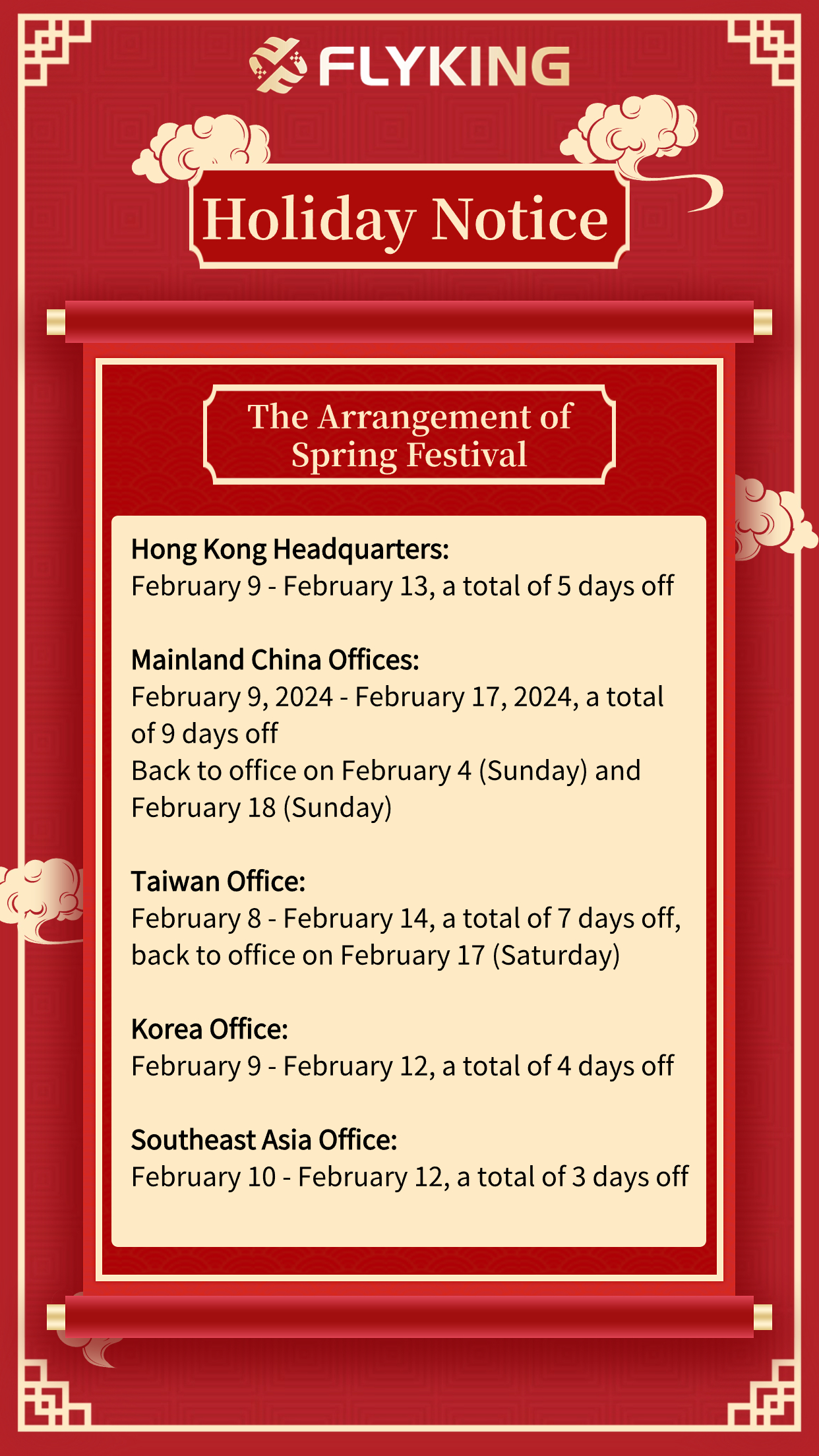
Jayce
/include/upload/kind/image/20240118/20240118175113_2613.png
We would like to inform you about the holiday arrangements for the upcoming Chinese Spring Festival in 2024.
During this holiday period, please note that our offices will be closed, and regular business operations will be temporarily s
2024/1/18 17:52:37
2024/1/18 17:52:37
96
0
520
6
IPhone Out-Ships Everyone
The last time a company not named Samsung was at the top of the smartphone market was 2010. Now it is Apple.
Smartphone shipments declined 3.2% year over year to 1.17 billion units in 2023, says IDC.
While this marks the lowest full-year volume in a decade, growth in the second half of the year has cemented the expected recovery for 2024.
Q4 saw 8.5% y-o-y growth and 326.1 million units shipped.
“While we saw some strong growth from low-end Android players like Transsion and Xiaomi in the second half of 2023, stemming from rapid growth in emerging markets, the biggest winner is clearly Apple,” says IDC’s Nabila Popal, “not only is Apple the only player in the Top 3 to show positive growth annually, but also bags the number 1 spot annually for the first time ever. Apple’s ongoing success and resilience is in large part due to the increasing trend of premium devices, which now represent over 20% of the market, fuelled by aggressive trade-in offers and interest-free financing plans.”


Jayce
/include/upload/kind/image/20240118/20240118173933_3608.jpg
The last time a company not named Samsung was at the top of the smartphone market was 2010. Now it is Apple.
Smartphone shipments declined 3.2% year over year to 1.17 billion units in 2023, says IDC.
While this m
2024/1/18 17:39:38
2024/1/18 17:39:38
63
0
519
6
PC Slump Continues
Q4 PC shipments of 67.1 million were down 2.7% y-o-y, reports IDC. It was the eighth consecutive quarter of y-o-y shipment volume contraction and the lowest Q4 volume since 4Q06.
In 2022, shipments fell 16.5% y-o-y and preliminary results suggest an additional 13.9% contraction in 2023 compared to 2022.
The top companies in the industry remain largely unchanged, and just like the overall market, they too are experiencing unusual quarterly growth swings.

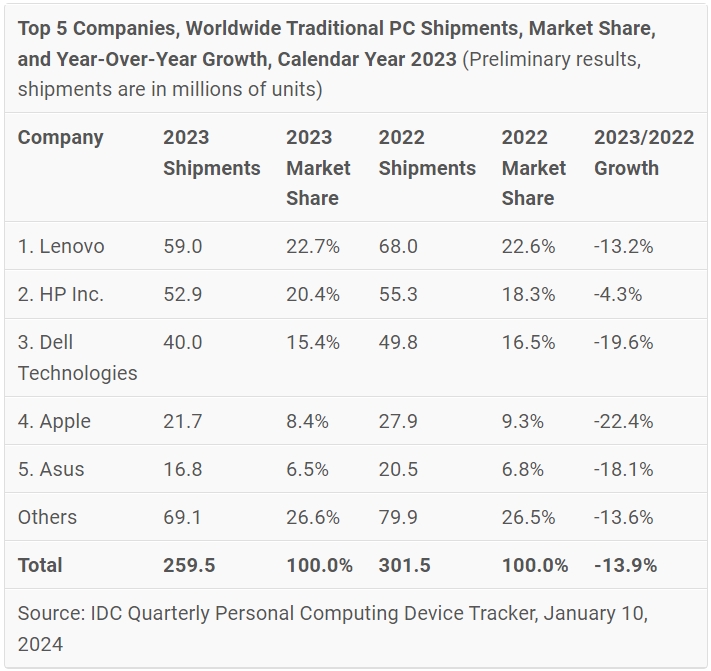
Notes:
-
Traditional PCs include Desktops, Notebooks, and Workstations and do not include Tablets or x86 Servers. Detachable Tablets and Slate Tablets are part of the Personal Computing Device Tracker but are not addressed in this press release.
-
Shipments include shipments to distribution channels or end users. OEM sales are counted under the company/brand under which they are sold.
Jayce
/include/upload/kind/image/20240116/20240116173602_2964.jpg
Q4 PC shipments of 67.1 million were down 2.7% y-o-y, reports IDC. It was the eighth consecutive quarter of y-o-y shipment volume contraction and the lowest Q4 volume since 4Q06.
In 2022, shipments fell 16.5% y-o-
2024/1/16 17:36:03
2024/1/16 17:36:03
38
0
518
5
Flyking Technology's 2024 Annual Celebration: Beyond Boundaries, Advancing Beyond
As we delve into a new year filled with aspirations and possibilities, Flyking Technology proudly reflects on the resounding success and memorable moments of our 2024 Annual celebration. With the invigorating theme of "Beyond Boundaries, Advancing Beyond," our celebration held on January 13th in Jiangmen was a testament to our collective achievements and a testament to our unwavering commitment to excellence.

This year's annual celebration blended traditional Chinese culture. The setting and venue arrangement promise surprises and anticipation for everyone. Through captivating award ceremonies, New Year's blessings, performances, recreational activities, and social responsibility initiatives, we comprehensively review the company's journey of dedication over the past year. Simultaneously, we eagerly embrace the challenges of 2024 with full enthusiasm


Commendable Milestones
Expanding our global footprint, we proudly established ten new offices worldwide, reinforcing our commitment to offering exceptional services and accessibility to our customers. These strategic expansions included new offices in the Netherlands, South Korea, and Singapore, complementing our existing presence in China, Germany, and the United States.

“In 2023, the semiconductor industry faced tough challenges due to poor market conditions, weak demand, and ongoing destocking in the supply chain. However, entering 2024, there are signs of recovery, making it a potentially transformative year. Despite the challenges, we remain committed to the philosophy of "service first, customer foremost." Throughout 2024, we aim to provide more efficient and professional value services to our customers in areas like supply chain services, quality control, delivery, and market insights. Let's journey together towards a brighter future in 2024.”
The speech delivered by our CEO stands as the ultimate guide for all Flyking colleagues, inspiring ceaseless dedication and unwavering progress.
Outstanding Flyking Family Members
The year 2023 was a significant chapter in our journey marked by remarkable milestones and achievements. In the face of market challenges, we have withstood the pressure and improved both the quality and breadth of our company's services. And all this effort could not be done without our employees. We awrded them and present them with recognition at the annual celebration.


Outstanding employees are the most valuable asset of the company, serving as the backbone behind the company's achievements. Their capabilities and talents showcased at work are indispensable resources for the company. Especially for those colleagues at Flyking Technology who have dedicated over five years, we extend to them our utmost respect.


Let us collectively wish these outstanding employees further success, as we join hands to script a more brilliant and prosperous chapter in the upcoming year!
Social Responsibility and Community Engagement
In tandem with our professional endeavors, Flyking Technology remains steadfast in our commitment to social responsibility. Strengthening our support for public welfare, we extended aid to various causes, including the donation to Naba Primary School in Guangxi. Such as providing living essentials, educational materials, and scholarships to local underprivileged students.
We also donated 50 thousand Yuan to Fill the World With Love Foundation in our 2024 Annual Celebration. This steadfast commitment reflects our belief in giving back and fostering a positive impact beyond business realms.
Garden Party and Live show
Celebrating the New Year with a colorful Garden Party, we welcome the new year with joyous laughter. One of the highlights of this annual celebration is the Garden Party, featuring eight gaming zones such as sandbag tossing, treasure-grabbing battles, lantern riddles, joyous ring-toss, quick eyes and hands, happy soccer, electric maze, and amusing bowling. Each activity is filled with fun and challenges, offering participants the opportunity to collect stamps and exchange them for prizes.

Moreover, the passionate band performance ignited the atmosphere at the venue, spanning from rock music to pleasing pop tunes. We were immersed in the music, and the combination of live KTV further added a touch of enthusiasm to the celebration. It was a moment to relax, and showcase talents, and colleagues danced to the rhythm of the music, gradually spreading a joyful ambiance.

Moving Forward in 2024
The Annual celebration served as a beacon of inspiration, fostering camaraderie, and setting the tone for a purposeful year ahead. Guided by our core values of Integrity, Accountability, Innovation, and Inclusion, Flyking Technology remains resolute in delivering unparalleled services and contributing positively to society.
As we step into the future, we carry with us the invaluable experiences and successes of the past. Our collective efforts and dedication to growth have paved the way for an exciting journey ahead, filled with innovation, resilience, and a commitment to excellence.
Stay tuned for more updates and announcements as we embark on another transformative year at Flyking Technology!
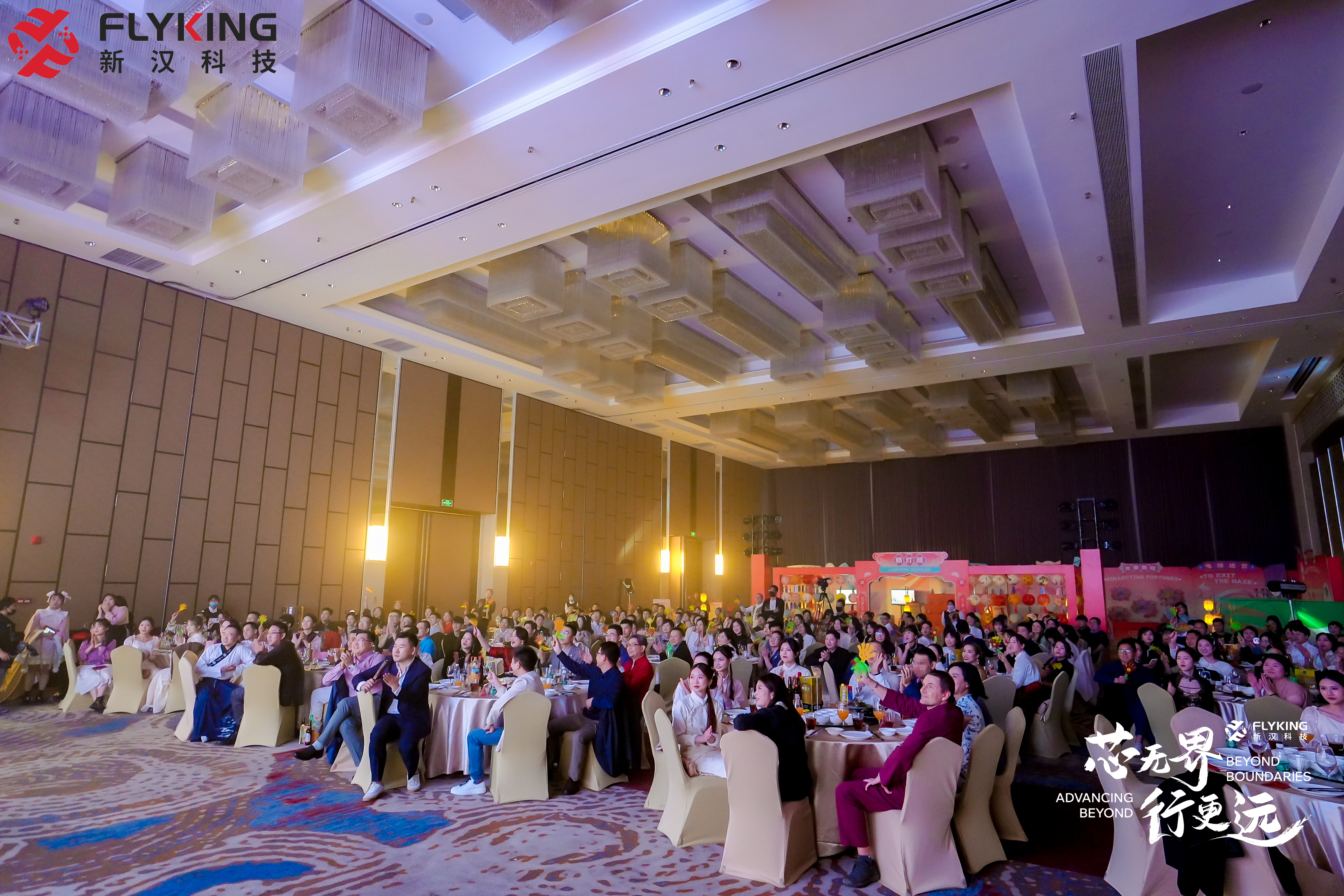
Jayce
/include/upload/kind/image/20240115/20240115184304_1209.png
As we delve into a new year filled with aspirations and possibilities, Flyking Technology proudly reflects on the resounding success and memorable moments of our 2024 Annual celebration. With the invigorating theme of "Beyond Boundaries, Advancing
2024/1/15 19:01:48
2024/1/15 19:01:48
72
0
517
5
Flyking Weekly Industry Express
Jayce
/include/upload/kind/image/20240115/20240115184208_1197.jpg
2024/1/15 18:42:24
2024/1/15 18:42:24
90
0
516
6
November semi sales up 5.3% y-o-y
November semiconductor sales of $48 billion were up 5.3% compared with the $45.6 billion of November 2022 and 2.9% up on the October 2022 total of $46.6 billion, says the SIA.
“Global semiconductor sales increased on a year-to-year basis in November for the first time since August 2022, an indication that the global chip market is continuing to gain strength as we enter the new year,” says SIA CEO John Neuffer, “looking ahead, the global semiconductor market is projected to experience double-digit growth in 2024.”
Regionally, year-to-year sales were up in: China (7.6%), Asia Pacific/All other (7.1%), Europe (5.6%), and the Americas (3.5%), but down in Europe (-2.8%).
Month-to-month sales increased in: China (4.4%), the Americas (3.9%), and Asia Pacific/All Other (3.5%), but decreased in Japan (-0.7%) and Europe (-2.0%).

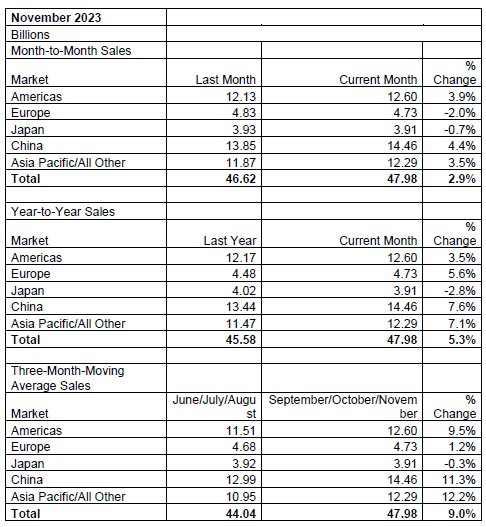
Jayce
/include/upload/kind/image/20240112/20240112200729_2630.png
November semiconductor sales of $48 billion were up 5.3% compared with the $45.6 billion of November 2022 and 2.9% up on the October 2022 total of $46.6 billion, says the SIA.
“Global semiconductor sales increased on a year-to-year
2024/1/12 20:10:06
2024/1/12 20:10:06
65
0
515
6
US gears up for Chinese dumping of legacy ICs
The US is preparing for a tsunami of legacy ICs from China.
Two Congressmen have written to US Secretary for Commerce, Gina Raimondo, expressing concern that China is “on track to flood the United States and global markets with foundational semiconductors.”
By ‘foundational’ they mean chips made on older nodes than 28nm.
In the 50nm to 180 nm range, China currently controls around 30% of global capacity and within a decade could control around 46%, says a Rhodium Group report.
The Congressmen are proposing import duties on ICs rather than duties on finished goods containing ICs.
The Commerce Department is initiating a survey this month to find out how US companies source legacy ICs.
Jayce
/include/upload/kind/image/20240111/20240111184803_3925.jpg
The US is preparing for a tsunami of legacy ICs from China.
Two Congressmen have written to US Secretary for Commerce, Gina Raimondo, expressing concern that China is “on track to flood the United States and global markets with founda
2024/1/11 18:48:34
2024/1/11 18:48:34
53
0
514
6
Memory Prices Surging
Q1 NAND and DRAM prices are set to rise significantly, reports TrendForce.
DRAM contract prices are estimated to increase by approximately 13–18% in 1Q24 with mobile DRAM leading the surge.
It appears that due to the unclear demand outlook for 2024, manufacturers believe that sustained production cuts are necessary to maintain the supply-demand balance in the memory industry.
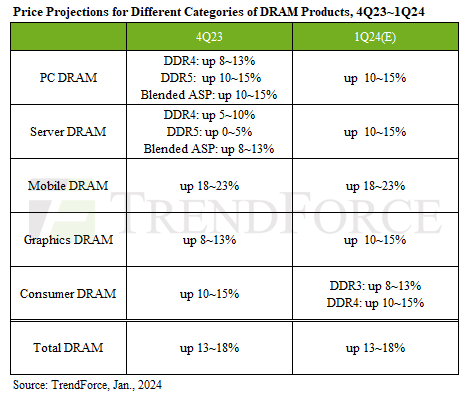
Despite facing a traditional low-demand season, buyers are continuing to increase their purchases of NAND Flash products to establish safe inventory levels.
In response, suppliers, aiming to minimise losses are pushing for higher prices, leading to an estimated 15–20% increase in NAND Flash contract prices in 1Q24.
A key point to note is the aggressive price hike initiated by NAND Flash manufacturers to offset losses. But, with demand struggling to keep pace with these rapid increases, future price escalations hinge on the resurgence of enterprise SSD procurement.

Jayce
/include/upload/kind/image/20240110/20240110183446_8504.jpeg
Q1 NAND and DRAM prices are set to rise significantly, reports TrendForce.
DRAM contract prices are estimated to increase by approximately 13–18% in 1Q24 with mobile DRAM leading the surge.
It appears that due to the
2024/1/10 18:35:56
2024/1/10 18:35:56
51
0
513
6
China Looking for EV Export Markets as US and EU Look at Restrictions
12.8 million EVs were sold last year (including BEVs (Battery EVs, PHEVs (Plud-In Hybrid EVs) , and FCVs (Fuel Cell Vehicles), says TrendForce.
Regional market sales shares were expected to be 60% in China, 22% in Western Europe, 11% in the US, and 6% in other regions.
With China’s subsidies gradually phasing out, the increasing market penetration of NEVs in the country and growing demand for EVs overseas, Chinese EV manufacturers are looking to expand internationally, particularly in Southeast Asia, where they are projected to hold a 67.5% market share in 2023.
TrendForce forecasts that China will export about 4.8 million automobiles in 2023, with NEVs making up approximately 25% of these exports.
The rising export volumes are exercising have caught governments worldwide as they try to balance the protection of local companies , maintaining competitiveness, and managing consumer costs.
For example, the US imposes a 25% tariff on vehicle imports from China, states that EVs and their batteries be assembled in North America and says that critical minerals in the batteries must originate from countries that have signed free trade agreements with the US to qualify for subsidies totalling US$7,500. As such, the Chinese supply chain is excluded.
The EU has initiated an anti-subsidy investigation against Chinese-made EVs, and France’s new subsidy regime for EVs requires compliance with carbon emission standards during manufacturing, effectively excluding many EVs imported from China
Jayce
/include/upload/kind/image/20240110/20240110013233_6299.png
12.8 million EVs were sold last year (including BEVs (Battery EVs, PHEVs (Plud-In Hybrid EVs) , and FCVs (Fuel Cell Vehicles), says TrendForce.
Regional market sales shares were expected to be 60% in China, 22% in Western Europe, 1
2024/1/10 1:33:32
2024/1/10 1:33:32
52
0
512
5
Flyking Weekly Industry Express
Jayce
/include/upload/kind/image/20240108/20240108181837_5087.jpg
2024/1/8 18:18:58
2024/1/8 18:18:58
66
0
511
6
China Projected To Export 1.2 Million NEVs In 2023 Amid Tightening Tariffs By The US, Says TrendForce
TrendForce reports that the global sales volume of NEVs (including BEVs, PHEVs, and FCVs) is estimated to reach approximately 12.8 million units in 2023. Regional market sales shares are expected to be 60% in China, 22% in Western Europe, 11% in the United States, and 6% in other regions, with China’s market demand distinctly in the lead. However, with China’s subsidies gradually phasing out and the increasing market penetration of NEVs in the country, the growth rate of China’s NEV market is starting to slow. This, coupled with the growing demand for electric vehicles in overseas markets, is prompting numerous Chinese automotive brands to expand internationally, particularly in Southeast Asia, where they are projected to hold a 67.5% market share in 2023.
Benefiting from early government and industry initiatives and supported by a large domestic market, China’s EV industry has developed a complete supply chain and cost advantages due to rapid technological evolution driven by intense competition. TrendForce forecasts that China will export about 4.8 million automobiles in 2023, with NEVs making up approximately 25% of these exports. The rising export volumes have caught the attention of governments worldwide, especially since many major manufacturers, not just Chinese brands, have factories in China. Exporting vehicles from China to other markets could reduce local production volumes and values of complete vehicles and components, further impacting employment rates and economic performance.
TrendForce notes that the automotive industry is currently facing high raw material and labor costs, as well as significant investments in electrification and autonomous driving. Balancing the protection of local enterprises, maintaining competitiveness, and managing consumer costs is an urgent task for governments worldwide. Most countries are focusing on the country of origin rather than the brand of vehicles in their restrictive measures. For example, the United States imposes a 25% tariff on vehicle imports from China and is discussing further increases.
Measures taken by the US—specifically for EVs—include requiring that EVs and their batteries be assembled in North America. Furthermore, critical minerals in the batteries must originate from countries that have signed free trade agreements with the US to qualify for subsidies totaling US$7,500. As such, the Chinese supply chain is excluded. The EU has initiated an anti-subsidy investigation against Chinese-made EVs, and France’s new subsidy regime for EVs requires compliance with carbon emission standards during manufacturing, effectively excluding many EVs imported from China.
Overall, under the restrictive measures imposed by various governments, international manufacturers need to assess tariffs, subsidies, and production costs before deciding on their production locations. TrendForce suggests that for Chinese automakers seeking to expand overseas, the high cost of exporting vehicles from existing factories in China could diminish their price competitiveness. Despite this, countries like Italy, Hungary, Thailand, and Indonesia maintain a positive stand toward Chinese automakers setting up local factories—given their significant advantages in the EV market.

Jayce
/include/upload/kind/image/20240105/20240105171145_4342.png
TrendForce reports that the global sales volume of NEVs (including BEVs, PHEVs, and FCVs) is estimated to reach approximately 12.8 million units in 2023. Regional market sales shares are expected to be 60% in China, 22% in Western Europe, 11% in th
2024/1/5 17:12:26
2024/1/5 17:12:26
55
0
510
6
China’s Manufacturing PMI Falls For Third Month In A Row Highlighting 2024 Challenges For World’s Second-Biggest Economy
China’s key factory activity gauge closed the year with a contraction for a third straight month, suggesting that the world’s second-biggest economy may need more policy support to accomplish Beijing’s economic stabilisation goals in 2024.December’s official manufacturing purchasing managers’ index (PMI) fell to 49 from November’s 49.4, according to data from the National Bureau of Statistics released on Sunday.
This was much worse than the median forecast for 49.5 in a Reuters poll, as China’s first post-Covid year ended with a weaker-than-expected recovery.Earlier this year, PMI readings fell for five months in a row starting in April. After a brief expansion in September, they started falling again in October.
A reading above 50 typically indicates expansion of activity, while a reading below that suggests a contraction.
The statistics bureau pointed to an “increasingly complicated, tough and uncertain” external environment as a key reason for the continued fall.
Jayce
/include/upload/kind/image/20240103/20240103181948_4831.jpg
China’s key factory activity gauge closed the year with a contraction for a third straight month, suggesting that the world’s second-biggest economy may need more policy support to accomplish Beijing’s economic stabilisation goals in 2024.Decemb
2024/1/3 18:20:09
2024/1/3 18:20:09
66
0
509
6
Q3 PC Shipments Down 7.2% Y-o-Y
Q3 PC shipments were 7.2% down y-o-y at 68.5 million units in the third quarter of 2023, according to IDC, which expects full-year 2023 shipments to be down 13.8% y-o-y which was itself a 16.6% down year on 2021.
Two consecutive years of double-digit year-over-year drops is unprecedented in the PC market.
IDC’s hopes for a market rebound in 2024 rest on:
PC Refresh Cycle: The vast and aging installed base of commercial PCs surpassing the four-year mark by 2024 is expected to necessitate a refresh, coinciding with the pressing demand to migrate toward Windows 11. The total PC market of 2024 should see growth of 3.4% compared to 2023.AI Integration: The integration of AI capabilities into PCs is expected to serve as a catalyst for upgrades, hitting shelves in 2024 and at first aimed toward certain segments of the enterprise PC market. Over time, further advancement in use cases and cost reductions could spread to the broader market.Continued evolution and recovery of the consumer installed base.Beyond 2024, growth is expected to surpass pre-pandemic shipment levels and culminate in 285 million units by 2027.
“Perhaps historical context can offer some consolation to the tough slog the PC ecosystem is going through,” says IDC’sc Jay Chou, “while we still expect eight consecutive quarters of year-over-year volume declines from Q1 2022 through Q4 2023, it still pales to the 19 consecutive quarters of year-over-year PC declines from Q2 2012 to Q4 2016. Furthermore, notebooks are already at higher levels than 2019, signaling a sizable expansion of the notebook market even after COVID-induced purchases have subsided. We maintain that factors like hybrid work, commercial refresh, and growth in premium PCs can lead to a compound annual growth rate of 3.1% from 2023 through 2027.”

Jayce
/include/upload/kind/image/20240102/20240102180159_7380.jpg
Q3 PC shipments were 7.2% down y-o-y at 68.5 million units in the third quarter of 2023, according to IDC, which expects full-year 2023 shipments to be down 13.8% y-o-y which was itself a 16.6% down year on 2021.
Two cons
2024/1/2 18:02:01
2024/1/2 18:02:01
69
0
508
5
Flyking Weekly Industry Express
Jayce
/include/upload/kind/image/20240102/20240102175717_3493.jpg
2024/1/2 17:57:54
2024/1/2 17:57:54
84
0
507
6
Korea’s Soaring Semis
Korean semiconductor production rose 42% in November while shipments rose 80% says Statistics Korea.

The November rise was the largest increase in 18 months. November inventories rose by 36% – the smallest rise since February.

Korea’s economy grew 5.3% in November. It is expected to grow 1.4% in 2023, down from 2.6% in 2022, and forecast to grow 2.2% in 2024.
Jayce
/include/upload/kind/image/20231228/20231228181739_1585.png
Korean semiconductor production rose 42% in November while shipments rose 80% says Statistics Korea.
2023/12/28 18:18:23
2023/12/28 18:18:23
73
0
506
5
Flyking Technology's Annual Journey, Witnessing Our 2023
In a year marked by challenges and opportunities, Flyking Technology has made remarkable strides and achievements. We persevered and advanced. With resilience and innovation, we've conquered obstacles and achieved remarkable progress. Join us as we highlight the pivotal moments of this remarkable journey.
Annual Data
4,000+: As of now, Flyking has served over 4000 global intelligent manufacturing enterprises.
80,000+: Sales exceed 80,000 part numbers, setting a historical record.
10+: Deepening global layout, establishing over 10 global offices.
Annual Keywords
Further Journey: To better serve global customers, we established new offices in the Netherlands, South Korea, and Singapore, collaborating with our offices in China, Germany, and the United States. We are dedicated to becoming a long-term trusted partner in the electronic component supply chain for customers. In the future, Flyking will further enhance local characteristics to provide more efficient and convenient supply chain services to global customers!
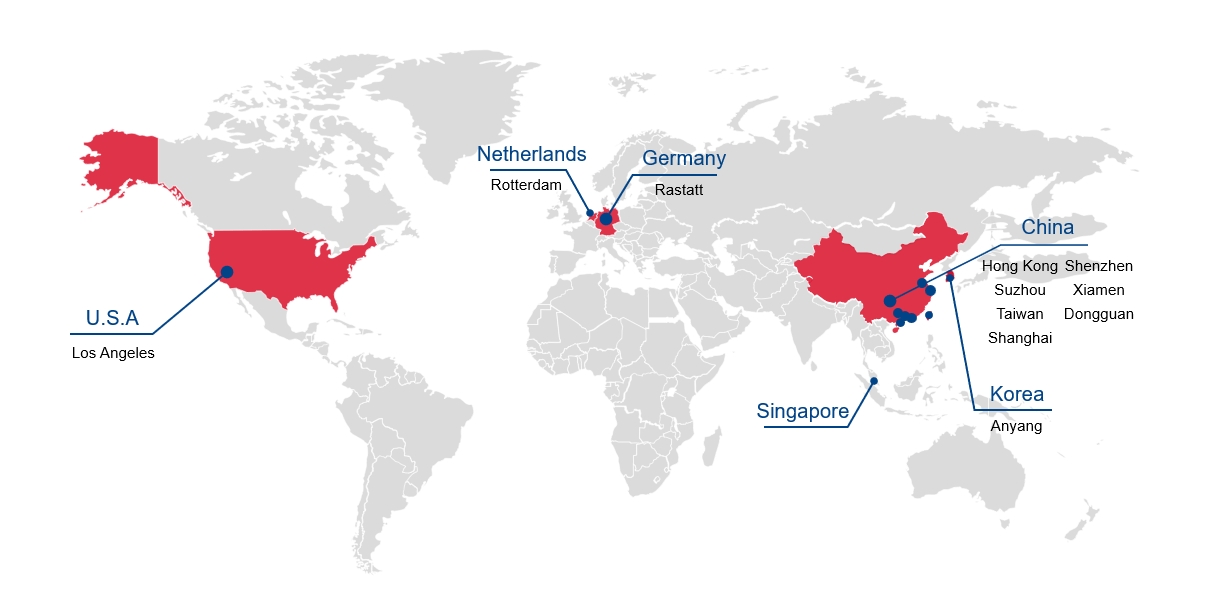
Wider Recognition: In 2023, Flyking Technology was awarded the "Outstanding Distributor in Supply Capability " by Aspencore. This honor was jointly selected by global senior editors and website users in Asia, the Americas, and Europe. Such an award represents the industry's high recognition of Flyking Technology's outstanding services in the electronic component distribution field, and also the highest affirmation of Flyking Technology's over a decade of relentless efforts and excellence in the semiconductor industry.

Higher Standards: Over the past year, Flyking Technology comprehensively upgraded its quality control system, successfully obtaining ISO9001:2015, ISO45001:2018, ISO14001:2015, and ESD S20.20 system certifications issued by the internationally renowned certification organization, SGS. This is not merely a professional certificate but also the highest execution standard for Flyking to provide reliable, quality services to customers, motivating Flyking to become a more trustworthy international distributor.
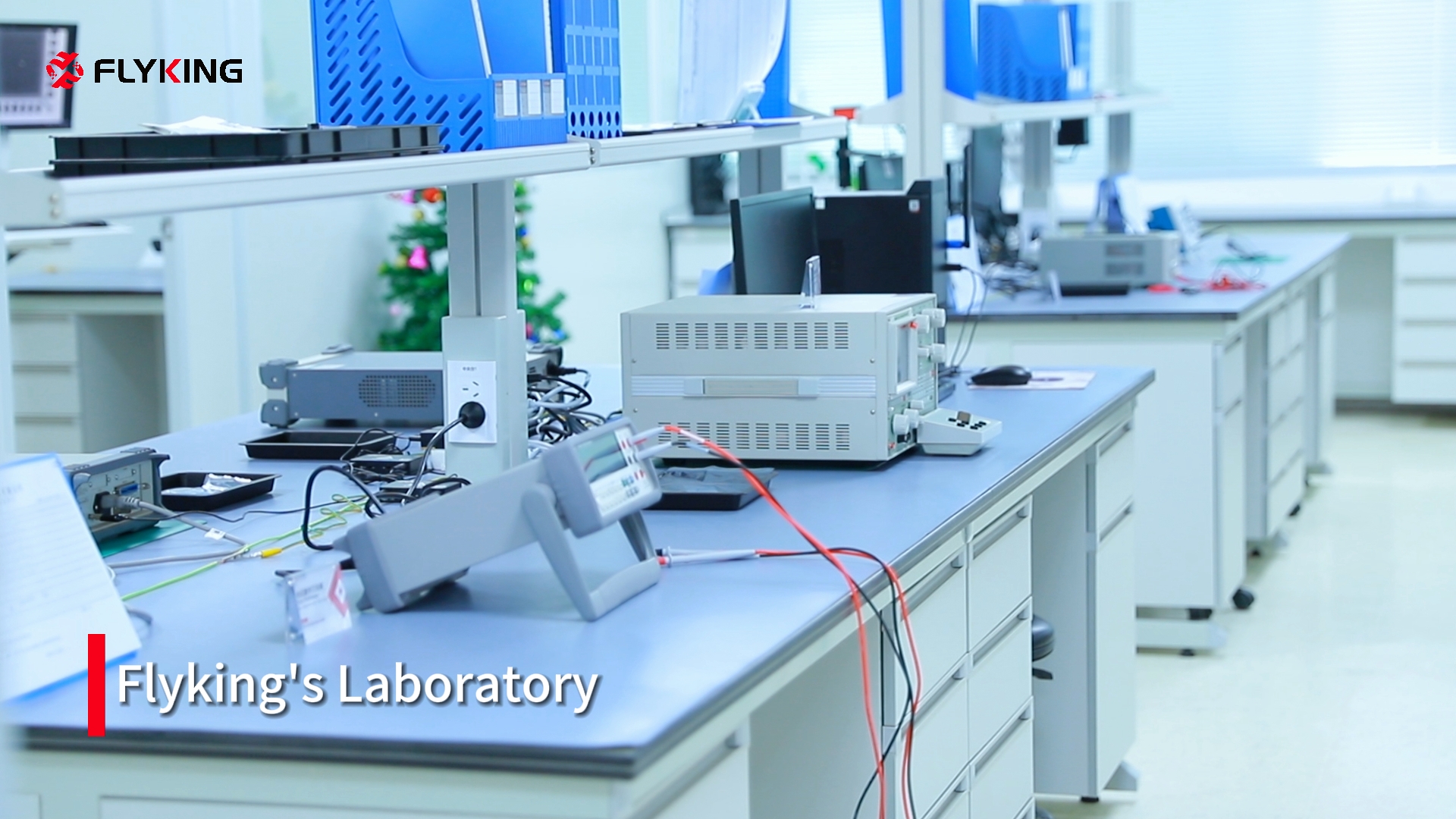
Greater Responsibility: As the company continues to grow, Flyking Technology consistently upholds the concept of giving back to society and fulfilling social responsibilities. This year, we further increased our support for public welfare, donating 250 sets of school uniforms to Naba Primary School in Guangxi, and providing living, learning materials, and scholarships to several local underprivileged students. We deeply understand that responsibility comes from gratitude, and our mission stems from commitment. In the future, Flyking Technology will actively participate in public welfare activities in diverse ways, striving to fulfill the profound sense of social responsibility required to build a company with an international perspective.

Annual Events

As we stand on the threshold of a new year, let us carry the pride and confidence from our past achievements forward. Our journey may hold challenges, yet it's these challenges that have shaped our resilience and wisdom. Gratitude to every individual who has contributed to our collective success; let us stride into the future. Hello In the upcoming year, let's stand shoulder to shoulder, crafting a brighter tomorrow together.
Jayce
/include/upload/kind/image/20231228/20231228175617_3446.png
In a year marked by challenges and opportunities, Flyking Technology has made remarkable strides and achievements. We persevered and advanced. With resilience and innovation, we've conquered obstacles and achieved remarkable progress. Join us as we
2023/12/28 18:14:40
2023/12/28 18:14:40
105
0
505
6
Toshiba to Focus on PMICs, Infrastructure Opportunities and 10% Profit, Says CEO
Toshiba’s initial focus since going private on Wednesday will be on PMICs and making a ten percent operating profit, said CEO Taro Shimada (pictured) earlier today.
“In the short-term, expanding sales of power semiconductors is the first thing Toshiba should do,” said Shimada, “we’d like to ramp up the capacity as early as possible. Power semiconductors are selling like hotcakes because of strong demand for EVs.”Earlier this month Toshiba and Rohm announced a hook-up in PMICs.
Costs imposed by debt for the buy-out mean cost-cutting measures are needed and its four business units – energy, infrastructure, digital solutions and electronic devices – will consolidated and back-office efficiencies implemented.
Shimada said he expects the operating margin target of 10% to be achieved “early.”
“The issue with Toshiba was that it was unable to make any decisions and move forward,” Shimada said.
Shimada sees the data streams generated by Toshiba’s infrastructure businesses – power plants, trains, elevators, retail point-of-sales systems and water treatment systems – as the basis for initiating digital services revenue streams
“Once we are able to monetise the data from our equipment, profitability will easily surpass 10%,” Shimada said.
Shimada, a former Siemens exec, said that climate-related technologies like bendable solar panels, carbon capture systems, measuring industrial emissions and next-generation nuclear power technologies are longer term opportunities.
Jayce
/include/upload/kind/image/20231225/20231225171908_1187.jpg
Toshiba’s initial focus since going private on Wednesday will be on PMICs and making a ten percent operating profit, said CEO Taro Shimada (pictured) earlier today.
“In the short-term, expanding sales of power semiconductors is the
2023/12/25 17:20:08
2023/12/25 17:20:08
85
0
504
5
Flyking Weekly Industry Express
Jayce
/include/upload/kind/image/20231225/20231225171125_2943.jpg
2023/12/25 17:11:52
2023/12/25 17:11:52
90
0
503
6
Sensors in cars
5.4 billion sensors, including imaging sensors, magnetic sensors, MEMS pressure sensors among many others, for the automotive market were shipped in 2022, says Yole Developpement, and with a 7% CAGR between 2022 and 2028, 8.3 billion sensors will be shipped in 2023.
For standard, or legacy, image sensors little has changed in terms of the main players, which remain onsemi, Omnivision and Sony. What has changed as safety features evolve, has been an increase in resolution, from 1-2Mpixel to today’s 8Mpixel cameras.
“We see the adoption of more and different sensors due to regulations and in-vehicle comfort levels. There are two routes to autonomous driving – incrementally from L2 to L4 or transitioning directly to L4 and robotaxis,” says Yole’s Yu Yang, “but this is proving more difficult than people first thought.”
On May 31, 2023, the NHTSA, in the US, proposed introducing a new standard that would make AEB mandatory for light-duty cars and trucks within four years of publication.
This regulation would be more stringent and would require detecting pedestrians even in dark conditions. This later condition could be a game changer as current AEB (Automatic Emergency Braking) works well with a radar and a visible camera, but this hardware have very low performance in dark conditions. That would mean that OEMs could implement another sensor to fulfil this condition.
Thermal cameras are insensitive to low light emissions making them superior to emergency braking systems based on a camera and radar. Thermal cameras perform well when the road bends, in poor weather or in low light conditions.
Adding an algorithm for pedestrian detection would be straightforward and this could be a great opportunity for thermal cameras to finally enter the automotive industry, but the cost of a thermal camera compared to a visual one is still the main obstacle to adoption.
Other sensors like gated imaging cameras or LiDAR could also be used to meet the performance required by this new AEB regulation.
The automotive camera and image sensor markets have seen substantial revenue growth due to increased demand and higher prices driven by safety regulations and the chip shortage.
The automotive camera market should rise from 5.4 billion to $9.4 billion in 2028, a CAGR of 9.7%. ADAS cameras will be present in 94% of cars by 2028, while in-cabin cameras for DMS (Driver Monitoring System) and OMS (Occupancy Monitoring System) will experience rapid growth.
The number of radar modules per car will increase from 1.7 in 2022 to 3.1, on average, in 2028. As a result, the automotive radar module is expected to realise a CAGR of 12% between 2022-2028, growing from $6.7 billion to $13.5 billion. 4D radar is expected to dominate and therefore generate around 60% of the market revenue in 2028.
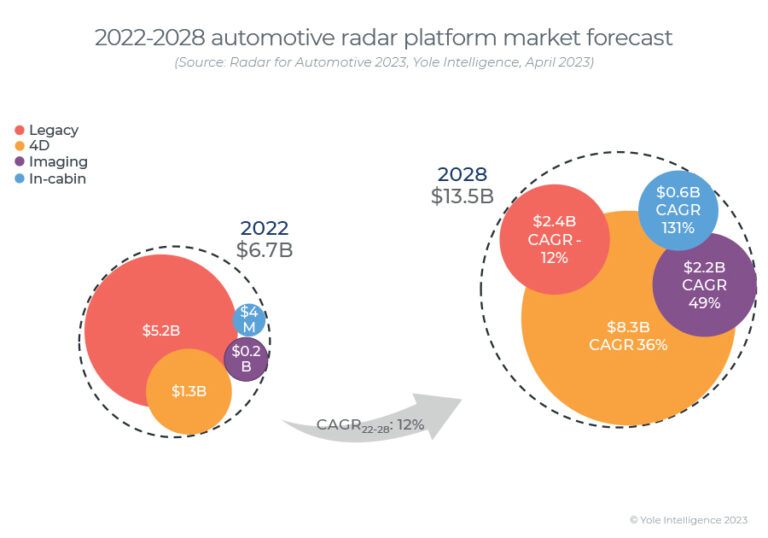
To replace legacy radar, 4D radar comes with the elevation capability and a better resolution. Indeed, 4D radar brings 1° angular resolution which dramatically improves object differentiation compared with 3D radar, which has an angular resolution of 4-6°. But such an increase in performance requires more computing power to process all these data.
Here, innovation is being driven by Arbe Robotics (More News), Uhnder and Metawave. These start-up companies are either using [AMD/Xilinx] FPGAs or, in the case of Arbe Robotics, producing their own ASICs to replace classic MCUs.
In 2023, the computing is usually embedded in the radar module, but in the coming years, we expect to see an increase in the computing part being separated from the radar module.
The LiDAR market for passenger cars has increased 285% since 2021. In 2022, and for the first time, the market for LiDAR in passenger vehicles surpassed the LiDAR market for robotaxis. The LiDAR adoption is driven by Chinese OEMs and in particular new ones making fully electric vehicles.
Innovusion, Valeo, Hesai and RoboSense lead this market (More news about LiDAR companies: Here). Valeo has dominated the passenger cars LiDAR market shares, with partnerships with Audi and Mercedes, for example, but dropped from 79% market share in 2021 to 24% in 2022, with the emergence of Chinese suppliers.
In 2022, Innovusion was leading the market thanks to its partnership with Nio but as the LiDAR market is quite young, we expect that the ranking could change rapidly. Indeed, Hesai and Robosense have partnered with more than 14 OEMs each and their respective market shares should change in 2023 and 2024.
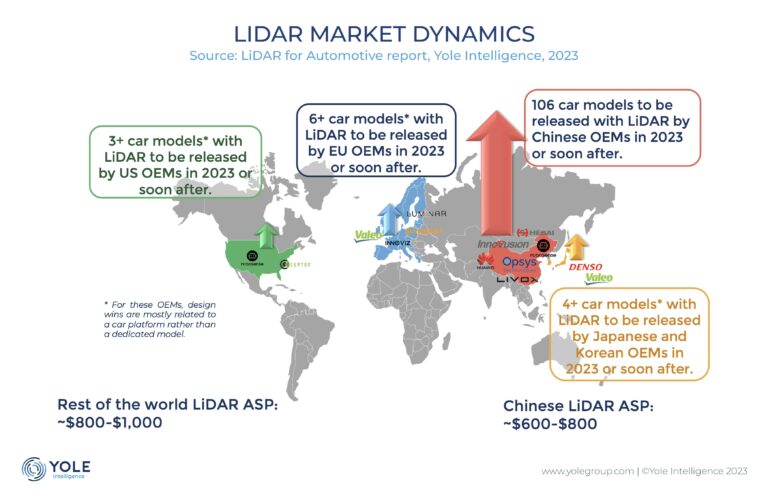
Chinese OEMs are rapidly implementing LiDAR using local suppliers to the extent that Chinese LiDAR manufacturers controlled 73% of the market in 2022. They have little traction in Europe, mostly because there are no large programs from OEMs yet and the market is limited to high end, low volume vehicles, mostly supplied by Valeo.
Another consideration relates to an earlier discussion about electrification. China was incentivised to begin electrification 20 years ago and is now developing new platforms for ADAS and AD, which will implement more and more sensors, including LiDAR, camera and radar,” says Yole’s Pierrick Boulay, “for example, the latest BYD model, the Yangwang U8 SUV has 24 sensors between camera, radar and LiDAR, which is more than the fourth-generation of Waymo robotaxi, implementing only 18 of them.
An increasing number of sensors having better performance in terms of range and resolution directly impacts the need for computing power in passenger cars. Computing revenue for ADAS and cockpit processor is increasing quickly, with a 13% CAGR between 2022 and 2028 and reaching a value of $12.7 billion in 2028.
Among these two categories, ADAS is the largest segment, representing more than 60% of the revenue in 2028.

Mobileye has dominated the automotive vision processor market for a long time, accounting for 52% market share in 2022, followed by players like AMD, Nvidia or Tesla.
The cockpit processor market is dominated by Qualcomm, a new player compared to competitors, Renesas or NXP.
Qualcomm entered the automotive market through the cockpit, leveraging its knowledge in user experience, acquired in the smartphone market. But the ultimate goal of Qualcomm is not the cockpit market, it is the much more lucrative ADAS market. Yole expects that Qualcomm will rapidly gain some market share in the ADAS domain and quickly become a significant player to compete with Mobileye.
Already some players, such as BMW and Volkswagen, are moving away from Mobileye to Qualcomm. Other new players e.g., Nvidia, Horizon Robotics and Black Sesame have a low but rapidly growing market share,thanks to partnerships with Chinese OEMs.
Today, Chinese companies like Horizon Robotics, Black Sesame or Hisilicon, among others, are gaining design wins and their market share is expected to increase significantly in the next five years. They are very active in both ADAS and cockpit domains.
In 2023, several car models from Chinese OEMs were released with a number of sensors that was much higher compared to other car models released by European or US OEMs. But these Chinese cars are still classified in the hands-off category, like Tesla to give a comparison, due to a lack of regulation.
If the regulation changes, we could expect more complex automated driving applications that would be enabled via OTA updates, as the sensor and computing hardware is already in place.
Regarding eyes-off applications, there is no regulation in place in China to allow such applications, but Chinese OEMs are developing NOA (Navigation On Autopilot) systems. Regarding the rest of the world, eyes-off regulation is already in place in Japan, Europe (Germany) and it is also gathering pace in the UK and some states in the U.S, for example, California and Nevada.
Without doubt, the main driver of the automotive semiconductor industry is electrification and ADAS.
The cost of semiconductor devices in cars reached around $540 per car in 2022. In 2028, this figure will grow to about $912 entirely through the implementation of both market drivers.
The related market is showing a significant 11.9% CAGR between 2022 and 2028 to peak at $84.3 billion during this period. Behind this figure, Yole expects a 100 billion semiconductor device market.

Although semiconductors are critical to the on-going disruptive transition in the automotive industry, most players, whether OEMs or Tier 1s, do not yet have a well-defined strategy for semiconductors.
Specific expertise in semiconductor technologies and the supply chain is needed to prepare for the future. There is a need to manage semiconductor complexity. OEMs need to prioritize essential ECUs and semiconductors and establish new relations with device manufacturers and foundries.
OEMs need to secure their supply chain and to do that they are developing new strategies with semiconductor manufacturers, whether it is direct sourcing by partnering with companies like Infineon or onsemi, for example, or by co-development, partnering with companies like STMicroelectronics or Foxconn.
The global supply chain is evolving from OEMs buying a black box to Tier 1 players being more involved in the development of their products. Some OEMs, like BYD, Toyota, or Geely, can be vertically integrated in some domains and able to manufacture their own semiconductors.
Others, like Li Auto or Tesla, can control the design of their devices and only use foundries to manufacture them. Here are only few examples of these changes and 2024 will be a strategic year for all automotive companies
Jayce
/include/upload/kind/image/20231222/20231222174259_9234.jpg
5.4 billion sensors, including imaging sensors, magnetic sensors, MEMS pressure sensors among many others, for the automotive market were shipped in 2022, says Yole Developpement, and with a 7% CAGR between 2022 and 2028, 8.3 billion sensors
2023/12/22 17:45:37
2023/12/22 17:45:37
73
0
502
6
Top Ten Fabless grow 17.8%
Q3 revenues for the fabless top ten rose 17.8% q-o-q to $44.7 billion.
Nvidia’s Q3 revenue rose 45.7% to $16.5 billion. Cirrus Logic grew 51.7% to $481 million take the No.10 slot driven by smartphone stockpiling demand. Will Semiconductor grew 42.3% in Q3 to $752 million.
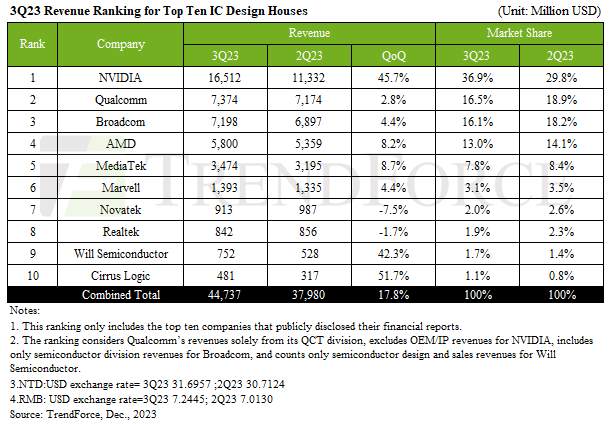
Qualcomm’s Q3 revenues rose 2.8% to $7.4 billion but Nvidia’s success trimmed Qualcomm’s market share to 16.5%. Broadcom’s Q3 revenues grew 4.4% to $7.2 billion.
AMD’s Q3 revenue grew 8.2% to $5.8 billion. . MediaTek’s Q3 revenue rose by 8.7% to $3.5 billion as smartphone stocks were replenished.
Marvell’s Q3 revenues were up 4.4% at $1.4 billion. Novatek and Realtek saw revenues decline by 7.5% and 1.7% respectively.
Jayce
/include/upload/kind/image/20231221/20231221181147_0919.png
Q3 revenues for the fabless top ten rose 17.8% q-o-q to $44.7 billion.
Nvidia’s Q3 revenue rose 45.7% to $16.5 billion. Cirrus Logic grew 51.7% to $481 million take the No.10 slot driven by smartphone stockpiling demand. Will Semico
2023/12/21 18:12:26
2023/12/21 18:12:26
76
0
501
6
Has the US Chips Act Been A Success?
Has the US Chips Act been successful in increasing investment in semiconductor wafer fabs in the U.S? asks Semiconductor Intelligence.
SI’s answer is the table below of major U.S. fab projects announced in the last few years.
The total near term investment is $142 billion. Most of these projects were announced before the passage of the Chips Act.
However, these companies likely expected future U.S. government subsidies. The subsidies listed in the table are from state and local governments. The organization Good Jobs First tracks government financial assistance to business.

Would these fabs have been built in the U.S. without the expectation of U.S. government assistance? Let’s look at each company.
TSMC – the largest semiconductor wafer foundry, based in Taiwan. TSMC has six current 300mm wafer fabs. All are based in Taiwan except for one in Nanjing, China.
TSMC’s third quarter 2023 report shows 69% of its revenue came from companies based in North America (primarily the U.S.). TSMC has been facing pressure from both the U.S. government and its U.S. customers to build a fab in the U.S.
This pressure combined with the hope of U.S. government funding most likely drove its decision to build a fab in Arizona. TSMC is reportedly seeking about $15 billion in funding through the CHIPS Act. TSMC is also planning an $11 billion wafer fab in Dresden, Germany in a joint venture with Bosch, Infineon and NXP.
The German government planned to contribute about 5 billion Euros ($5.4 billion) towards the fab. However, a recent court ruling places the German subsidies in doubt.
Texas Instruments – TI currently has 300mm wafer fabs located in Dallas, Texas; Richardson, Texas; and Lehi, Utah.
The Lehi fab was purchased from Micron Technology and converted by TI to produce analogue ICs. TI in the past has located fabs in Europe and Asia, but in the last several years has only build fabs in the U.S. TI’s proposed fabs in Sherman, Texas are about a one-hour drive from TI’s headquarters.
TI has had operations in Sherman for over 50 years. The city, school district, and county will provide about $2.4 billion in subsidies for the Sherman fabs, primarily through tax breaks.
Any money TI receives through the CHIPS Act will be a bonus. However, it is likely TI would have built its new fabs in Sherman without the CHIPS Act.
Samsung – Most of Samsung’s fabs are in South Korea. Samsung built a fab in Austin, Texas which opened in 1996. The Austin fab operates as a wafer foundry.
Samsung’s announced fab in Taylor, Texas – about 45 minutes from Austin – will also be a wafer foundry. The company will continue to make major fab investments in South Korea with $230 billion planned over the next 20 years, primarily for memory fabs.
Samsung will receive about $1.2 billion in local subsidies from Taylor area governments. The proximity to its Austin fab and the local incentives were most likely the primary drivers for Samsungs Taylor fab.
Funds from the CHIPS Act were probably also a factor, but Samsung presumably would have built the fab in Taylor without CHIPS money.
Intel – Intel has major U.S. fabs in Chandler, Arizona; Hillsboro, Oregon; and Rio Rancho, New Mexico. It also has fabs in Leixlip, Ireland; Jerusalem, Israel; and Kiryat Gat, Israel.
Intel is building a new fab in Kiryat Gat with about $3 billion in Israeli government subsidies. The company also plans a fab in Magdeburg, Germany with about $11 billion in German government aid. However, as with TSMC, the German funding is uncertain.
Intel will receive about $2.4 billion in local aid for its fab in New Albany, Ohio. Intel announced the Ohio fab in January 2022 – before the CHIPS Act was passed but when passage appeared likely. Intel has shown a willingness to locate fabs outside of the U.S. for the right incentives. The CHIPS funds were certainly a major factor in deciding on the Ohio location.
Micron Technology – Micron has fabs in Boise, Idaho; Taichung, Taiwan; Hiroshima, Japan; and Singapore.
The foreign fabs were all procured through Micron business acquisitions: Rexchip Electronics in Japan, Intotera Memories in Taiwan, and Texas Instruments’ memory business in Singapore. Micron plans to expand its fabs in Taiwan and Japan.
The Japanese government will subsidize Micron’s new Hiroshima fab with about $1.3 billion. Micron will build new fabs in Boise, Idaho and Clay, New York over the next several years. Micron will receive about $6.4 billion in state and local incentives for its New York fabs.
The new fabs will produce DRAMs, which Micron currently makes only in Taiwan and Japan. Micron’s strategy is to eventually produce 40% of its DRAMs in the U.S. The new U.S. fabs were announced in September and October of 2022, well after the passage of the CHIPS Act.
Since Micron has shown a willingness to expand its overseas fabs, the CHIPS funds were undoubtedly a major factor in deciding on its Idaho and New York fabs.
In summary, was the CHIPS Act a deciding factor in locating these new fabs in the U.S.? Asks SI.
We say yes for TSMC and probably for Micron and Intel, answers SI. TI and Samsung would likely have made their fab location decisions without the CHIPS Act. It remains to be seen how the CHIPS Act will affect future fab decisions.
Companies decide to build new fabs based on their anticipated capacity needs. Fab locations are based on many factors including proximity to company headquarters, infrastructure, workforce, political stability, customer proximity, and logistics.
Government subsidies may influence the country for the fab and the location within the country but are generally not the primary driving factor.
The SI June estimates for 2023 semiconductor capex were about $156 billion, down 14% from 2022. Most companies appear to be holding to their plans.
One exception is Intel, which we had estimated at $20 billion in 2023 CapEx. Through the third quarter of 2023, Intel capex was $19.1 billion, which means the full year will likely be around $24 billion.
The largest spender, TSMC, confirmed in October their 2023 capex target of $32 billion, down 12% from 2022.
Few companies have indicated their capex plans for 2024.
Micron ended its 2023 fiscal year in August with $7.0 billion in capex. Their guidance for fiscal 2024 capex was “slightly above” fiscal 2023.
Infineon’s fiscal year 2023 ended in September with 3 billion euro ($3.2 billion) in capex. Infineon plans to increase capex to 3.3 billion euro ($3.6 billion). The SI preliminary estimate for 2024 total capex is a 10% to 20% increase from 2023, in the range of $172 billion to $187 billion.
Jayce
/include/upload/kind/image/20231220/20231220173819_2741.jpg
Has the US Chips Act been successful in increasing investment in semiconductor wafer fabs in the U.S? asks Semiconductor Intelligence.
2023/12/20 17:40:15
2023/12/20 17:40:15
75
0
500
6
Predictions for 2024 – 3GPP and Ambient IoT
The next edition of the 3GPP 5G Advanced standard (Release 19) is expected to bring ambient IoT within 6G to increase connectivity from billions of devices to trillions.
Voting in December, the telecom companies and mobile operators that make up 3GPP membership will define what is to be in the latest standard.
“Ambient IoT will almost certainly be part of the release, the question is will it be a Study Item or a Work Item. We believe that Ambient IoT will be as big as the advent of the smartphone in terms of its impact on customers, businesses and society, and that it’s better to move forward incrementally and iteratively using the lessons learnt from deployment that have proven successful using other wireless technologies like Bluetooth ambient IoT,” said Steve Statler, CMO of Wiliot.
IoT has the potential to open up new revenue streams as well as help end consumers. Wiliot announced its IoT Pixels at MWC 2022. “While 5G tracked cars, appliances and shipping containers, 6G will track everything in those cars, appliances and shipping containers,” Statler said at the time. The IoT Pixels device can attach to any product and powers itself using recycled ambient energy waves to provide real time visibility in supply chains, monitor conditions (e.g., temperatures) and stock levels on a real time basis rather than daily updates for efficient deliveries.
Ambient IoT can be used to track the minutiae, such as food, clothing and medicine, rather than the expensive objects containing these individual assets. It uses low-cost, ubiquitous radios and does not rely on manual scanning but automatically senses the things nearby and automates the connectivity rather than relying on handheld scanners, explained Statler. Radios in phones, cars, appliances and other equipment will be upgraded to provide the energy and read the signals from the battery-free postage stamp sized smart tags. “Ambient IoT connections are the tendons connecting the bones of the real world to the computing muscle in the cloud,” he added.
Jayce
/include/upload/kind/image/20231219/20231219175514_1452.jpg
The next edition of the 3GPP 5G Advanced standard (Release 19) is expected to bring ambient IoT within 6G to increase connectivity from billions of devices to trillions.
Voting in December, the telecom companies and mobile operators th
2023/12/19 17:55:50
2023/12/19 17:55:50
72
0
499
6
Data Centre Capex to Grow 11% in 2024
Data centre capex is forecast to grow 11% in 2024 as select hyperscale cloud service providers return to an expansion cycle and the spending freeze in the enterprise markets thaws, says Dell’Oro..
“Worldwide data centre capex is projected for only a 4% growth in 2023,” says Dell’Oro’s Baron Fung, “ the slowdown in general-purpose server and storage deployments weighed down the market despite increased AI-related investments. While Microsoft, Google, and Oracle have increased their data centre investments in 2023 year-to-date, other cloud service providers such as Amazon and Meta have trimmed their data centre capex.”
“Our outlook for 2024 is more optimistic,” added Fung, “AI applications such as generative AI will be a key investment driver in the cloud and enterprise. Furthermore, we anticipate demand for general-purpose servers to recover following a prolonged correction, and as customers make a transition to new server platforms that enable more efficient computing.”
Server and storage system revenue is forecast for growth greater than 20 percent in 2024, while network and physical infrastructure revenues grows single digits.
Dell led all OEMs in server revenue in 3Q 2023, followed by IEI Systems (formerly Inspur) and HPE. White box server vendors gained 8 points of revenue share year-over-year compared to the OEMs.
The hyperscale cloud service providers are forecast to increase their data centre capex by 13 percent in 2024
Jayce
/include/upload/kind/image/20231218/20231218174128_1585.jpg
Data centre capex is forecast to grow 11% in 2024 as select hyperscale cloud service providers return to an expansion cycle and the spending freeze in the enterprise markets thaws, says Dell’Oro..
“Worldwide data centre capex
2023/12/18 17:41:57
2023/12/18 17:41:57
73
0
498
5
Flyking Weekly Industry Express
Jayce
/include/upload/kind/image/20231218/20231218173448_0707.jpg
2023/12/18 17:35:08
2023/12/18 17:35:08
90
0
497
6
Taiwan and Korea Foundry Share to Shrink
The share of the foundry industry now held by Taiwan and Korea will shrinkto 41% and 10% respectively by 2027, says TrendForce.
Currently Taiwan holds approximately 46% of global semiconductor foundry capacity, followed by China (26%), South Korea (12%), the US (6%), and Japan (2%).
In advanced manufacturing processes (including 16/14nm and more advanced technologies), Taiwan leads with a 68% global capacity share in 2023, followed by the US (12%), South Korea (11%), and China (8%).
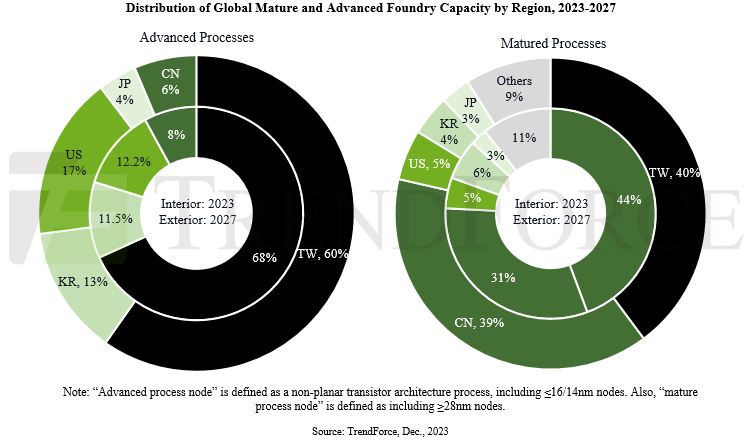
Taiwan holds nearly 80% share when it comes to EUV generation processes (such as 7nm and beyond).
While the US’s share of advanced process capacity is expected to increase to 17% by 2027, TSMC and Samsung will still account for over half of this capacity as they ramp up their US production sites.
China is focusing aggressively on mature process technologies (28nm and older). By 2027, China’s share in mature process capacity is expected to reach 39%, with room for further growth if equipment procurement proceeds smoothly.
As Chinese manufacturers rapidly expand their mature process capacities—backed by government subsidies—this could lead to intense price competition in products like CIS, DDI, PMIC, and power discrete, impacting Taiwan-based foundries like UMC, PSMC, and Vanguard.
Vanguard is expected to be most affected due to its product line including LDDI, SDDI, PMIC, and power discrete. Other companies like UMC and PSMC will maintain their advantages in the 28/22nm OLED DDI and memory sectors.
In response to chip shortages and geopolitical influences, fabless customers are diversifying risk by working with multiple foundries, potentially leading to increased IC costs and concerns over duplicate orders.
Customers are also requiring global validation of production lines, even with long-term foundry partners, to enable flexible capacity adjustments.
Jayce
/include/upload/kind/image/20231215/20231215182403_9529.png
The share of the foundry industry now held by Taiwan and Korea will shrinkto 41% and 10% respectively by 2027, says TrendForce.
Currently Taiwan holds approximately 46% of global semiconductor foundry capacity, followed by China (26%
2023/12/15 18:24:49
2023/12/15 18:24:49
95
0
496
6
Q4 Smartphone Shipments to Be Up 10%+ Sequentially
Snartphone shipments will grow more than 10% q-o-q and 2% y-o-y reaching over 300 million units, says Digitimes Research.
The sequential increase is driven primarily by Apple’s iPhone shipments.
Demand for smartphones has started recovering in emerging markets, such as Southeast Asia, Latin America, and Africa, in the latter half of the third quarter of 2023.
Global smartphone shipments for the third quarter of 2023 totaled nearly 275 million units, narrowing the annual decline to 0.6%.
2023 smartphone shipments for 2023 are forecast at 1.1043 billion units.
In the Chinese market, Q3 shipments have slightly increased to 61.3 million units, with a year-on-year growth rate of 5%.
Outside of China, due to the recovery in demand from emerging countries, shipments have been revised upward to 213.5 million units, narrowing the annual decline to 2.1%.
2023 5G smartphone shipments are forecast to be 571.5 million units, representing a 2.9% decline from 2022.
Jayce
/include/upload/kind/image/20231214/20231214181726_7699.png
Snartphone shipments will grow more than 10% q-o-q and 2% y-o-y reaching over 300 million units, says Digitimes Research.
The sequential increase is driven primarily by Apple’s iPhone shipments.
Demand for smartphones
2023/12/14 18:17:31
2023/12/14 18:17:31
67
0
495
6
Q3 Wearables Out-Ship Pre-Pandemic Volumes
Q3 wearables shipments grew 2.6% y-o-y at 148.4 million units, according to the (IDC) Worldwide Quarterly Wearable Device Tracker which out-shipped 3Q21 (142.1 million) and 3Q22 (144.6 million) when sales were driven by pandemic-related spending.
The growth is largely attributed to the rise of smaller brands and emerging categories.
“Health and fitness tracking has come a long way since the original Fitbits and Pebble watches but the greatest driver of wearables has been the emergence of smaller and sleeker designs,” saisvIDC’s Jitesh Ubrani, “smart rings from newer brands such as Oura, Noise, BoAT, Circular and others are expected to jumpstart the new form factor in the coming quarters.”
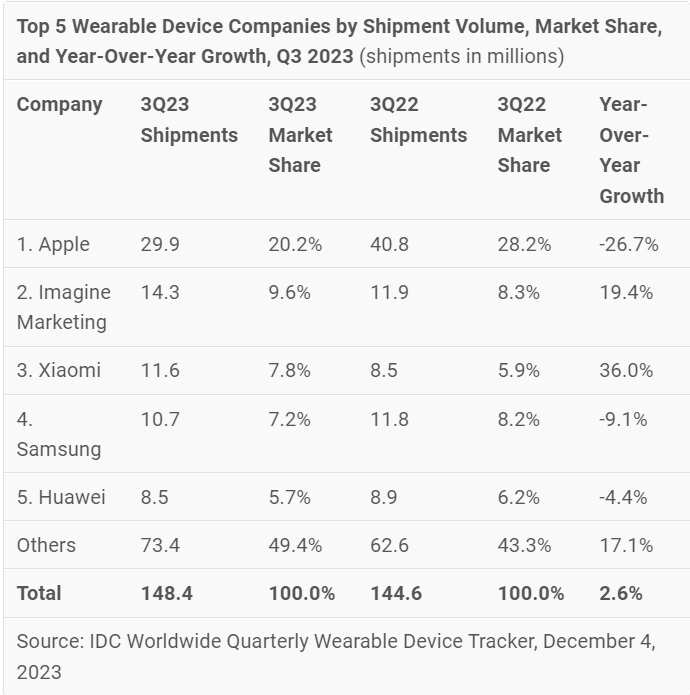

Jayce
/include/upload/kind/image/20231213/20231213181305_6662.png
Q3 wearables shipments grew 2.6% y-o-y at 148.4 million units, according to the (IDC) Worldwide Quarterly Wearable Device Tracker which out-shipped 3Q21 (142.1 million) and 3Q22 (144.6 million) when sales were driven by pandemic-relate
2023/12/13 18:13:06
2023/12/13 18:13:06
83
0
494
6
2023 Sales of Semi Manufacturing Equipment Down 6.1% Y-o-Y
Sales of total semiconductor manufacturing equipment by original equipment manufacturers are forecast to reach $100 billion in 2023, a contraction of 6.1% from the industry record of $107.4 billion posted in 2022, SEMI announced today in its Year-End Total Semiconductor Equipment Forecast – OEM Perspective at SEMICON Japan 2023.
Semiconductor manufacturing equipment growth is expected to resume in 2024, with sales forecast to reach a new high of $124 billion in 2025, supported by both the front-end and back-end segments.
“We anticipate a temporary contraction in 2023 due to the cyclical nature of the semiconductor market,” sai Ajit Manocha, SEMI President and CEO. “2024 will be a transition year. We then expect a strong rebound in 2025, driven by capacity expansion, new fab projects, and high demand for advanced technologies and solutions across the front-end and back-end segments.
After registering a record $94 billion in sales last year, the wafer fab equipment segment, which includes wafer processing, fab facilities and mask/reticle equipment, is projected to slip 3.7% to $90.6 billion in 2023.
This contraction marks a significant improvement from the 18.8% decline forecast by SEMI in its Mid-Year Total Semiconductor Equipment Forecast – OEM Perspective. The upward revision is primarily due to strong equipment spending by China.
Wafer fab equipment segment sales are projected to grow at a modest 3% in 2024 from the revised 2023 base due to limited memory capacity addition and the pause of mature capacity expansion.
A growth path with a further 18% expansion in 2025 is expected as new fab projects, capacity expansion and technology migrations drive investments to nearly $110 billion.
The decline in back-end equipment segment sales started in 2022 and continued in 2023 due to challenging macroeconomic conditions and softening semiconductor demand.
Semiconductor test equipment market sales are projected to contract by 15.9% to $6.3 billion in 2023, while assembly and packaging equipment sales are expected to drop by 31% to $4.0 billion in the same year.
The test equipment and assembly and packaging equipment segments are forecast to expand by 13.9% and 24.3%, respectively, next year.
Back-end segment growth is expected to continue in 2025, with test equipment sales rising 17% and assembly and packaging sales increasing 20%.
Equipment sales for foundry and logic applications, accounting for more than half of total wafer fab equipment receipts, are expected to log a 6% increase year-over-year to $56.3 billion in 2023 despite softer end-market conditions.
The application segment is forecast to contract 2% in 2024 as mature technology expansion slows and spending on leading-edge technology improves.
Foundry and logic equipment investments are projected to increase 15% in 2025 to $63.3 billion, driven by increased capacity expansion purchases and the introduction of new device architectures.
As anticipated, memory-related capital expenditures will see the sharpest decline in 2023.
NAND equipment sales are predicted to drop by 49% to $8.8 billion in 2023 but will surge 21% to $10.7 billion in 2024 and rise another 51% to $16.2 billion in 2025.
DRAM equipment sales are expected to remain stable, growing by 1% and 3% in 2023 and 2024, respectively.
Supported by continuous technology migration and expanding demand for high-bandwidth memory (HBM), DRAM equipment segment sales are expected to increase an additional 20% to $15.5 billion in 2025.
China, Taiwan and Korea are expected to remain the top three destinations for equipment spending through 2025.
China is projected to maintain the top position over the forecast period as the region’s equipment billings continue to soar. Equipment shipments to China are projected to surpass a record $30 billion in 2023, widening its lead with other regions.
While equipment spending for most tracked regions is expected to fall in 2023 before resuming growth in 2024, China is expected to see a mild contraction in 2024 after heavy investments in 2023.
The following results reflect market size by segment and application in billions of U.S. dollars:
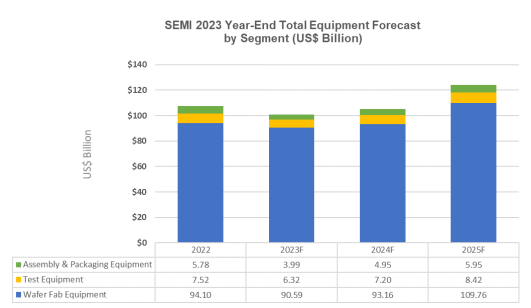

Source: SEMI December 2023, Equipment Market Data Subscription
* Total equipment includes new wafer fab, test, and assembly and packaging. Total equipment excludes wafer manufacturing equipment. Totals may not add due to rounding.
The SEMI forecast is based on collective input from top equipment suppliers, the SEMI Worldwide Semiconductor Equipment Market Statistics (WWSEMS) data collection program and the industry-recognized SEMI World Fab Forecast database.
Jayce
/include/upload/kind/image/20231212/20231212185344_7457.png
Sales of total semiconductor manufacturing equipment by original equipment manufacturers are forecast to reach $100 billion in 2023, a contraction of 6.1% from the industry record of $107.4 billion posted in 2022, SEMI announced today in its Year-E
2023/12/12 18:56:08
2023/12/12 18:56:08
75
0
493
6
Q3 Smartphone Production Rises 13% Q-o-Q; 6.4% Y-o-Y

Q4 is expected to see a further 5–10% QoQ increase in production.
The downturn in global smartphone production for 2023 is expected to be limited to less than 3%, with total annual output estimated to reach approximately 1.16 billion units.
Samsung continues to lead the market after recording an 11.5% increase in its Q3 production at 60.1 million units – only 5 million more than apple.
Apple saw its Q3 production climb 17.9% to reach approximately 49.5 million units. However, it had a 1.5% YoY market share decline, with annual production at 2022 levels.
Huawei’s re-entry with its flagship phones is anticipated to significantly impact Apple’s production performance in the upcoming year.
Xiaomi (including Xiaomi, Redmi, and POCO) saw Q3 production jump by 22.3% to approximately 42.8 million units.
Oppo (including Oppo, Realme, and OnePlus) experienced a 15.2% increase in its Q3 output to 38.7 million units.
Transsion (including TECNO, Infinix, and itel) produced 26.5 million units—a 5.6% increase QoQ.
Vivo (including Vivo and iQoo) saw its Q3 production rise to 24.5 million units, marking a 6.5% increase and placing it in the sixth spot.
Jayce
/include/upload/kind/image/20231211/20231211175611_5054.png
Q4 is expected to see a further 5–10% QoQ increase in production.
The downturn in global smartphone production for 2023 is expected to be limited to less than 3%, with total annual output estimated to reach a
2023/12/11 17:56:48
2023/12/11 17:56:48
70
0
492
5
Flyking Weekly Industry Express
Jayce
/include/upload/kind/image/20231211/20231211175224_0728.jpg
2023/12/11 17:52:55
2023/12/11 17:52:55
87
0
491
6
October Semi Sales Up 3.9% Q-o-Q
October semiconductor sales of $46.6 billion were up 3.9% on the $44.9 billion of September but 0.7% less than the October 2022 total of $46.9 billion, says the SIA.
A WSTS industry forecast projects 2023 sales will decrease 9.4% y-o-y in 2023 but increase 13.1% in 2024.
The forecast puts 2023 sales at $520 billion in 2023, down from the 2022 sales total of $574.1 billion.
In 2024, sales are projected to reach $588.4 billion.
“The global semiconductor market grew on a month-to-month basis for the eighth consecutive time in October, demonstrating clear, positive momentum for chip demand as 2023 winds down,” says SIA CEO John Neuffer, “moving forward, we forecast year-end sales for 2023 will be down compared to 2022, but the global semiconductor market is projected to rebound strongly next year with double-digit growth projected for 2024.”
Regionally, month-to-month sales increased in China (6.1%), Asia Pacific/All Other (4.9%), the Americas (2.9%), Japan (0.6%) and Europe (0.2%). Year-to-year sales were up in Europe (6.6%) and Asia Pacific/All other (0.4%), but down in the Americas (-1.6%), China (-2.5%), and Japan (-3.1%).
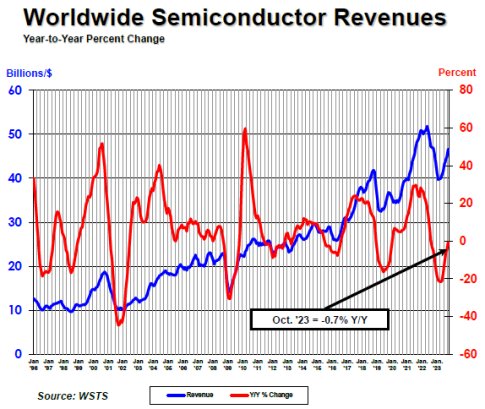

Jayce
/include/upload/kind/image/20231208/20231208171514_1505.png
October semiconductor sales of $46.6 billion were up 3.9% on the $44.9 billion of September but 0.7% less than the October 2022 total of $46.9 billion, says the SIA.
2023/12/8 17:16:12
2023/12/8 17:16:12
74
0
490
6
7.9% Q3 Growth for Top 10 Foundries
The top ten foundries grew revenues 7.9% to $28.29 billion, and Q4 revenues could grow faster, reports TrendForce.

TSMC, with 58% market share, grew Q3 revenue by 10.2%—reaching $17.25 billion. The 3nm process alone contributed 6% to TSMC’s Q3 revenue, with advanced processes (≤7nm) accounting for nearly 60% of its total revenue.
Samsung grew foundry revenue by 14.1% to $3.69 billion in Q3, driven by orders for Qualcomm’s mid-to-low range 5G AP SoC, 5G modems, and mature 28 nm OLED DDI processes.
GlobalFoundries maintained a stable performance in Q3, with its revenue approximating $1.85 billion, similar to the previous quarter.
UMC’s Q3 revenue declined 1.7% to $1.8 billion. Revenue from its 28/22 nm products saw a near 10% increase, representing 32% of UMC’s total revenue.
SMIC had a 3.8% Q3 revenue increase to $1.62 billion. However, the revenue share from American clients decreased to 12.9%. Conversely, revenue from Chinese clients increased to 84% due to the government’s localisation initiatives and urgent orders for smartphone components.
Notable changes in the rankings from sixth to tenth position include VIS and IFS, with the latter entering the global top ten for the first time since Intel’s financial restructuring.
VIS’ Q3 revenue increased by 3.8% to $333 million—surpassing PSMC to take the eighth position.
IFS had a 34.1% increase in revenue to approximately $311 million.
HuaHong saw a 9.3% decrease in Q3 revenue to about $766 million.
HHGrace maintained steady wafer shipment levels from the previous quarter, but a roughly 10% decrease in ASP led to a decline in revenue.
Tower Semiconductor saw stable demand in the smartphone, automotive, and industrial sectors, maintaining revenue at around $358 million in Q3.
PSMC witnessed a 7.5% drop in revenue to $305 million, with PMIC and Power Discrete revenues declining nearly 10% and 20%, respectively, impacting overall performance.
Jayce
/include/upload/kind/image/20231207/20231207183755_7181.png
The top ten foundries grew revenues 7.9% to $28.29 billion, and Q4 revenues could grow faster, reports TrendForce.
TSMC, with 58% market share, grew Q3 revenue by 10.2%—reaching $17.25 billion. The 3nm process alone contribut
2023/12/7 18:39:18
2023/12/7 18:39:18
70
0
489
6
Semi Sales to Grow 16.8% Next Year
2024 semiconductor sales are projected to grow 16.8% in 2024 to total $624 billion, according to Gartner after a 2023 market which is forecast to decline 10.9% to $534 billion.
“We are at the end of 2023 and strong demand for chips to support artificial intelligence (AI) workloads, such as graphics processing units (GPUs), is not going to be enough to save the semiconductor industry from double-digit decline in 2023,” says Gartner vp Alan Priestley, VP“Reduced demand from smartphones and PC customers coupled with weakness in data center/hyperscaler spending are influencing the decline in revenue this year.”
However, 2024 is forecast to be a bounce-back year where revenue for all chip types will grow (see Figure 1), driven by double-digit growth in the memory market.
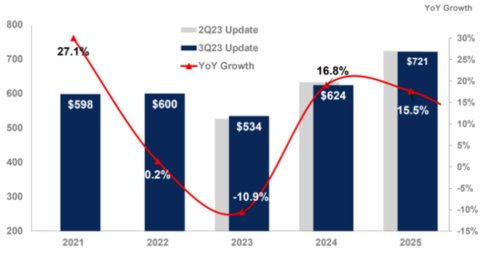
Figure 1. Semiconductors Revenue Forecast, Worldwide, 2021-2025 (Billions of U.S. Dollars)
Source: Gartner (December 2023)
The worldwide memory market is forecast to record a 38.8% decline in 2023 and will rebound in 2024 by growing 66.3%.
Anaemic demand and declining pricing due to massive oversupply will lead NAND flash revenue to decline 38.8% and fall to $35.4 billion in revenue in 2023.
Over the next 3-6 months, NAND industry pricing will hit bottom, and conditions will improve for vendors. Gartner analysts forecast a robust recovery in 2024, with revenue growing to $53 billion, up 49.6% year-over-year.
Due to high oversupply level and lack of demand, DRAM vendors are chasing the market price down to reduce inventory.
Through the fourth quarter of 2023, DRAM market’s oversupply will continue which will trigger a pricing rebound. However, the full effect of pricing increases will only be seen in 2024, when DRAM revenue is expected to increase 88% to total $87.4 billion.
Developments in generative AI (GenAI) and large language modelsare driving demand for deployment of high-performance GPU-based servers and accelerator cards in data centers. This is creating a need for workload accelerators to be deployed in data center servers to support both training and inference of AI workloads.
Gartner analysts estimate that by 2027, the integration of AI techniques into data center applications will result in more than 20% of new servers including workload accelerators.
Jayce
/include/upload/kind/image/20231205/20231205174107_9488.jpg
2024 semiconductor sales are projected to grow 16.8% in 2024 to total $624 billion, according to Gartner after a 2023 market which is forecast to decline 10.9% to $534 billion.
“We are at the end of 2023 and strong demand for chips
2023/12/5 17:42:16
2023/12/5 17:42:16
83
0
488
6
ECSN: cautious optimism for 2024
Last year, Aubrey Dunford, the ECSN (Electronic Components Supply Network) market analyst declared the UK electronics components market had returned to normality. At this year’s Electronics Components Forecast, he reclassified its status as a new, new normal.
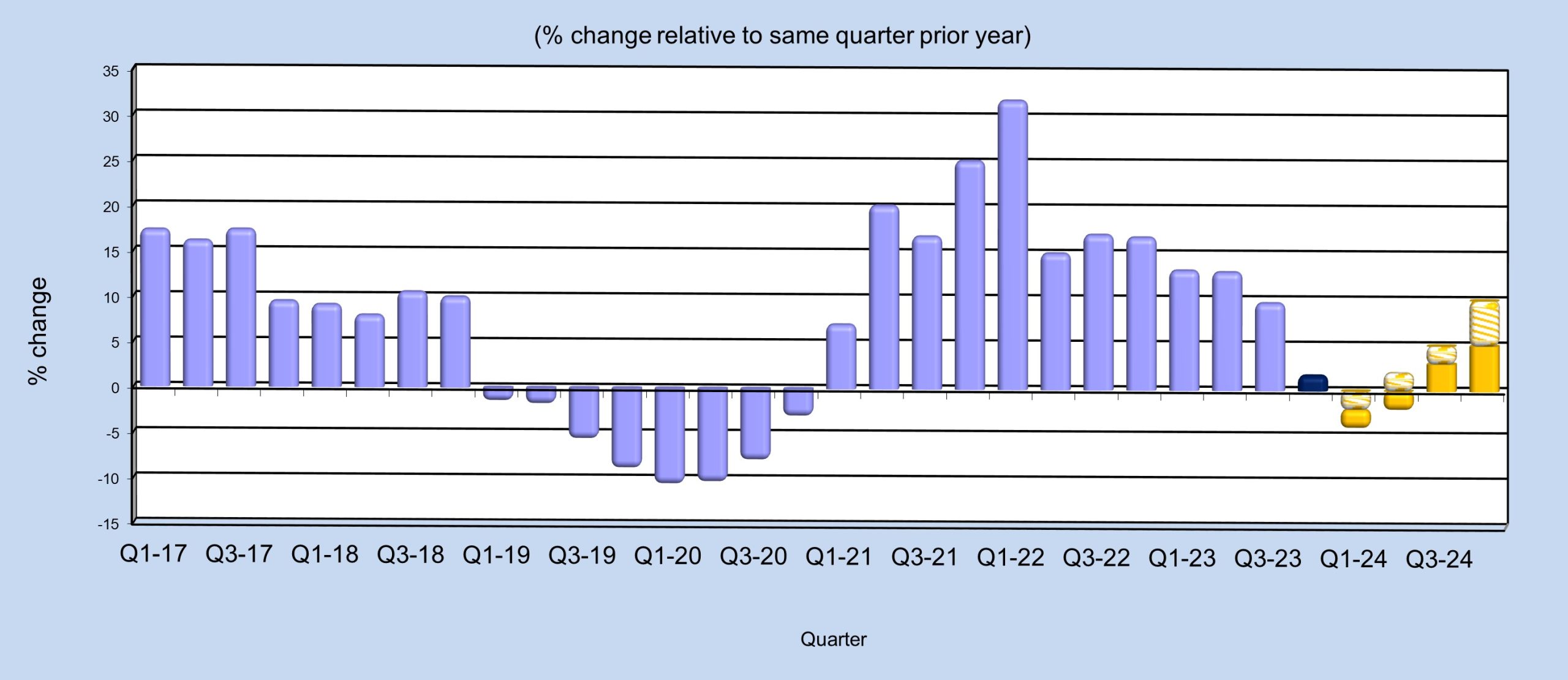
2024 total forecast 1.6% (min) to 4.1% (max)
At the end of 2022, ECSN suppliers were preparing for 2023 with strong order books and confidence in customer demand and an expectation that prices will generally be maintained. Another prediction for 2023 was that growth in the first half of this year was likely but the second half would be less certain as pent-up demand for 5G and smart vehicle infrastructure systems could bear fruit. The book-to-bill ratio was expected to remain strong in 2023 as lead times returned to more normal levels albeit with some shortages expected. All of this came to pass despite uncertainties such as product availability, global trade and political tensions and falling consumer confidence. At the time, Dunford maintained that authorised distributors are “key to helping the industry find its way through uncertainties”.
Component market sales in 2023 were high with a DTAM of £1886m and a TAM of £4254m, compared to £1722 (DTAM) and £3938m (TAM) in 2022.
For 2024, ECSN members are cautious, based on many statistics. Firstly, inventory is still high, making it difficult to judge demand. Price pressures will be minimal and price levels achieved in 2023 are expected to be maintained. A flat first half is expected, supported by the HM Treasury’s comparison of independent forecasts predicts UK economy average growth of 0.5% for 2023 and 0.4% for 2024. The second half of the year will depend on trade and political tensions, with the added unrest in the Middle East and what effect that will have, not least in terms of oil price rises.
There is still a demand for 5G and vehicle infrastructure systems and some strong demand particularly in the industrial sector as UK manufacturing output rises. There are indications that some market sectors will remain strong, said Dunford, but the overall picture is uncertain. A growth in UK consumption may not be reflected in sales in 2024. It is important to note, said Dunford that manufacturers do not know how much stock is out there, as double ordering of inventory through the pandemic is still to be worked through. The DTAM quarter-on-quarter growth since 2021 is related to price increases in a commodity market rather than increased unit sales, he added.
The one seeming certainty is moderate growth in the first half of 2024, said Dunford, followed by a slight to moderate (~1.4% growth), he estimated.
Jayce
/include/upload/kind/image/20231204/20231204171652_2573.jpg
Last year, Aubrey Dunford, the ECSN (Electronic Components Supply Network) market analyst declared the UK electronics components market had returned to normality. At this year’s Electronics Components Forecast, he reclassified its status as a new,
2023/12/4 17:18:00
2023/12/4 17:18:00
86
0
487
5
Flyking Weekly Industry Express
Jayce
/include/upload/kind/image/20231204/20231204171222_1522.jpg
2023/12/4 17:13:39
2023/12/4 17:13:39
104
0
486
6
Q4 Return to Growth for Smartphone Market
Q4 smartphone shipments will see 7.3% y-o-y growth, says IDC. “The tide has finally turned, ” says IDC’s Nabila Popal.
The market recovery will continue in 2024 with 3.8% growth expected, followed by low single-digit growth for 2022-27 for a 1.4% five-year CAGR.
For the whole of 2023, smartphone shipments are forecast to decline 3.5% y-o-y to 1.16 billion units.
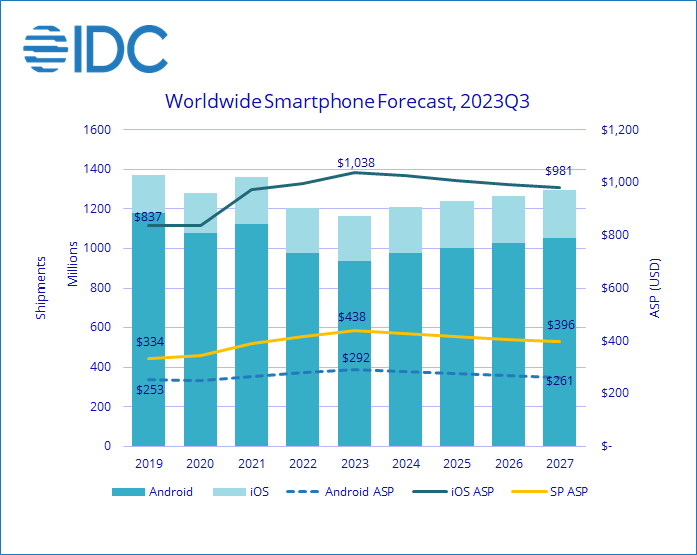
Smartphone ASP is expected to rise 5.5% in 2023 to $438, marking a fourth consecutive year of growth as the premium market continues to grow across all regions.
However, ASP growth is expected to taper off and gradually decline to $396 by 2027, which remains higher than prior forecasts.
iOS market share grew 0.6% growth in Q3, achieving a record share of 19.6% this year, while Android is forecast to decline 4.4%.
Over the long term, Android will grow slightly faster than iOS, increasing its share of the market to 81.3% by the end of the forecast period.
Jayce
/include/upload/kind/image/20231201/20231201180729_5707.png
Q4 smartphone shipments will see 7.3% y-o-y growth, says IDC. “The tide has finally turned, ” says IDC’s Nabila Popal.
The market recovery will continue in 2024 with 3.8% growth expected, followed by low single-digit growth for 2022
2023/12/1 18:08:39
2023/12/1 18:08:39
85
0
485
6
iPhone Assembly Shifting to India
Foxconn is expected to increase its Indian production of iPhones from 12-14% in 2023 to 20-25% in 2024.
Earlier this week the company filed a securities notice in Taiwan that it would build a plant costing $1.54 billion at an unnamed location in India, reported The Nikkei.
According to reports in the Taiwan press, the plant will be used for iPhone production.
It was also reported that the Indian plant would be used for iPhone product development and test production.
Currently 90% of iPhone assembly is done in China and Foxconn accounts for 60-70% of iPhone assembly.
Foxconn has been assembling iPhones in India since 2019 at Sunguvarchatram but it has been a less profitable operation than at its assembly plants in China because of higher material costs and a higher percentage of defective phones.
Jayce
/include/upload/kind/image/20231130/20231130190038_2423.jpg
Foxconn is expected to increase its Indian production of iPhones from 12-14% in 2023 to 20-25% in 2024.
Earlier this week the company filed a securities notice in Taiwan that it would build a plant costing $1.54 billion at an unnamed
2023/11/30 19:01:00
2023/11/30 19:01:00
98
0
484
6
European tech funding dropping but better than elsewhere
Tech investment in Europe will amount to about $45 billion this year compared to $82 billion last year, says a report from Atomico.
Worst hit will be companies at the growth stage requiring late-stage capital injections to scale up.
But Europe is the only region where investment has risen from 2020 levels – by 18% – whereas the US expected figure of $120 billion is a 1% drop from 2020 and the figures for China and RoW are expected to drop by 7% and 8%, respectively.

Investment in European late-stage tech startups has almost dried up as the IPO market makes exits unappealing.
Looking at funds which invest in both public and private companies – so-called cross-over funds – Atomico found only four such investments this year compared with 82 in 2021.
Over the past 12 months, raising capital was the most frequently cited challenge by founders and senior startup leaders, with 38% saying it was their biggest challenge. Securing customers was next on the list of anxieties, with 37% saying it was their biggest challenge.
Founders aren’t particularly bullish for 2024 — 41% said raising capital would be one of their biggest challenges and 44% said securing customers would be

While the rate that founders are starting new companies has fallen 30% since its peak in 2020, there are more new first-time founders in Europe than there are in the US.

Jayce
/include/upload/kind/image/20231129/20231129182254_9854.png
Tech investment in Europe will amount to about $45 billion this year compared to $82 billion last year, says a report from Atomico.
Worst hit will be companies at the growth stage requiring late-stage capital injections to scale up.
2023/11/29 18:23:01
2023/11/29 18:23:01
92
0
483
6
Single-Crystal Material for Electrolytes in Solid State Batteries
Koike of Japan and the Japan National Institute of Advanced Industrial Science and Technology (AIST) have come up with a single-crystal material that could be used as an electrolyte in solid-state batteries.
The company will soon begin sampling battery manufacturers, with production envisaged in 2027/28.
When used for a battery electrolyte the new material material is claimed to reduce electrical resistance by nine-tenths.
To prevent degradation, a liquid is applied to the electrodes, making the battery a type of “semisolid-state” battery that uses both solids and liquids.
Used in such a battery in a pacemaker, the material could extend pacemakers’ battery life from 10-15 to 50 years.
Koike makes monocrystalline wafers and has developed monocrystals with a diameter of 25mm for batteries.
Jayce
/include/upload/kind/image/20231127/20231127174542_4254.jpg
Koike of Japan and the Japan National Institute of Advanced Industrial Science and Technology (AIST) have come up with a single-crystal material that could be used as an electrolyte in solid-state batteries.
The company will soon beg
2023/11/27 17:45:50
2023/11/27 17:45:50
99
0
482
5
Flyking Weekly Industry Express
Jayce
/include/upload/kind/image/20231127/20231127173524_0354.jpg
2023/11/27 17:35:57
2023/11/27 17:35:57
157
0
481
5
Cultivating a Culture of Thanks at Flyking Technology
Thanksgiving at Flyking Technology isn't just a date on the calendar; it's a vibrant culture that resonates deeply within our core values every single day.
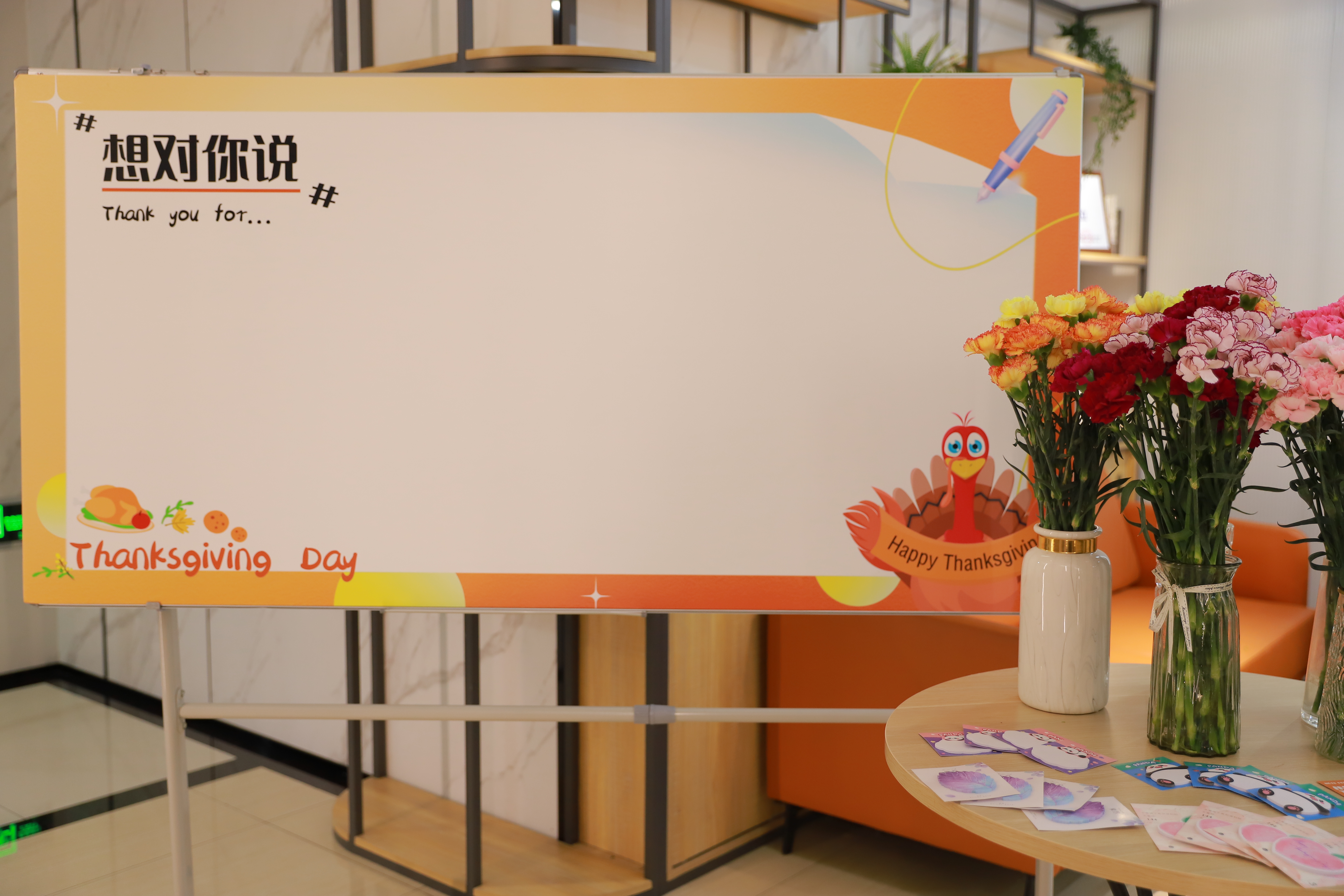
On the 23rd of Nov., we held a big afternoon tea celebration that wasn't merely a gesture of gratitude from Flyking but a testament to embedding this culture within our entire community. This event was a heartfelt expression of our appreciation for our exceptional team, esteemed clients, and invaluable suppliers. Their unyielding support remains the cornerstone of our success, and this was our moment to acknowledge and honor their unwavering commitment.

During our "Words to You" segment, the atmosphere was electric with heartfelt sentiments. It was a space where everyone, from colleagues to companions, from mentors to partners, bravely voiced their gratitude. It was an affirmation of the interconnectedness that defines our Flyking family, a moment that epitomized our culture of thanks.
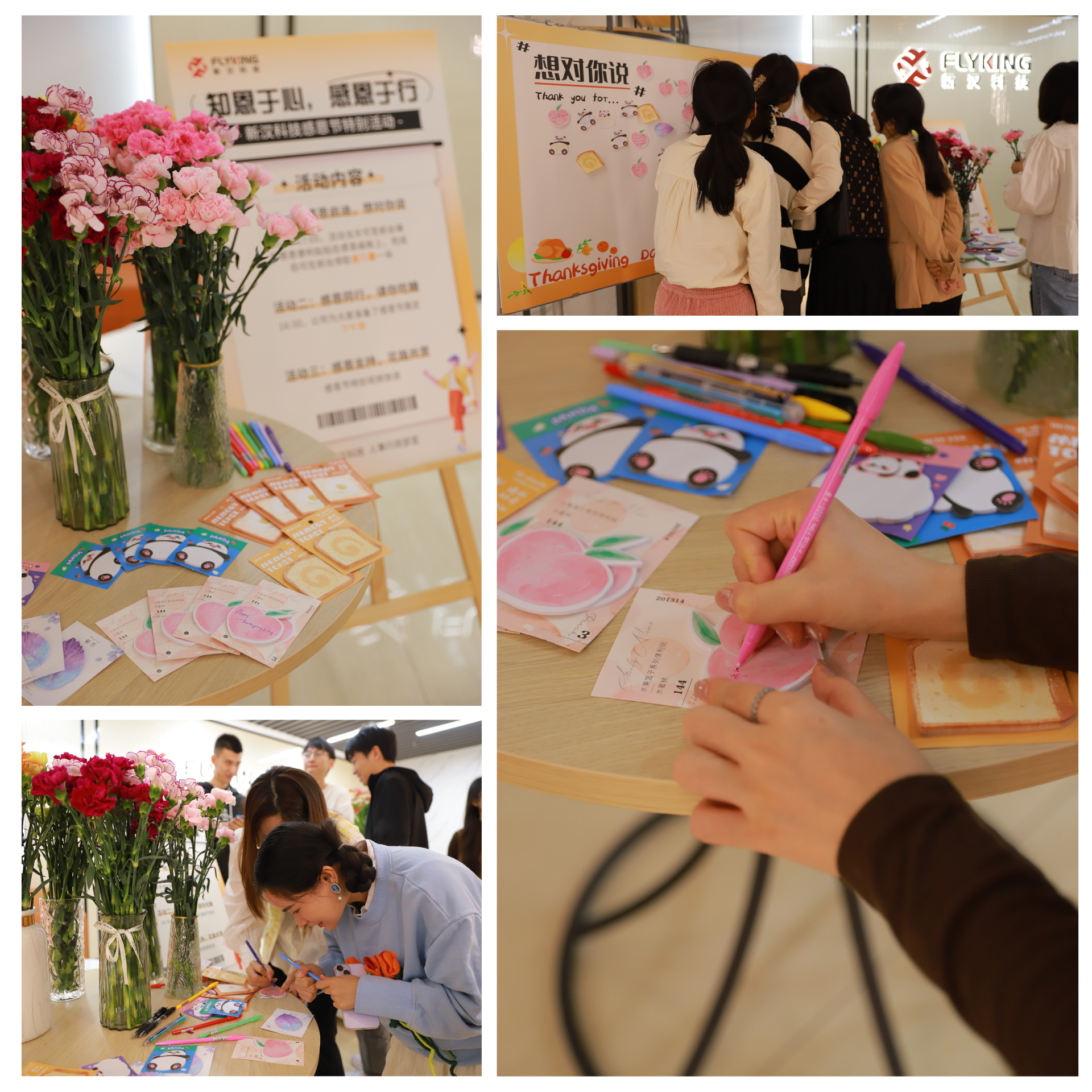
Furthermore, our executives underscored this spirit through a poignant Thanksgiving video. In it, we reaffirmed our commitment to translating gratitude into action. At Flyking, this means not just expressing thanks but embodying it - being responsible to our clients, nurturing a caring environment for our employees, and showcasing our appreciation through tangible deeds.
This Thanksgiving, as we reflect on our journey, we extend heartfelt thanks to every individual contributing to our success. Your dedication, trust, and partnership are the driving forces propelling us forward.
Thank you, everyone, for being part of our story. Here's to a Thanksgiving filled not just with festivity but with the warmth of cherished connections and the joy of shared gratitude!
Flyking Thanksgiving Special: https://youtu.be/DZ-wKS3d34c
Jayce
/include/upload/kind/image/20231123/20231123214346_4091.png
Thanksgiving at Flyking Technology isn't just a date on the calendar; it's a vibrant culture that resonates deeply within our core values every single day.
On the 23rd of Nov., we held a big afternoon tea celebration that
2023/11/23 21:43:50
2023/11/23 21:43:50
111
0
480
6
Smartphone Market Returns to Growth
Over the last eight quarters shipments have been:
The smartphone market turned up in October, says Counterpoint Research which is the first month it has grown y-o-y for two years. For Q3, Counterpoint is forecasting the first growth quarter for eight quarters.
October shipments grew 5% y-o-y which is the first month in 27 consecutive months since June 2021 to show y-o-y growth.
2021 Q4 371.4
2022: Q1 326.4 Q2 294.5 Q3 301.9 Q4 303.9
2023: Q1 280.2 Q2 268 with a forecast for Q3 of 299.8
Propelling October’s growth was a recovery in smartphone sales in the emerging markets – notably an upswing in the Middle East and Africa, a resurgence by Huawei in the China market and the arrival of the festive season in India.
“Following strong growth in October, we expect the market to grow year-on-year in the fourth quarter of 2023 as well, setting the market on the path to gradual recovery in the coming quarters,” the market research firm said.
For the full year, Counterpoint’s forecast is:
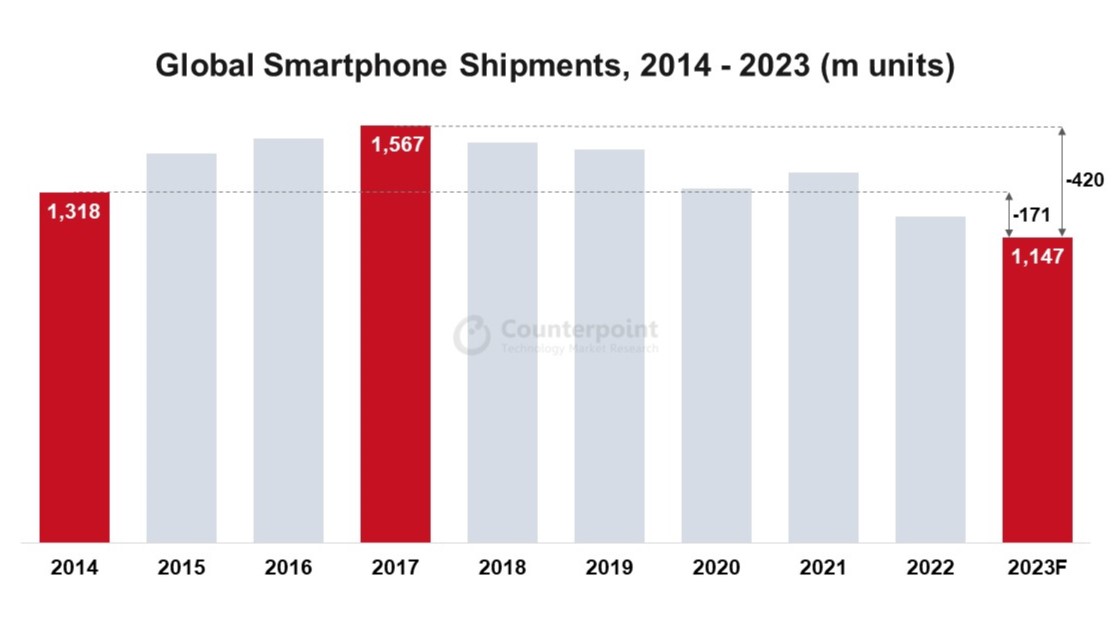
Jayce
/include/upload/kind/image/20231123/20231123171959_8559.jpg
Over the last eight quarters shipments have been:
The smartphone market turned up in October, says Counterpoint Research which is the first month it has grown y-o-y for two years. For Q3, Counterpoint is forecasting the first growth
2023/11/23 17:21:12
2023/11/23 17:21:12
80
0
479
6
Semis Down 12% This Year; Up 20% Next Year
Driving growth are: inventory depletion in PCs, smartphones, automotive and industrial; electrification in automotive and industrial; AI PCs and AI smartphones and rising memory ASPs.
Wafer capacity pricing is expected to remain flat next year as foundry suppliers gradually improve utilisation rates and demand returns from their core fabless customers.
CapEx is expected to improve by 2H24 as revenue shipments match end demand and regional ChipAct incentives stimulate investment across the supply chain.
By 2026, IDC expects that AI silicon will account for almost $200 billion in semiconductor revenues.”
Jayce
/include/upload/kind/image/20231120/20231120225140_1673.png
The 2023 semiconductor market will be worth $526 billion – down 12% from the $598 billion of 2022 – and the 2024 market will grow 20% to $633 billion, says IDC.
2023/11/20 22:51:59
2023/11/20 22:51:59
88
0
478
5
Flyking Weekly Industry Express
Jayce
/include/upload/kind/image/20231120/20231120133906_1124.jpg
2023/11/20 13:39:50
2023/11/20 13:39:50
110
0
477
6
Leti to hook up with LSTC on 1nm
“Leti and the LSTC wish to establish a long-term and sustainable collaboration in different advanced semiconductor fields, including materials, devices, processes, and technology,” says Leti, “the aim is to further strengthen global collaboration in the semiconductor industry over the next decade and to jointly define long-term R&D roadmaps.
Leti’s role will be in the development of new transistor structures for 1.4-1nm processes.
Rapidus is currently working with IBM and Imec on developing a 2nm process. Rapidus intends to have a 2nm pilot line running in April 2025 and a volume 2nm line in Hokkaido in 2027.
Jayce
/include/upload/kind/image/20231117/20231117173941_9892.jpeg
Leti is to join Japan’s Leading-Edge Semiconductor Technology Centre (LSTC) consisting of Tokyo University, Japan’s Riken Institute, various other Japanese universities and Rapidus, the Japanese startup aiming for a 2nm process, reports the Nikkei.
2023/11/17 17:39:57
2023/11/17 17:39:57
85
0
476
6
Infineon FY2023 Revenues Up 15% Y-o-Y
The company expects revenues of €17 billion at a 24.2% margin in 2024.
For FY 2023 to September 30, Infineon had revenues if €16.309 billion, up 15% on FY 2022 for a profit up 30% y-o-y at €4.399 billion with a margin of 27% and free cash flow of €1.158 billion.
Free Cash Flow adjusted for investment in frontend buildings and the acquisition of GaN Systems should be around €2.2 billion and reported Free Cash Flow around €400 million
For calendar Q4 (fiscal Q1) Infineon expects revenues of around €3.8 billion at a margin of 22%.
“In the 2023 fiscal year, Infineon has set new records for revenue and profitability. The results are an initial confirmation of our more ambitious course we embarked on as a company a year ago,” says Jochen Hanebeck, CEO of Infineon (pictured) “nevertheless, we find ourselves in an environment that continues to present challenges. We are seeing different trends in our target markets. Structural semiconductor growth in the areas of renewable energy, electromobility – especially in China – and microcontrollers for the automotive industry remains unabated. In contrast, consumer, communication, computing and IoT applications are experiencing a temporary period of low demand. Overall, we are expecting revenue growth to continue in the 2024 fiscal year but at a slower rate. We are reacting decisively to the market situation. At the same time, we are continuing to implement our strategy consistently with regard to structural growth opportunities and we are reinforcing our leading position in power systems and IoT with long-term investments.”
Jayce
/include/upload/kind/image/20231116/20231116180242_6771.png
Infineon had calendar Q3 (fiscal Q4) revenue of €4.149 billion for a profit of €1.044 billion at a margin of 25.2% with free cash flow of €614 million.
2023/11/16 18:02:51
2023/11/16 18:02:51
87
0
475
6
Sales of systems, chips and front-end IC manufacturing equipment up, but back-end down
Q4 sales of electronics are forecast to rise 22% q-o-q after a 7% rise in Q3, says SEMI, and IC sales are expected to rise 4% sequentially after improving 7% in Q3 2023 as end demand improves and inventories normalise
However, despite the improvement in electronics and IC sales, semiconductor manufacturing indicators remain soft. Fab utilization rates and capital expenditures continue to decline in the second half of this year.
Overall, CapEx on non-memory is expected to outperform memory in 2023, but even spending in the non-memory segments has begun to weaken.
Total capital expenditures in Q4 2023 are hovering at the levels seen in Q4 2020.

While overall semiconductor capital equipment sales are declining in line with capital expenditures, the contraction in wafer fab equipment spending has turned out to be much shallower than expected this year. Furthermore, back-end equipment billings are projected to increase in Q4 2023.
“While semiconductor markets have seen year-over-year declines the last five quarters, year-over-year growth is expected to return in the fourth quarter of 2023 as production cuts have worked their way through the supply chain,” says TechInsights’ Boris Metodiev, “on the other hand, front-end equipment sales have been performing much better than the IC market, buoyed by government incentives and the filling of backlogs, strength expected to continue next year.”
“Despite low fab utilisation rates and slowing capital expenditures in the second half of 2023, we expect back-end equipment billings to bottom in Q4 2023,” says SEMI’s Clark Tseng, “this will mark an important turnaround for the chip manufacturing industry, signaling a recovery from the downturn with building momentum in 2024.”
Jayce
/include/upload/kind/image/20231115/20231115175303_4015.jpg
Sales of electronics products, ICs and front-end manufacturing equipment are moving upwards, while the market for back-end manufacturing equipment remains weak, says SEMI.
2023/11/15 17:53:05
2023/11/15 17:53:05
78
0
474
6
TSMC October revenues up 34.8% q-o-q
TSMC had October revenues of $7.8 billion up 34.8% from the $5.6 billion revenues of September 2023 and an increase of 15.7% from the October 2022 revenues of $6.5 billion.
Revenue for January through October 2023 totalled $57.26 billion, a decrease of 3.7% compared to the $59 billion revenues for the same period in 2022.
TSMC October Revenue Report (Consolidated):
(Unit: NT$ million)

Jayce
/include/upload/kind/image/20231114/20231114174725_3703.jpg
TSMC had October revenues of $7.8 billion up 34.8% from the $5.6 billion revenues of September 2023 and an increase of 15.7% from the October 2022 revenues of $6.5 billion.
Revenue for January through October 2023 totalled $57.26
2023/11/14 17:48:12
2023/11/14 17:48:12
109
0
473
6
Vishay to acquire Nexperia’s Newport Wafer Fab for $177m
Discrete semiconductor and passive electronic component maker Vishay Intertechnology Inc of Malvern, PA, USA has agreed to acquire Newport Wafer Fab in South Wales, UK from Nexperia B.V. of Nijmegen, The Netherlands (a subsidiary of Wingtech Technology Co Ltd) for $177m in cash. ATREG Inc, the Seattle-based global firm for initiating, brokering and executing the exchange of semiconductor manufacturing assets, served as Nexperia’s transaction advisors.
Located on 28 acres and the largest semiconductor manufacturing plant in the UK, Newport is an automotive-certified, 200mm wafer fab that supplies primarily automotive markets.
“Under new leadership in early 2023, Vishay set an ambitious goal of investing approximately $1.2bn in capacity over a three-year period in order to position the company to seize the opportunities created by the megatrends of e-mobility and sustainability needed for a Net Zero economy,” says president & CEO Joel Smejkal. “While this transaction is supplemental to our capex investment strategy, adding Newport Wafer Fab to our manufacturing footprint will be instrumental to achieving our goal of expanding capacity for our customers and to accelerating our SiC [silicon carbide] strategy,” he adds.
“By agreeing to acquire Newport Wafer Fab, our goal is to safeguard the positions of the highly skilled and dedicated employees and to invest the necessary capital to set up production for our SiC trench MOSFETs and diodes. With its solid balance sheet and ample liquidity, Vishay will immediately bring stability and its reliable cash flow generation to ensure the facility becomes a fully operational and profitable fab” reckons Smejkal.
“For Vishay, acquiring Newport Wafer Fab brings together our capacity expansion plans for our customers in automotive and industrial end markets as well as the UK’s strategic goal of improved supply chain resilience. In addition to expanding capacity, we intend to collaborate with the Compound Semiconductor Cluster in South Wales and to join with key stakeholders committed to developing the semiconductor industry in the UK including university and community partners in the UK and particularly South Wales,” concludes Smejkal. “We look forward to welcoming Newport Wafer Fab’s employees into Vishay and to partnering with local authorities and the Welsh and UK Governments to both ensure long-term growth for the fab and deliver value to our customers and stockholders.”
“Vishay’s board made a critical decision last year to pivot the company toward profitable growth under new leadership, leveraging the company’s solid cash flow generation, sound operational capabilities and broad product portfolio,” notes executive chairman Marc Zandman. “A key element of this strategic shift is the investment in technologies and incremental capacity to position Vishay to capitalize on the megatrends in e-mobility and sustainability. Acquiring Newport Wafer Fab demonstrates Vishay’s commitment to executing this strategic shift,” he adds.
“Nexperia would have preferred to continue the long-term strategy it implemented when it acquired the investment-starved fab in 2021 and provided for massive investments in equipment and personnel,” says Toni Versluijs, country manager Nexperia UK. “However, these investment plans have been cut short by the unexpected and wrongful divestment order made by the UK Government in November 2022. The UK Government’s order, in combination with a weakness in the global semiconductor market, recently led us to announce the intention to reduce the number of employees at the site by at least 100. The site needs clarity about its future to avoid further losses,” he adds. “Of all options, this agreement with Vishay is the most viable one to secure the future of the site as Vishay – like Nexperia – has a solid customer base for the fab’s capabilities. For the site, Vishay’s commitment to further make the Newport Wafer Fab a success story is encouraging. Nexperia’s position with regards to the UK Government’s order remains unchanged.”
The closing of the Newport Wafer Fab transaction is subject to UK government review, the purchase rights of a third party, and customary closing conditions, and is expected to occur in first-quarter 2024.
Nexperia states that, while working to ensure that all conditions to the sale are met as soon as possible, it will continue to own and manage the site and support the employees.
Jayce
/include/upload/kind/image/20231113/20231113175418_8535.jpg
Discrete semiconductor and passive electronic component maker Vishay Intertechnology Inc of Malvern, PA, USA has agreed to acquire Newport Wafer Fab in South Wales, UK from Nexperia B.V. of Nijmegen, The Netherlands (a subsidiary of Wingtech Techno
2023/11/13 17:54:21
2023/11/13 17:54:21
81
0


